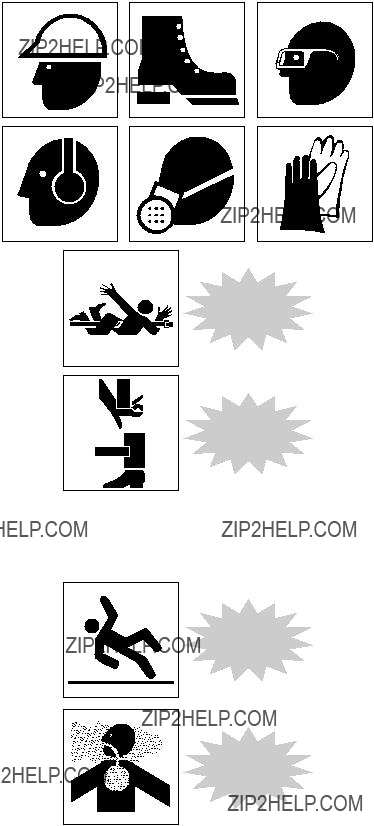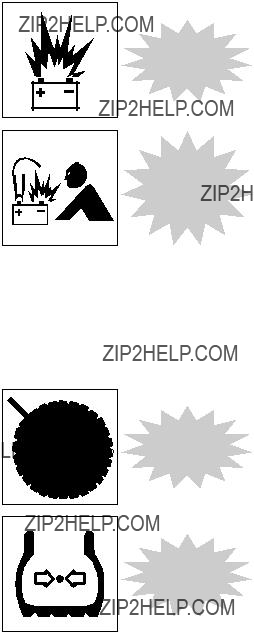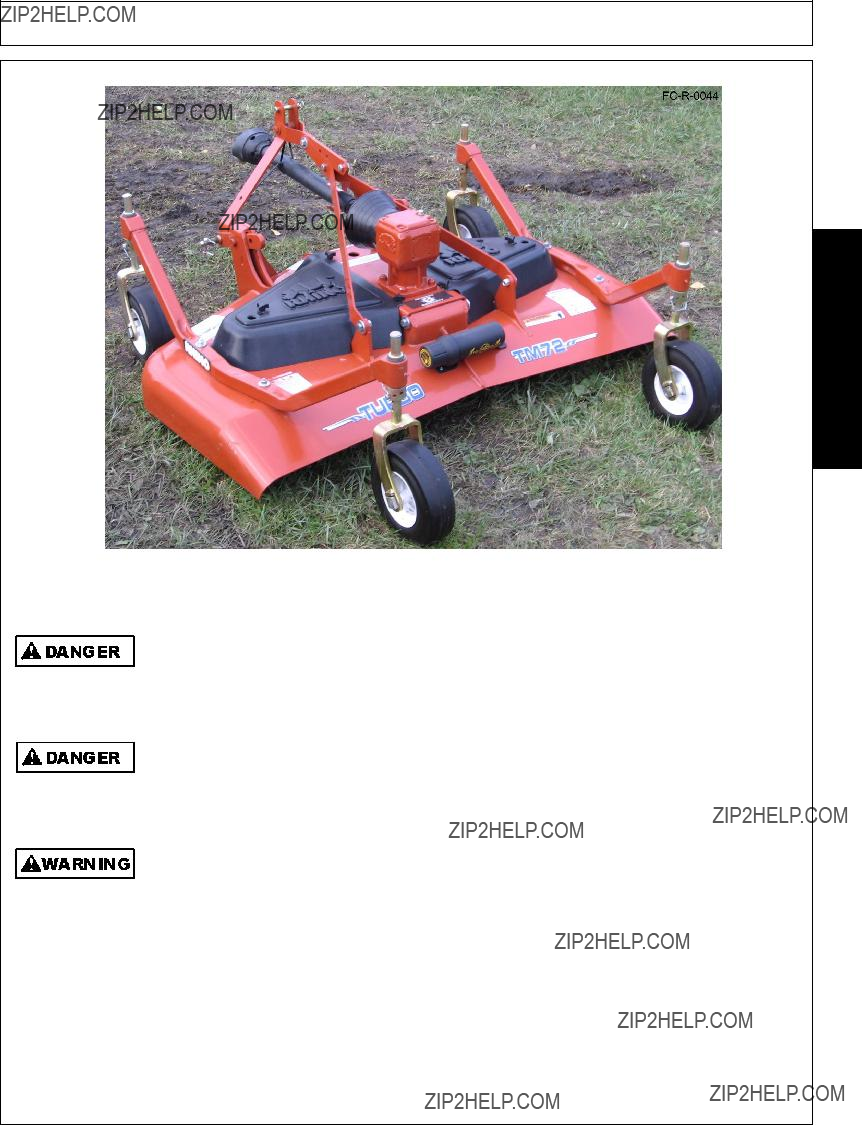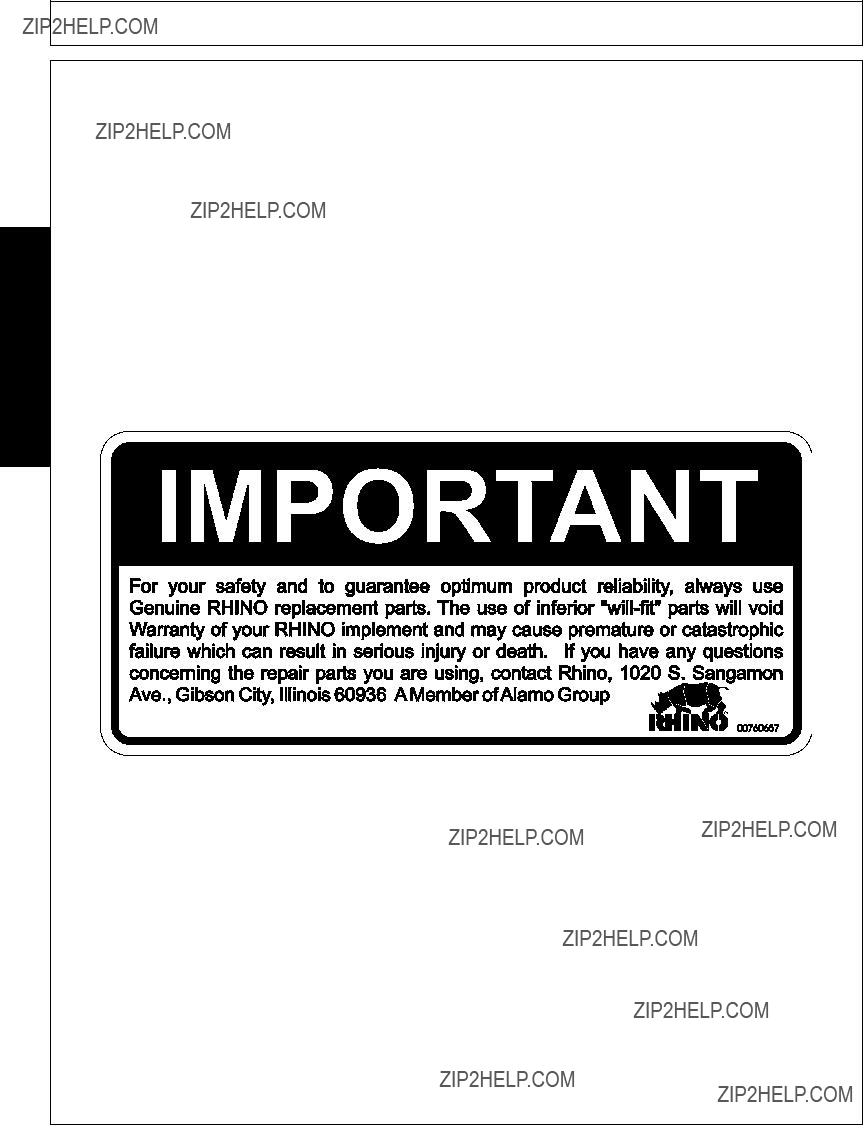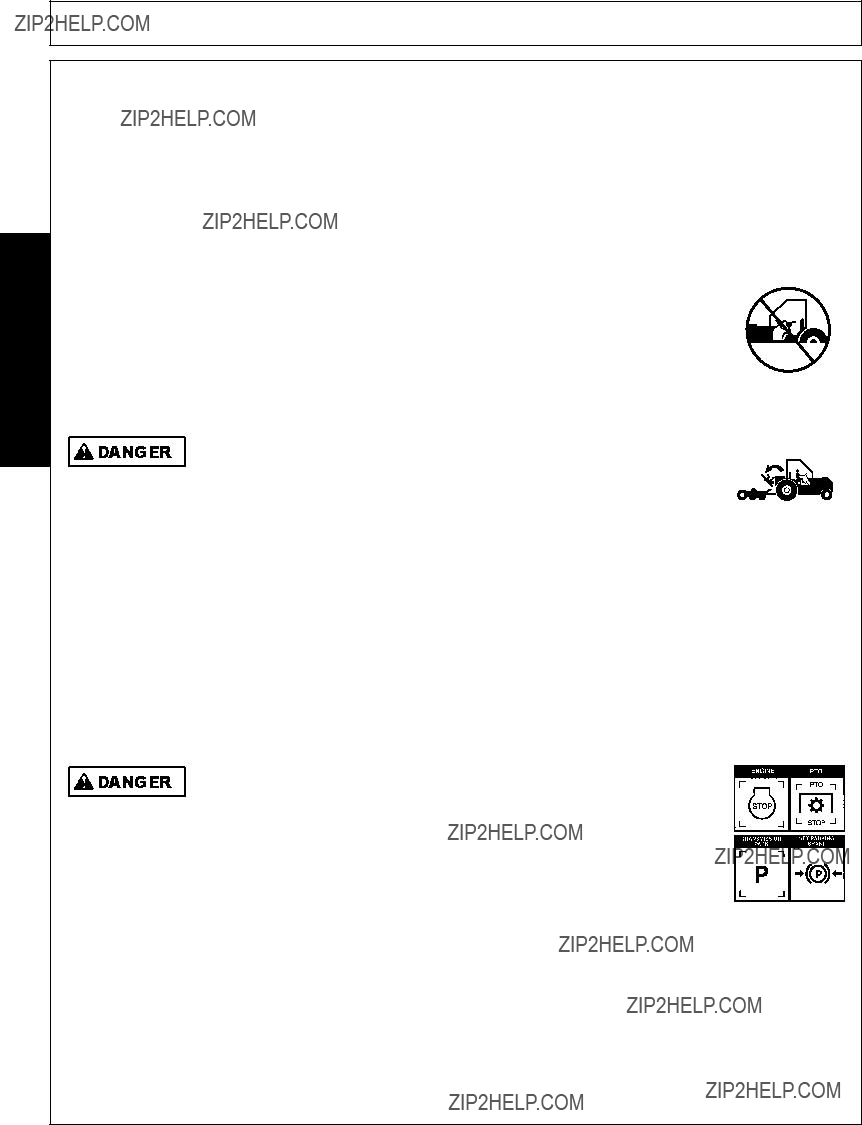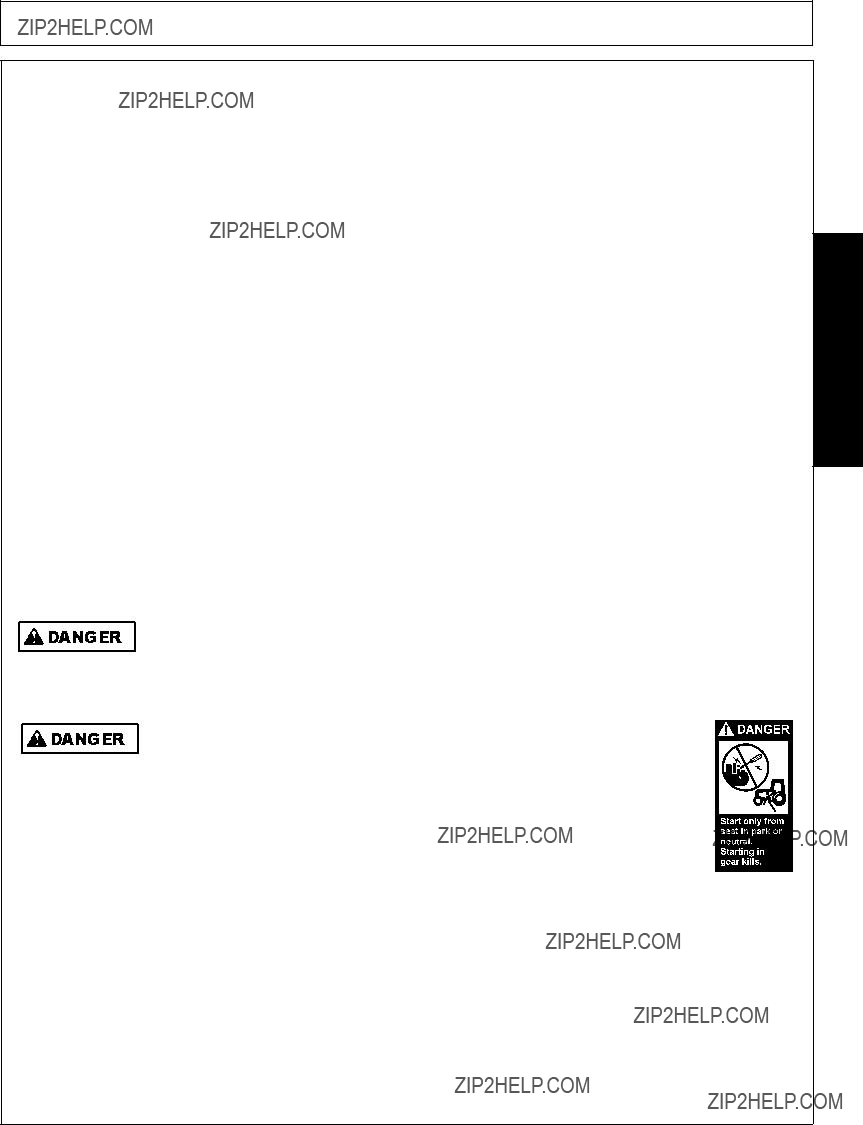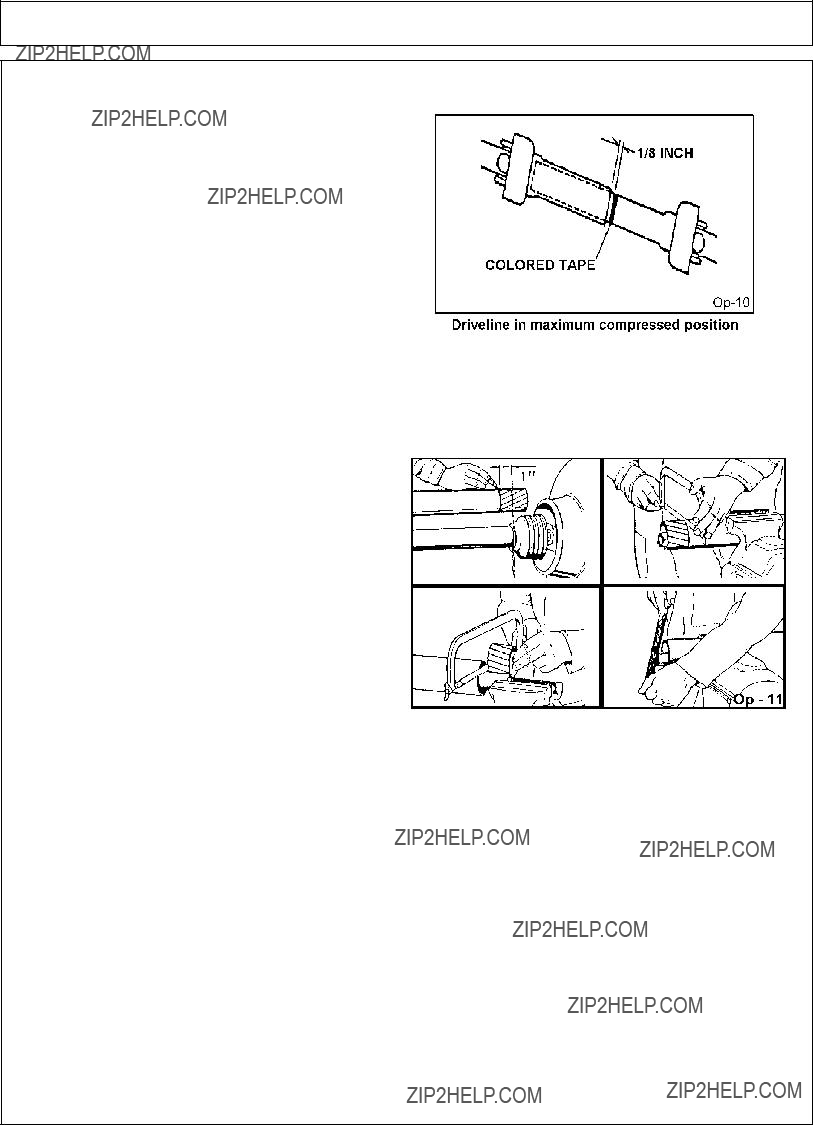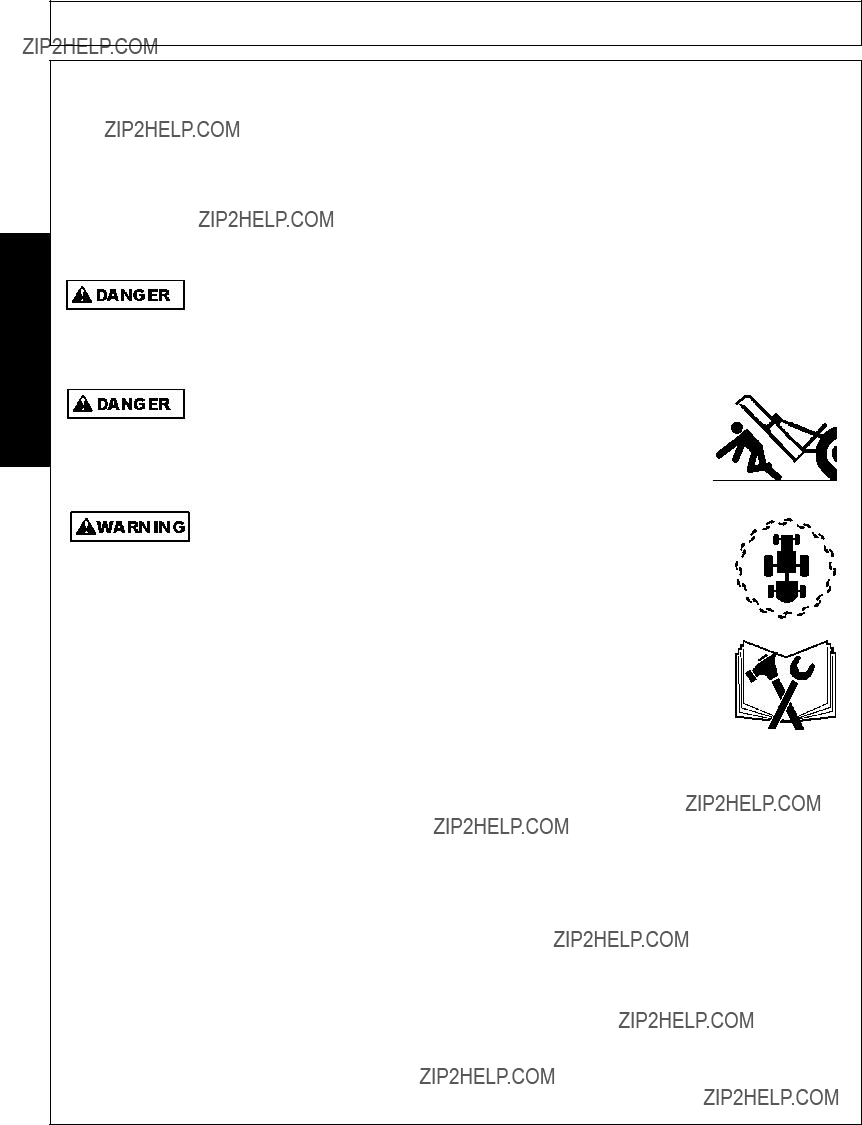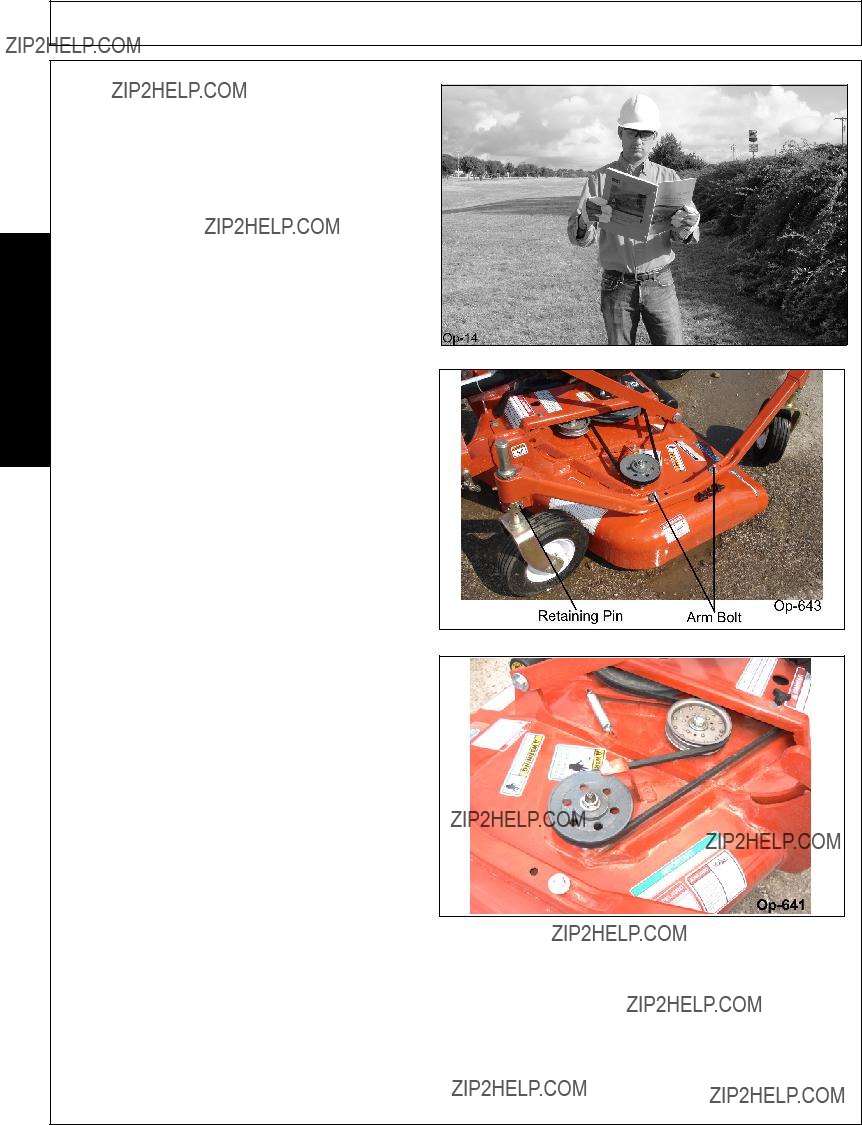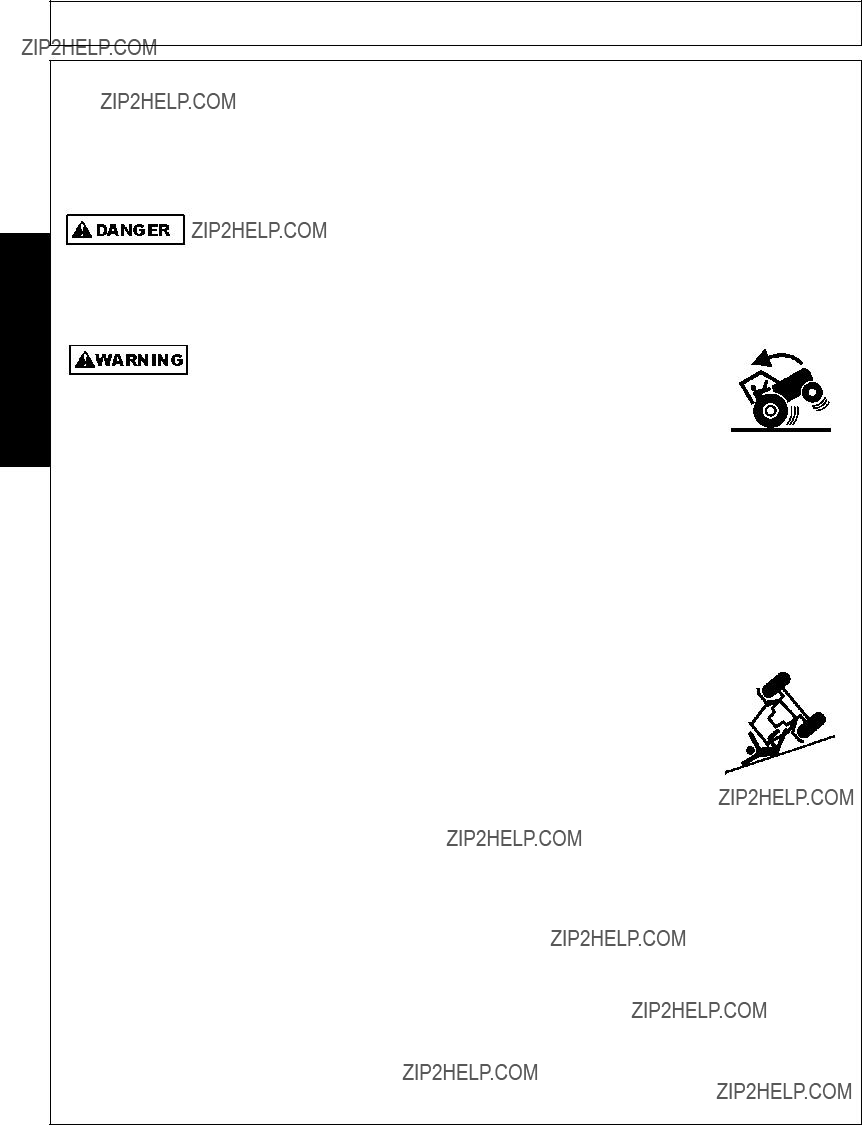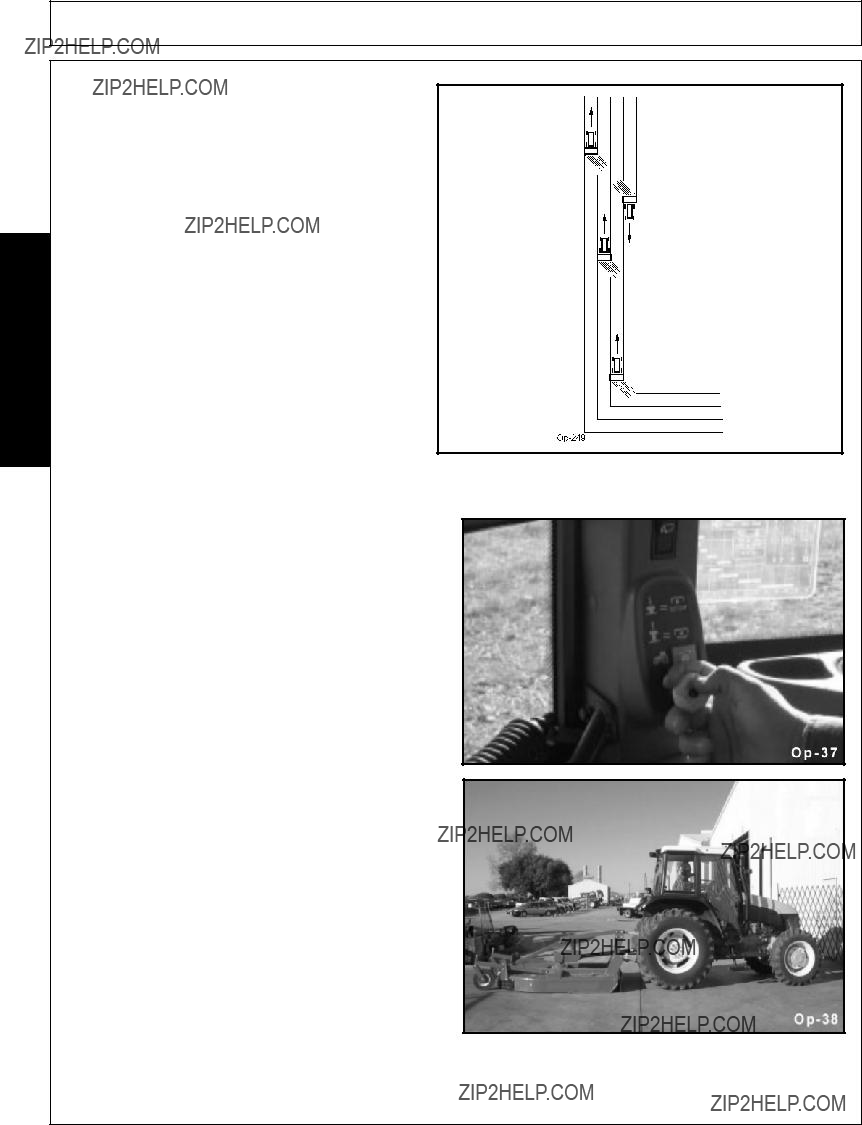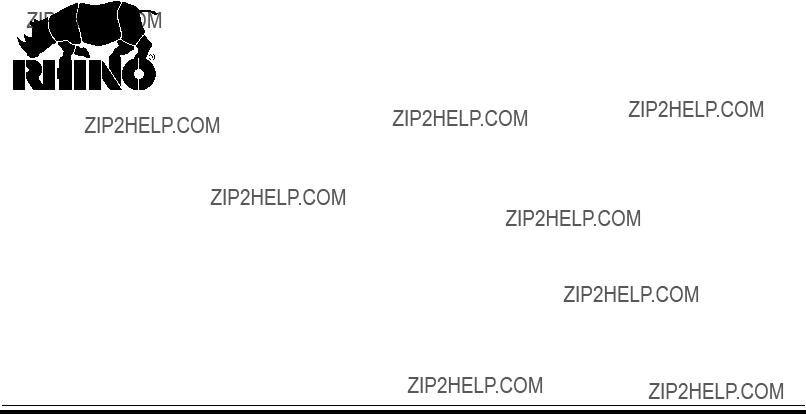This Operator's Manual is an integral part of the safe operation of this machine and must be maintained with the unit at all times. READ, UNDERSTAND, and FOLLOW the Safety and Operation Instructions contained in this manual before operating the equipment. C01- Cover
RHINO??
1020 S. Sangamon Ave.
Gibson City, IL 60936 800-446-5158
E-mail: parts@servis-rhino.com
To the Owner/Operator/Dealer
All implements with moving parts are potentially hazardous. There is no substitute for a cautious, safe-minded operator who recognizes the potential hazards and follows reasonable safety practices. The manufacturer has designed this implement to be used with all its safety equipment properly attached to minimize the chance of accidents.
BEFORE YOU START! Read the safety messages on the implement and shown in your manual. Observe the rules of safety and common sense!
WARRANTY INFORMATION:
Read and understand the complete Warranty Statement found in this Manual. Fill out the Warranty Registration Form in full and return it to within 30 Days. Make certain the Serial Number of the Machine is recorded on the Warranty Card and on the Warranty Form that you retain.
In order to reduce accidents and enhance the safe operation of mowers, Alamo Group Ag Division, in cooperation with other industry manufacturers has developed the AEM/FEMA Industrial and Agricultural Mower Safety Practices video and guide book.
The video will familiarize and instruct mower-tractor operators in safe practices when using industrial and agricultural mowing equipment. It is important that Every Mower Operator be educated in the operation of their mowing equipment and be able to recognize the potential hazards that can occur while operating a mower. This video, along with the mower operator???s manual and the warning messages on the mower, will significantly assist in this important education.
Your Authorized Rhino Dealer may have shown this video and presented you a DVD Video when you purchased your mower. If you or any mower operator have not seen this video, Watch the Video, Read this Operator???s Manual, and Complete the Video Guidebook before operating your new mower. If you do not understand any of the instructions included in the video or operator???s manual or if you have any questions concerning safety of operation, contact your supervisor, dealer or Alamo Group Ag.
If you would like a VHS video tape of the video, please email AEMVideo@alamo-group.com or Fax AEM VHS Video at (830) 372-9529 or mail in a completed copy of the form on the back of this page to AEM VHS Video 1502 E Walnut Street, Seguin, TX 78155. and request the VHS video version. Please include your name, mailing address, mower model and serial number.
Every operator should be trained for each piece of equipment (Tractor and Mower), understand the intended use and the potential hazards before operating the equipment.
The information and material listed above along with this Operator???s Manual can assist you in meeting the OSHA requirement for Operator annual training.
OSHA TRAINING REQUIREMENTS
The following training requirements have been taken from Title 29, Code of Federal Regulations Part 1928.57 (a)(6). www.osha.gov
Operator Instructions. At the time of initial assignment and at least annually thereafter, the employer shall instruct every employee who operates an agricultural tractor or implement in the safe operating practices and servicing of equipment with which they are or will be involved, and of any other practices dictated by the work environment.
AEM Mower Operator???s Safety Manual
Requester Name:_______________________________Phone:________________________________
Requester Address:___________________________________________
City:_________________________________________
State:________________________________________
Zip Code:____________________________________
Mower Model:__________________________Serial Number:___________________________
Date Purchased:________________________ Dealer Salesperson:________________________
Dealership Name:_______________________Dealership Location:_______________________
Mail to:
AEM Video Services
1502 E Walnut Street
Seguin, TX 78155
Or Fax to:
(830) 372-9529
Or E-mail to:
AEMVideo@alamo-group.com
SAFETY SECTION
Safety Section 1-1
?? 2011 Alamo Group Inc.
(SG-3)
(SG-2)
SAFETY
General Safety Instructions and Practices
A careful operator is the best operator. Safety is of primary importance to the manufacturer and should be to the owner/operator. Most accidents can be avoided by being aware of your equipment, your surroundings, and observing certain precautions. The first section of this manual includes a list of Safety Messages that, if followed, will help protect the operator and bystanders from injury or death. Read and understand these Safety Messages before assembling, operating or servicing this Implement. This equipment should only be operated by those persons who have read the manual, who are responsible and trained, and who know how to do so responsibly.
The Safety Alert Symbol combined with a Signal Word, as seen below, is used throughout this manual and on decals which are attached to the equipment. The Safety Alert Symbol means: ???ATTENTION! BECOME ALERT! YOUR SAFETY IS INVOLVED!??? The Symbol and Signal Word are intended to warn the owner/operator of impending hazards and the degree of possible injury faced when operating this equipment.
Practice all usual and customary safe working precautions and above all---remember safety is up to YOU. Only YOU can prevent serious injury or death from unsafe practices.
Indicates an imminently hazardous situation that, if not avoided, WILL result in DEATH OR
VERY SERIOUS INJURY.
Indicates an imminently hazardous situation that, if not avoided, COULD result in DEATH
OR SERIOUS INJURY.
Indicates an imminently hazardous situation that, if not avoided, MAY result in MINOR
INJURY.
Identifies special instructions or procedures that, if not strictly observed, could result in damage to, or destruction of the machine, attachments or the environment.
NOTE: Identifies points of particular interest for more efficient and convenient operation or repair.(SG-1)
READ, UNDERSTAND, and FOLLOW the following Safety Messages. Serious injury or death may occur unless care is taken to follow the warnings and instructions stated in the Safety Messages. Always use good common sense to avoid hazards.
Si no lee ingles, pida ayuda a alguien que si lo lea para que le traduzca las medidas de seguridad.
(SG-16)
(SG-31)
(SG-30)
SAFETY
Engine Exhaust, some of its constituents, and certain vehicle components contain or emit chemicals known to the state of California to cause cancer and birth defects or other reproductive harm.
Battery posts, terminals and related accessories contain lead and lead compounds, chemicals known to the state of California to cause cancer, birth defects or other reproductive harm.
Operator Safety Instructions and Practices
The rotating parts of this machine continue to rotate even after the PTO has been turned off.
The operator should remain in the operator???s seat for 60 seconds after the brake has been set, the PTO disengaged, the tractor turned off, and all evidence of rotation has ceased.
(S3PT-10)
???Wait a minute...Save a life!???
Never crawl under a raised Implement supported solely by the Tractor 3-Point hitch.
Release of the control lever or mechanical failure will result in the Implement falling and possible injury or death. Always securely block up the Implement before crawling underneath to perform repairs and service. (S3PT-19)
Never operate the Tractor or Implement until you have read and completely understand this Manual, the Tractor Operator???s Manual, and each of the Safety Messages found in the Manual or on the Tractor and Implement. Learn how to stop the tractor engine suddenly in an emergency. Never allow inexperienced or untrained personnel to operate the Tractor or Implement without supervision. Make sure the operator has fully read and understood the manuals prior to operation.
(SG-4)
The operator and all support personnel should wear hard hats, safety shoes, safety glasses, and proper hearing protection at all times for protection from injury including injury from items that may be thrown by the equipment.
(SG-32)
(SG-25)
(SG-24)
(SG-22)
(SG-I7)
SAFETY
PROLONGED EXPOSURE TO LOUD NOISE MAY CAUSE
PERMANENT HEARING LOSS! Tractors with or without an Implement attached can often be noisy enough to cause permanent hearing loss. We recommend that you always wear hearing protection if the noise in the Operator???s position exceeds 80db. Noise over 85db over an extended period of time will cause severe hearing loss. Noise over 90db adjacent to the Operator over an extended period of time will cause permanent or total hearing loss. NOTE: Hearing loss from loud noise [from tractors, chain saws, radios, and other such sources close to the ear] is cumulative over a lifetime without hope of natural recovery.
Always read carefully and comply fully with the manufacturer???s instructions when handling oil, solvents, cleansers, and any other chemical agent.
KEEP AWAY FROM ROTATING ELEMENTS to prevent entanglement and possible serious injury or death.
Never allow children to play on or around Tractor or Implement. Children can slip or fall off the Equipment and be injured or killed. Inadvertent contact with controls can cause the Implement to shift or fall crushing themselves or others.
DO NOT use drugs or alcohol immediately before or while operating the
Tractor and Implement. Drugs and alcohol will affect an operator???s alertness and coordination and therefore affect the operator???s ability to operate the equipment safely. Before operating the Tractor or Implement, an operator on prescription or over-the-counter medication must consult a medical professional regarding any side effects of the medication that would hinder their ability to operate the Equipment safely. NEVER knowingly allow anyone to operate this equipment when their alertness or coordination is impaired. Serious injury or death to the operator or others could result if the operator is under the influence of drugs or alcohol. (SG-27)
Prolonged operation may cause operator boredom and fatigue affecting safe operation.
Take scheduled work breaks to help prevent these potentially impaired operating conditions. Never operate the Implement and Tractor in a fatigued or bored mental state which impairs proper and safe operation.
(SGM-09)
(SG-42)
(SG-41)
(SG-38)
(SG-33)
SAFETY
Use extreme caution when getting onto the Implement to perform repairs, maintenance and when removing accumulated material. Only stand on solid flat surfaces to ensure good footing. Use a ladder or raised stand to access high spots which cannot be reached from ground level. Slipping and falling can cause serious injury or death.
DO NOT operate this Implement on a Tractor that is not properly maintained. Should a mechanical or Tractor control failure occur while operating, immediately shut down the Tractor and perform repairs before resuming operation. Serious injury and possible death could occur from not maintaining this Implement and Tractor in good operating condition.
(SG-36)
Avoid contact with hot surfaces of the engine or muffler. Use gloves and eye protection when servicing hot components. Contact with a hot surface or fluid can cause serious injury from burns or scalding.
Repeated or substantial breathing of hazardous dusts, including crystalline silica, could cause fatal or serious respiratory disease including silicosis. Concrete, masonry, many types of rock, and various other materials contain silica sand. California lists respirable crystalline silica as a substance known to cause cancer. Operation of this equipment under certain conditions may generate airborne dust particles that could contain crystalline silica. In those conditions, personal protective equipment including an appropriate respirator must be used. If excessive dust is generated, a dust collection or suppression system should also be used during operation.
For your protection while operating or servicing equipment, wear relatively tight and belted clothing to avoid entanglement in moving parts. Tie up and protect long hair that could become entangled in machinery. Remove all jewelry including necklaces, rings and watches which can get caught in machinery or on corners or edges of the equipment. Serious injury can result from entanglement with the machinery.
Do not put hands or feet under mower decks. Blade Contact can result in serious injury or even death. Stay away until all motion has stopped and the decks are securely blocked up.
(SFL-4)
(SBH-6)
(SSP-03)
(SPU-5)
SAFETY
Always keep a careful lookout and use extreme care when working around utility and municipal obstructions. Never allow the Mower to contact any utility, municipal, or other type structure. Clearly mark all mowing obstructions and consult local utility providers for a safe code of operation.
Do not operate the implement while wearing loose fitting clothing. Entanglement of the clothing with the rotating elements can result in serious injury or even death. Stay clear of all rotating elements at all times.
Equipment Operation Safety Instructions and Practices
Never leave the Tractor and Implement unattended while the Implement is in the lifted position. Accidental operation of lifting lever or a hydraulic failure may cause sudden drop of unit with injury or death by crushing. To properly park the implement when disconnecting it from the tractor, lower the stand and put the retaining pin securely in place, or put a secure support under the A-Frame. Lower the implement carefully to the ground. Do not put hands or feet under lifted components. (S3PT-1)
This Implement may be wider than the Tractor. Be careful when operating or transporting this equipment to prevent the Implement from running into or striking sign posts, guard rails, concrete abutments or other solid objects. Such an impact could cause the Implement and Tractor to pivot violently resulting in loss of steering control, serious injury, or even death. Never allow the Implement to contact obstacles. (S3PT-12)
Be sure you have adequate knowledge of the property you will be working on. Take time to make yourself aware of any area underground lines or cables. Contact with buried lines or cable could result in serious injury or death. If in doubt about buried utility lines call 811 before digging or 1-800-258-0808.
Do not operate Mower if excessive vibration exists. Shut down PTO and the Tractor engine. Inspect the Mower to determine the source of the vibration. If Mower blades are missing or damaged replace them immediately. Do not operate the mower until the blades have been replaced and the Mower operates smoothly. Operating the Mower with excessive vibration can result in component failure and broken objects to be thrown outward at very high velocities. To reduce the possibility of property damage, serious injury, or even death, never allow the Mower to be operated with blades missing.
(SG-7)
(SFM-3)
SAFETY
There are obvious and hidden potential hazards in the operation of this
Mower. REMEMBER! This machine is often operated in weeds and in heavy grass. The Blades of this Mower can throw objects if shields are not properly installed and maintained. Serious injury or even death may occur unless care is taken to insure the safety of the operator, bystanders, or passersby in the area. Do not operate this machine with anyone in the immediate area. Stop mowing if anyone is within 100 yards of mower. (SFM-1)
Rotary Mowers are capable under adverse conditions of throwing objects for great distances (100 yards or more) and causing serious injury or death. Follow safety messages carefully
STOP MOWING IF PASSERSBY ARE WITHIN 100 YARDS UNLESS:
-Mower Deck Shielding, and Discharge Deflector are installed and in good, working condition;
-Mower section is running close to and parallel with the ground without exposed Blades; -Passersby are outside the existing thrown-object zone;
-All areas have been thoroughly inspected and all foreign material such as rocks, cans, glass, and general debris has been removed.
NOTE: Where there are grass and weeds high enough to hide debris that could be struck
by the blades, the area should be: inspected and large debris removed, mowed at an intermediate height, inspected closely with any remaining debris being removed, and mowed again at desired final height. (This will also reduce power required to mow, reduce wear and tear on the Mower drivetrain, spread cut material better, reduce streaking, and make the final cut more uniform).
Operate this Equipment only with a Tractor equipped with an approved roll- over-protective system (ROPS). Always wear seat belts. Serious injury or even death could result from falling off the tractor--particularly during a turnover when the operator could be pinned under the ROPS.
BEFORE leaving the tractor seat lower the implement, set the parking brake and/or set the tractor transmission in parking gear, disengage the PTO, stop the engine, remove the key, and wait for all moving parts to stop. Place the tractor shift lever into a low range or parking gear to prevent the tractor from rolling. Never dismount a Tractor that is moving or while the engine is running. Operate the Tractor controls from the tractor seat only. (SG-9)
?? 2011 Alamo Group Inc.
(SG-26)
(SG-23)
(SG-15)
(SG-13)
(SG-12)
(SGM-11)
(SG-10)
SAFETY
Never allow children or other persons to ride on the Tractor or Implement.
Falling off can result in serious injury or death.
SAFETY

Do not mow with two machines in the same area except with Cab tractors with the windows closed.
Do not mount or dismount the Tractor while the tractor is moving. Mount the Tractor only when the Tractor and all moving parts are completelystopped.
Start tractor only when properly seated in the Tractor seat. Starting a tractor in gear can result in injury or death. Read the Tractor operators manual for proper starting instructions.
Do not operate this Equipment with hydraulic oil or fuel leaking. Oil and fuel are explosive and their presence could present a hazard. Do not check for leaks with your hand! High-pressure oil streams from breaks in the line could penetrate the skin and cause tissue damage including gangrene. To check for a hose leak, SHUT the unit ENGINE OFF and remove all hydraulic pressure. Wear oil impenetrable gloves, safety glasses and use Cardboard to check for evidence of oil leaks. If you suspect a leak, REMOVE the HOSE and have it tested at a Dealer. If oil does penetrate the skin, have the injury treated immediately by a physician knowledgeable and skilled in this procedure.
Never run the Tractor engine in a closed building or without adequate ventilation. The exhaust fumes can be hazardous to your health.
Do not exceed the rated PTO speed for the Implement. Excessive PTO speeds can cause
Implement driveline or blade failures resulting in serious injury or death.
?? 2011 Alamo Group Inc.
(SGM-4)
(SG-40)
(SG-29)
SAFETY
Operate the Tractor and/or Implement controls only while properly seated in the Tractor seat with the seat belt securely fastened around you. Inadvertent movement of the Tractor or Implement may cause serious injury or death.
In case of mechanical difficulty during operation, place the transmission in the park position, set the parking brake, shut down all power, including the PTO and the engine and remove the key. Wait until all rotating motion has stopped before dismounting. (SG-39)
Do Not operate this equipment in areas where insects such as bees may attack you and/or cause you to lose control of the equipment. If you must enter in such areas, use a tractor with an enclosed Cab and close the windows to prevent insects from entering. If a tractor cab is not available, wear suitable clothing including head, face, and hand protection to shield you from the insects. Attacking insects can cause you to lose control of the tractor, which can result in serious injury or death to you or bystanders. Never dismount a moving tractor.
Mow only in conditions where you have clear visibility in daylight or with adequate artificial lighting. Never mow in darkness or foggy conditions where you cannot clearly see at least 300 feet (90 m) in front and to the sides of the tractor and mower. Make sure that you can clearly see and identify passersby, steep slopes, ditches, drop-offs, overhead obstructions, power lines, debris and foreign objects. If you are unable to clearly see these type of items discontinue mowing. (SGM-1)
There are obvious and hidden potential hazards in the operation of this
Mower. REMEMBER! This machine is often operated in heavy brush and in heavy weeds. The Blades of this Mower can throw objects if shields are not properly installed and maintained. Serious injury or even death may occur unless care is taken to insure the safety of the operator, bystanders, or passersby in the area. Do not operate this machine with anyone in the immediate area. Stop mowing if anyone is within 300 feet of mower. (SGM-02)
The rotating parts of this machine have been designed and tested for rugged use.
However, the blades could fail upon impact with heavy, solid objects such as metal guard rails and concrete structures. Such impact could cause the broken objects to be thrown outward at very high velocities. To reduce the possibility of property damage, serious injury, or even death, never allow the cutting blades to contact such obstacles.
(SGM-11)
(SGM-05)
SAFETY

Extreme care should be taken when operating near loose objects such as gravel, rocks, wire, and other debris. Inspect the area before mowing. Foreign objects should be removed from the site to prevent machine damage and/or bodily injury or even death. Any objects that cannot be removed must be clearly marked and carefully avoided by the operator. Stop mowing immediately if blades strike a foreign object. Repair all damage and make certain rotor or blade carrier is balanced before resuming mowing.
Many varied objects, such as wire, cable, rope, or chains, can become entangled in the operating parts of the mower head. These items could then swing outside the housing at greater velocities than the blades. Such a situation is extremely hazardous and could result in serious injury or even death. Inspect the cutting area for such objects before mowing. Remove any like object from the site. Never allow the cutting blades to contact such items.
(SGM-06)
Mow at the speed that you can safely operate and control the tractor and mower. The correct mowing speed depends on terrain condition and grass type, density, and height of cut. Normal ground speed range is from 2 to 5 mph(3-8 kph). Use slow mowing speeds when operating on or near steep slopes, ditches, drop-offs, overhead obstructions, power lines, or when debris and foreign objects are to be avoided. (SGM-07)
Avoid mowing in reverse direction when possible. Check to make sure there are no persons behind the mower and use extreme care when mowing in reverse. Mow only at a slow ground speed where you can safely operate and control the tractor and mower. Never mow an area that you have not inspected and removed debris or foreign material.
(SGM-08)
Do not mow with two machines in the same area except with Cab tractors with the windows closed.
?? 2011 Alamo Group Inc.
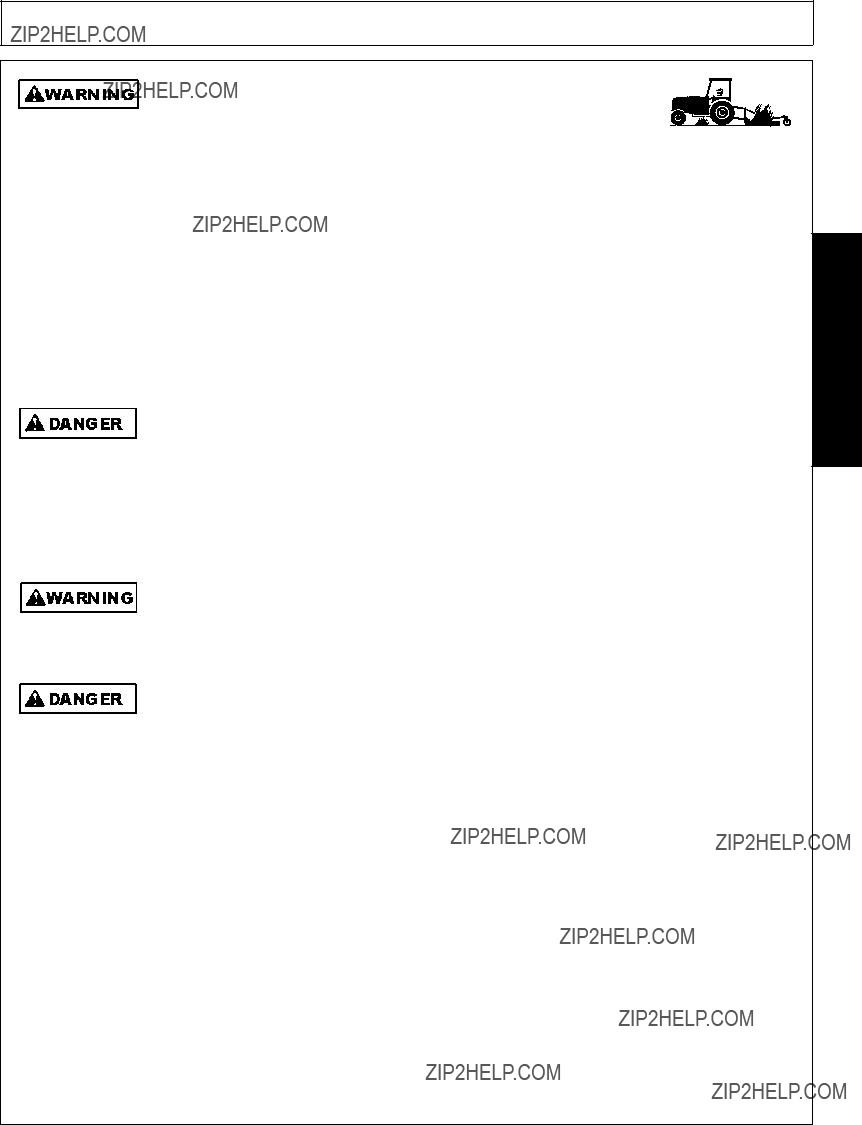
SAFETY
Follow these guidelines to reduce the risk of equipment and grass fires while operating, servicing, and repairing the Mower and Tractor:
-Equip the Tractor with a fire extinguisher in an accesible location. -Do Not operate the Mower on a Tractor with an underframe exhaust. -Do Not smoke or have an open flame near the Mower and Tractor. -Do Not drive into burning debris or freshly burnt areas.
-Ensure slip clutches are properly adjusted to prevent excessive slippage and plate heating.
-Never allow clippings or debris to collect near drivelines, slip clutches, and gearboxes. Periodically shut down the Tractor and Mower and clean clippings and collected debris from the mower deck. (SGM-12)
The Mower is designed for certain mowing applications and is rated to cut up to a specific size vegetation (see Mower Standard Equipment and Specifications). DO NOT use this mower to cut vegetation above the Mower???s rated capacity or to cut any type of non- vegetative material. Only operate this Mower on a properly sized and equipped Tractor. Operating this Mower in an application for which it is not designed and/or operating the Mower with the wrong size Tractor can cause Mower component damage and equipment failure resulting in possible serious injury or death. (SGM-14)
Do not operate or pull the mower into standing water. When uplift or fan type mower blades
contact water they can be severely deflected downward causing possible failure of blade resulting in serious boldly injury to the operator or bystanders. (SGM-15)
Use extreme caution when raising the Mower above ground level. Stop the Blades from turning when the Mower is raised and passersby are within 100 yards. Raising the Mower exposes the Cutting Blades which creates a potentially serious hazard and can cause serious injury by objects thrown from the Blades or by contact with the Blades. (SPU-1)
(SRM-01)
SAFETY
Rotary Mowers are capable under adverse conditions of throwing objects for great distances (300 feet or more) and causing serious injury or death. Follow safety messages carefully.
STOP MOWING IF PASSERSBY ARE WITHIN 300 Feet UNLESS:
-Front and Rear Deflectors, Chain Guards, or Bands are installed and in good, workable condition;
-Mower sections or Wings are running close to and parallel to the ground without exposed Blades;
-Passersby are outside the existing thrown-object zone;
-All areas have been thoroughly inspected and all foreign material such as rocks, cans, glass, and general debris has been removed.
NOTE: Where there are grass and weeds high enough to hide debris that could be struck
by the blades, the area should be: inspected and large debris removed, mowed at an intermediate height, inspected, closely with any remaining debris being removed, and mowed again at desired final height. (This will also reduce power required to mow, reduce wear and tear on the Mower drivetrain, spread cut material better, reduce streaking, and make the final cut more uniform).
Do not turn so sharp or lift mower so high to produce a severe "knocking" of the Driveline which will cause accelerated wear and breakage of drive train components and could result in possible injury from the separated Driveline sections. (SRM-04)
Do not let the Blades turn when the Mower Deck is raised for any reason, including clearance or for turning. Raising the Mower deck exposes the Cutting Blades which creates a potentially serious hazard and could cause serious injury or even death from objects thrown from the Blades. (SRM-07)

SAFETY
Connecting or Disconnecting Implement Safety Instructions and Practices
DO NOT use a PTO adapter to attach a non-matching Implement driveline to a Tractor
PTO. Use of an adapter can double the operating speed of the Implement resulting in excessive vibration, thrown objects, and blade and implement failure. Adapter use will also change the working length of the driveline exposing unshielded driveline areas. Serious bodily injury and/or equipment failure can result from using a PTO adapter. Consult an authorized dealer for assistance if the Implement driveline does not match the Tractor PTO.
(S3PT-14)
Always shut the Tractor completely down, place the transmission in park, and set the parking brake before you or anyone else attempts to connect or disconnect the Implement and Tractor hitches. (S3PT-15)
Never operate the Tractor and Mower if the Implement input driveline is directly connected to the Tractor transmission. Tractor braking distances can be substantially increased by the momentum of the rotating Mower blades driving the Tractor transmission even though the Tractor clutch has been disengaged. Install an over running clutch between the Tractor PTO and the Mower driveline to prevent this potentially dangerous situation. (S3PT-16)
When attaching the Implement input driveline to the Tractor PTO, it is important that the connecting yoke spring activated locking collar slides freely and the locking balls are seated securely in the groove on the Tractor PTO shaft. Push and pull the driveline back and forth several times to ensure it is securely attached. A driveline not attached correctly to the Tractor PTO shaft could come loose and result in personal injury and damage to the Implement. (S3PT-17)
Before operating the Implement, check to make sure the Implement input driveline will not bottom out or become disengaged. Bottoming out occurs when the inner shaft penetrates the outer housing until the assembly becomes solid-it can shorten no more. Bottoming out can cause serious damage to the Tractor PTO by pushing the PTO into the Tractor and through the support bearings or downward onto the PTO shaft, breaking it off. A broken driveline can cause personal injury. (S3PT-18)
(SG-6)
SAFETY
Transporting Safety Instructions and Practices
Be particularly careful when transporting the Implement with the Tractor. Turn curves or go up hills only at a low speed and using a gradual steering angle. Rear mounted implements move the center of gravity to the rear and remove weight from the front wheels. Make certain, by adding front ballast, that at least 20% of the tractor???s weight is on the front wheels to prevent rearing up, loss of steering control or Tractor tip-over. Slow down on rough or uneven surfaces to prevent loss of steering control which could result in property damage or possible injury. Do not transport unless 3-Point lift lever is fully raised and in the latched transport position. Dropping implement in transport can cause serious damage to the tractor and/or Implement and possibly cause the operator or others to be injured or killed.
(S3PT-02)
Allow sufficient clearance for the Implement to swing outward while turning. Implements carried behind the Tractor will swing outside the tire path when making turns. Contacting a solid object while turning will cause equipment damage and possible injury. (S3PT-20)
Make certain that the ???Slow Moving Vehicle??? (SMV) sign is installed in such a way as to be clearly visible and legible. When transporting the Equipment use the Tractor flashing warning lights and follow all local traffic regulations.
(STI-06)
(STI-01)
(SG-19)
SAFETY
Transport only at speeds where you can maintain control of the equipment. Serious accidents and injuries can result from operating this equipment at high speeds. Understand the Tractor and Implement and
how it handles before transporting on streets and highways. Make sure the Tractor steering and brakes are in good condition and operate properly.
Before transporting the Tractor and Implement, determine the proper transport speeds for you and the equipment. Make sure you abide by the following rules:
Test the tractor at a slow speed and increase the speed slowly. Apply the Brakes smoothly to determine the stopping characteristics of the Tractor and Implement. As you increase the speed of the Tractor the stopping distance increases. Determine the maximum transport speed not to exceed 20 mph (30 kph) for transporting this equipment.
Test the equipment at a slow speed in turns. Increase the speed through the turn only after you determine that the equipment can be operated at a higher speed. Use extreme care and reduce your speed when turning sharply to prevent the tractor and implement from turning over. Determine the maximum turning speed for you and this equipment before operating on roads or uneven ground.
Only transport the Tractor and Implement at the speeds which allow you to properly control the equipment.
Be aware of the operating conditions. Do not operate the Tractor with weak or faulty brakes or worn tires. When operating down a hill or on wet or rain slick roads, the braking distance increases: use extreme care and reduce your speed. When operating in traffic always use the Tractor???s flashing warning lights and reduce your speed. Be aware of traffic around you and watch out for the other guy.
Be particularly careful when transporting the Implement using the tractor. Turn curves or go up or down hills only at a low speed and at a gradual steering angle. Make certain that at least 20% of the tractor???s weight is on the front wheels to maintain safe steerage. Slow down on rough or uneven surfaces.
Only tow the Implement behind a properly sized and equipped Tractor which exceeds the weight of the Implement by at least 20%. DO NOT tow the Implement behind a truck or other type of vehicle. Never tow the Implement and another Implement connected in tandem. Never tow the Implement at speeds over 20 MPH.
(SG-20)
(SG-14)
(S3PT-11)
SAFETY
Maintenance and Service Safety Instructions and Practices
Make sure the PTO shield, integral driveline shields, and input shields are installed when using PTO-driven equipment. Always replace any shield if it is damaged or missing. (S3PT-8)
SAFETY

Relieve hydraulic pressure prior to doing any maintenance or repair work on the Implement. Place the Implement on the ground or securely blocked up, disengage the PTO, and turn off the tractor engine. Push and pull the Remote Cylinder lever in and out several times prior to starting any maintenance or repair work. (S3PT-09)
Always disconnect the main PTO Driveline from the Tractor before performing service on the Implement. Never work on the Implement with the tractor PTO driveline connected and running. Rotating Parts, Blades or Drivelines could turn without warning and cause immediate entanglement, injury or death.
All Safety Shields, Guards and Safety devices including (but not limited to) - the Discharge Deflectors, Steel Guards, Gearbox Shields, Belt Shileds, and PTO Shields should be used and maintained in good working condition. All safety devices should be inspected carefully at least daily for missing or broken components. Missing, broken, or worn items must be replaced at once to reduce the possibility of injury or death from thrown objects, entanglement, or blade contact. (SFM-2)
Always maintain the safety signs in good readable condition. If the safety signs are missing, damaged, or unreadable, obtain and install replacement safety signs immediately. (SG-5)
Do not modify or alter this Implement. Do not permit anyone to modify or alter this
Implement, any of its components or any Implement function. (SG-8)
Never work under the Implement, the framework, or any lifted component unless the Implement is securely supported or blocked up to prevent sudden or inadvertent falling which could cause serious injury or even death.
Never attempt to lubricate, adjust, or remove material from the Implement while it is in motion or while tractor engine is running.
?? 2011 Alamo Group Inc.
(SGM-13)
(SG-37)
(SG-35)
(SG-21)
SAFETY
Periodically inspect all moving parts for wear and replace when necessary with authorized service parts. Look for loose fasteners, worn or broken parts, and leaky or loose fittings. Make sure all pins have cotter pins and washers. Serious injury may occur from not maintaining this machine in good working order.
Do Not fill fuel tank while engine is running. Refuel only after engine has cooled down. If fuel is spilled, move machine away from the area of the spill and avoid creating any source of ignition until the gasoline has evaporated. (SG-28)
Perform service, repairs and lubrication according to the maintenance section. Ensure the unit is properly lubricated as specified in the lubrication schedule and all bolts and nuts are properly torqued. Failure to properly service, repair and maintain this Implement in good operating condition could cause component failure and possible serious injury or even death.
Use caution and wear protective gloves when handling sharp objects such as blades, knives, and other cutting edges. Be alert to worn component surfaces which have sharp edges. Sharp surfaces can inflict severe laceration injuries if proper hand protection is not worn.
All Safety Shields, Guards and Safety devices including (but not limited to) - the Deflectors, Chain Guards, Steel Guards, Gearbox Shields, PTO integral shields, and Retractable Door Shields should be used and maintained in good working condition. All safety devices should be inspected carefully at least daily for missing or broken components. Missing, broken, or worn items must be replaced at once to reduce the possibility of injury or death from thrown objects, entanglement, or blade contact. (SGM-3)
Replace bent or broken blades with new blades. NEVER ATTEMPT TO STRAIGHTEN,
WELD, OR WELD HARDFACING ON BLADES SINCE THIS WILL LIKELY CRACK OR
OTHERWISE DAMAGE THE BLADE WITH SUBSEQUENT FAILURE AND POSSIBLY
CAUSE SERIOUS INJURY FROM THROWN BLADES. (SGM-10)
DO NOT weld or repair rotating mower components. Welds and other repairs may cause severe vibration and/or component failure resulting in part being thrown from the mower causing serious bodily injury. See your Authorized Dealer for proper repairs.
?? 2011 Alamo Group Inc.
(SG-18)
(STL-7)
(STL-1)
(SPRM-1)
SAFETY
PARTS INFORMATION
Rhino mowers use balanced and matched system components for blade carriers, blades, cuttershafts, knives, knife hangers, rollers, drivetrain components, and bearings. These parts are made and tested to Rhino specifications. Non-genuine "will fit" parts do not consistently meet these specifications. The use of ???will fit??? parts may reduce mower performance, void warranties, and present a safety hazard. Use genuine Rhino mower parts for economy and safety.
SEE YOUR RHINO DEALER
Be sure you have adequate knowledge of the property you will be working on. Take time to make yourself aware of any area underwater or underground lines or cables. Contact with buried lines or cable could result in serious injury or death.
In wet conditions where there is a likelihood of material collecting on the Implement, make certain that this material is removed before traveling on public roadways.
In addition to the design and configuration of this Implement, including Safety Signs and Safety Equipment, hazard control and accident prevention are dependent upon the awareness, concern, prudence, and proper training of personnel involved in the operation, transport, maintenance, and storage of the machine. Refer also to Safety Messages and operation instruction in each of the appropriate sections of the Tractor and Equipment Manuals. Pay close attention to the Safety Signs affixed to the Tractor and Equipment.
SAFETY
Decal Location
NOTE: Rhino supplies safety decals on this product to promote safe operation. Damage to the decals may occur while in shipping, use, or reconditioning. Rhino cares about the safety of its customers, operators, and bystanders, and will replace the safety decals on this product in the field, free of charge (Some shipping and handling charges may apply). Contact your Rhino dealer to order replacement decals
SAFETY
?? 2011 Alamo Group Inc.
SAFETY
*Furnished by Tractor Manufacturer
Decal Sheets
Safety Decals - 00779774
Logo Decals - 00779775, 00779777, 00779778
SAFETY
Decal Description
Peligro Translation, If you do not know how to read English, please find someone who knows how to read English.
P/N 00725746
?? 2011 Alamo Group Inc.
SAFETY
Multi Hazard Decal Sheet
P/N 00749117
SAFETY
?? 2011 Alamo Group Inc.
SAFETY
DANGER! Keep Away blade contact can cause serious injury or death.
P/N D418
DANGER! Make certain that drivelines are correct length and are securely attached.
P/N 00756494
WARNING! - Guard Missing, Do Not Operate
P/N 00775933
?? 2011 Alamo Group Inc.
SAFETY
WARNING! Failure to use and maintain shields and deflectors in good condition may lead to injury or death from entanglement with rotating parts, being hit by objects thrown with great force by blades, or by contact.
Always replace guards which have been removed for maintenance. Never operate with guards missing or broken.
Chain guards, gearbox, driveline shields, rubber fabric deflectors and solid band enclosures are subject to wear. Lost and broken parts must be repaired or replaced as soon as damage is found.
Safety shields must be installed and in good condition to reduce the possiblity of thrown objects anytime the machine is operated in any area where thrown objects could cause property damage or bodily injury.
P/N 00769736
WARNING! Pinch Points
P/N 02962764
SAFETY
DANGER! Keep Away Thrown Objects.
Inspect the area before mowing for potential mower hazards. Remove or avoid all foreign objects such as wire, cable, metal objects, and all other foreign material.
Foreign material can be thrown from the mower and cause serious bodily injury to the operator and passerby.
Do Not let rotating blades contact solid objects like rocks, posts, curbs or guard rails.
Operate only if all Guards, Deflectors are in place and in good condition.
Do Not operate with Mower or Wing raised off the ground.
Stop mowing if Passersby enter the area of thrown objects. (See Operator???s Manual)
Stay away from rotating blades. Keep hands and feet away from rotating blades.
Do Not approach mower until all motion has stopped.
P/N 00769737
WARNING! Do not operate with Belt Shield removed. Finger(s) may be pinched off if get caught between V-Belt and Pulley.
P/N 00758194
IMPORTANT! Be Aware, Be Alert, Be Alive, Be
Trained.
P/N D353
?? 2011 Alamo Group Inc.
SAFETY
PELIGRO! Spanish Translation for Driveline Safety
P/N 00773723
WARNING! Avoid Bodily Injury, Use 540RPM PTO
Speed Only.
P/N D103
10 Hour - Lubrication Decal
P/N 00755691
Operator's Manual (with repair parts) and warranty was attached to this implement during final inspection.
P/N 00763977
?? 2011 Alamo Group Inc.
SAFETY
Read Operator???s Manual! The operator???s manual is located inside this canister. If the manual is missing order one from your dealer.
P/N 00776031
Slow Moving Vehicle Decal. Keep SMV reflector clean and visible. DO NOT transport or operate without the SMV.
P/N 03200347
For safety and to guarantee optimum product reliability always use genuine RHINO replacement parts.
P/N 00760657
LOGO NAME
P/N 99101
?? 2011 Alamo Group Inc.
SAFETY
Model Name - TM60
00785208
Model Name - TM72
00785209
Model Name - TM84
00785210
Model Name - TM100
SAFETY
Model Name - TURBO
00785212
INFORMATION - 5 Year Gearbox Warranty
00778611
?? 2011 Alamo Group Inc.

SAFETY
Federal Laws and Regulations
This section is intended to explain in broad terms the concept and effect of federal laws and regulations concerning employer and employee equipment operators. This section is not intended as a legal interpretation of the law and should not be considered as such.
Employer-Employee Operator Regulations
U.S. Public Law 91-596 (The Williams-Steiger Occupational and Health Act of 1970) OSHA
This Act Seeks:
???...to assure so far as possible every working man and woman in the nation safe and healthful working conditions and to preserve our human resources...???
DUTIES
Sec. 5 (a) Each employer-
(1)shall furnish to each of his employees employment and a place of employment which are free from recognized hazards that are causing or are likely to cause death or serious physical harm to his employees;
(2)shall comply with occupational safety and health standards promulgated under this Act.
(b) Each employee shall comply with occupational safety and health standards and all rules, regulations and orders issued pursuant to this Act which are applicable to his own actions and conduct.
OSHA Training Requirements
Title 29, Code of Federal Regulations Part 1928.57(a)(6). www.osha.gov
Operator instructions. At the time of initial assignment and at least annually thereafter, the employer shall instruct every employee who operates an agricultural tractor and implements in the safe operating practices and servicing of equipment with which they are or will be involved, and of any other practices dictated by the work environment.
Keep all guards in place when the machine is in operation; Permit no riders on equipment
Stop engine, disconnect the power source, and wait for all machine movement to stop before servicing, adjusting, cleaning or unclogging the equipment, except where the machine must be running to be properly serviced or maintained, in which case the employer shall instruct employees as to all steps and procedures which are necessary to safely service or maintain the equipment.
Make sure everyone is clear of machinery before starting the engine, engaging power, or operating the machine.
Employer Responsibilities:
To ensure employee safety during Tractor and Implement operation, it is the employer???s responsibility to:
1.Train the employee in the proper and safe operation of the Tractor and Implement.
2.Require that the employee read and fully understand the Tractor and Implement Operator???s manual.
3.Permit only qualified and properly trained employees to operate the Tractor and Implement.
4.Maintain the Tractor and Implement in a safe operational condition and maintain all shields and guards on the equipment.
5.Ensure the Tractor is equipped with a functional ROPS and seat belt and require that the employee operator securely fasten the safety belt and operate with the ROPS in the raised position at all times.
6.Forbid the employee operator to carry additional riders on the Tractor or Implement.
7.Provide the required tools to maintain the Tractor and Implement in a good safe working condition and provide the necessary support devices to secure the equipment safely while performing repairs and service.
8.Require that the employee operator stop operation if bystanders or passersby come within 300 feet.
Child Labor Under 16 Years of Age
Some regulations specify that no one under the age of 16 may operate power machinery. It is your responsibility to know what these regulations are in your own area or situation. (Refer to U.S. Dept. of Labor, Employment Standard Administration, Wage & Home Division, Child Labor Bulletin #102.)

Contents
Acknowledgment . . . . . . . . . . . . . . . . . . . . . . . . . . . . . . 2
Foreword . . . . . . . . . . . . . . . . . . . . . . . . . . . . . . . . . . . . . 2
Safety Alerts. . . . . . . . . . . . . . . . . . . . . . . . . . . . . . . . . . . 3
A Word To The User/Operator . . . . . . . . . . . . . . . . . . . . 3
The Industrial/Agricultural Mower. . . . . . . . . . . . . . . . . 4
Follow A Safety Program . . . . . . . . . . . . . . . . . . . . . . . . 5
Prepare For Safe Operation . . . . . . . . . . . . . . . . . . . . . . 9
Start Safely. . . . . . . . . . . . . . . . . . . . . . . . . . . . . . . . . . . 13
Operate Safely . . . . . . . . . . . . . . . . . . . . . . . . . . . . . . . . 13
Park Safely . . . . . . . . . . . . . . . . . . . . . . . . . . . . . . . . . . . 18
Shut Down Safely . . . . . . . . . . . . . . . . . . . . . . . . . . . . . 18
Perform Maintenance Safely . . . . . . . . . . . . . . . . . . . . 19
Final Word To The User. . . . . . . . . . . . . . . . . . . . . . . . . 26
Acknowledgment
We wish to acknowledge the contributions of the members of AEM???s Industrial/Agricultural Mower Manufacturers Council to the preparation of this Safety Manual.
NOTICE OF COPYRIGHT PROTECTION
Copyright, 2010, by the Association of Equipment Manufacturers. All rights reserved. This work may not be reproduced or disseminated in whole or in part by any means without the prior written permission of the Association of Equipment Manufacturers.
Copyright 2010?? AEM (Association of Equipment Manufacturers)
Revised 01/03, 09/10
Foreword
This safety manual is intended to point out some of the basic safety situations that may be encountered during the normal operation and maintenance of your machine and to instruct you in safety practices for dealing with these conditions. This manual is NOT a substitute for the mower manufacturer???s operator???s manual(s).
Additional precautions may be necessary, or some instructions may not apply, depending on equipment, attachments and conditions at the worksite or in the service area. The manufacturer has no direct control over equipment application, operation, inspection or maintenance. Therefore, it is YOUR responsibility to use good safety practices in these areas.
The information provided in this manual supplements the specific information about your machine that is contained in the manufacturer???s operator???s manual(s). Other information that may affect the safe operation of your machine may be contained on safety signs or in insurance requirements, employer???s safety and training programs, safety codes, local, state/provincial and federal laws, rules and regulations.
Read and
Understand
Manuals Before
Operating
IMPORTANT! Before you operate the mower, make sure you have the manufacturer???s operator???s manual(s) for this machine and all attachments. If the manufacturer???s manuals are missing, obtain replacement manuals from your employer, equipment dealer or directly from the manufacturer. Keep this safety manual and the manufacturer???s manuals with the machine at all times. Read and understand all manuals.
The AEM Mower Safety Practices video is available to train and reinforce good safety practices. Operators are encouraged to periodically view the safety video.

Symbol
This Safety Alert Symbol means: ???ATTENTION!
STAY ALERT! YOUR SAFETY IS INVOLVED!???
The Safety Alert Symbol identifies important safety messages on equipment, safety signs, in manuals or elsewhere. When you see this symbol, be alert to the possibility of death or personal injury. Follow instructions in the safety message.
Reasons Safety is Important:
???Accidents disable and kill.
???Accidents cost.
???Accidents can be avoided.
Signal Words
Signal words are distinctive words that will typically be found on safety signs on the mower and other worksite equipment. These words may also be found in this manual and the manufacturer???s manuals. These words are intended to alert the operator to a hazard and the degree of severity of the hazard.
DANGER indicates a hazardous DANGER situation which, if not avoided, will
result in death or serious injury.
WARNING indicates a hazardous WARNING situation which, if not avoided, could
result in death or serious injury.
CAUTION indicates a hazardous CAUTION situation which, if not avoided, could
result in minor or moderate injury.
A Word To The User/Operator
It is YOUR responsibility to read and understand the safety manual and the manufacturer???s manuals before operating this machine. This safety manual takes you step by step through your working day.
Hazard Recognition and Accident Prevention depend upon you being alert, careful and properly trained in the operation, transport, maintenance and storage of this equipment.
Graphics have been provided to help you understand the text.
Read and
Understand All
Safety Signs
Remember that YOU are the key to safety. Good safety practices not only protect you but also protect the people around you. Study and understand this manual and the manufacturer???s manuals for your specific machine. Make them a working part of your safety program. Keep in mind that this safety manual is written for industrial/agricultural mowers.
Contact the manufacturer of your equipment to answer any questions about safe operation that remain after studying the manufacturer???s operator???s manual(s) and this safety manual.
Practice all other usual and customary safe working precautions and above all:
REMEMBER ??? SAFETY IS UP TO YOU!
YOU CAN PREVENT SERIOUS INJURY OR
DEATH CAUSED BY UNSAFE WORK PRACTICES!
The Industrial/Agricultural Mower
Industrial/Agricultural Mower Types
Mowers are used for pasture clipping, crop residue shredding, heavy brush cutting, waterways, right-of- ways, roadside or highway mowing. Also, these mowers are used for cutting grass and other growth in public areas such as parks and cemeteries.
Rotary
Sickle Bar
Folding Wing Rotary
The Industrial/Agricultural Mower
Follow A Safety Program
Protect Yourself
Wear personal protective clothing and Personal Protective Equipment (PPE) issued to you or called for by job conditions. You must ALWAYS wear safety glasses with side shields.
You may also need:
???Hard hat
???Safety shoes
???Safety goggles or face shield
???Heavy gloves
???Hearing protection
???Reflective clothing
???Wet weather gear
???Respirator or filter mask
Wear whatever is needed???don???t take chances.
WARNING! Prevent death or serious injury from
entanglement. Do not wear loose clothing or accessories. Tie up long hair. Stay away from all rotating components when the engine is running.
Contact, wrapping or entanglement with rotating or moving parts could result in death or serious injury.
???Read, understand and follow the manufacturer???s written instructions found in the operator???s manual(s) and safety signs on mower and tractor.
???Have operational training with mower and tractor.
???Take advantage of training programs offered in your area.
???Ask your equipment dealer or supervisor to explain things you do not understand.
???Explain the written instructions in the operator???s manual(s) and safety signs to those users or operators who cannot read.
???Inspect the mower and tractor daily before operating. Ensure all guards are in place and the equipment is operating properly.
???Never smoke while operating. Never fill the fuel tank with the engine running or near an open flame.
???Make sure you have adequate visibility and sufficient lighting.
???Know the pinch points and rotating parts. Awareness on your part can prevent accidents.
???Never attempt to operate the controls except from the operator???s seat. Improperly controlled functions could produce unexpected machine movement and result in serious injury or death.
???Shut down the mower and tractor before dismounting. (See page 18, Proper Equipment Shut Down Practices.)
Read, Understand
and Follow Manuals
and Safety Signs
Avoid
Rotating Parts
Know and
Avoid Pinch
Points

Avoid Injury From Raised Equipment
Avoid possible crushing injury from falling mower or other raised equipment.
Avoid Crushing ???
Block Up or
Securely Support
Mower
Before working near or under raised mower or equipment parts:
???Securely support or block up raised mower or equipment parts according to the operator???s manual.
???Securely support, block up or lock up wings with approved locking devices or lower mower or equipment parts to the ground.
???Use transport locks when transporting mower on public roads.
Avoid Injury From High Pressure Fluid
Avoid fluid injection injury due to high pressure fluid leaks.
High Pressure
Fluid Can Inject
into the Body
If any ???uid is injected into the skin, it must be removed within a few hours by a doctor familiar with this type of injury.
Fluid leaks under pressure may not be visible. When checking for leaks or working around pressurized systems:
???Read manufacturer???s operator???s manual(s) for recommended safety practices.
???Wear a face shield or safety goggles for eye protection.
???Use a piece of cardboard or wood to check for leaks;
DO NOT use your hands.
???Relieve system pressure before disconnecting lines.
???Check for and repair damaged or leaking lines, pipes and hoses.
???Check for and tighten loose connections.
???Purge air from system before operating.
Avoid Injury From Fire And Explosion
Set the parking brake, shut the mower and tractor engine down and remove the key while filling the fuel tank. Use extra caution when fueling a hot engine. Never smoke while fueling. Avoid sparks by grounding the fuel nozzle against the filler neck.
The fumes in an empty fuel tank are explosive. Never weld or cut on fuel lines, tanks or containers.
Remove all trash or mowing debris from the machine daily or as needed. Keep debris away from engine, exhaust, slip clutches and other heat sources. Use spark arrestors, as appropriate, on the engine exhaust system. Make sure oily rags or other flammable material are not stored on the machine.
Check for fuel, oil or hydraulic fluid leaks. Repair the leaks and clean the machine before you operate it.
Ether/cold start fluid is flammable. Do not smoke when using ether/cold start fluid. Always follow the instructions on the can and in the manufacturer???s operator???s manual(s) for your mower. Do not use ether/ cold start fluid if the engine is equipped with a glow plug or other type of preheater.
Always use a nonflammable solvent when you clean parts. Do not use gasoline, diesel fuel or other flammable fluids.
Store all flammable fluids and materials away from your machine and work area.
Know where fire extinguishers are kept???how they operate???and what type of fire they are for. Check readiness of fire extinguishers according to
manufacturer???s instructions. Make sure each tractor is equipped with a fire extinguisher.
No Smoking
and No Open
Flames
Remove
Debris Daily or
As Needed

Be Alert!
Know where to get assistance. Know how to use a first aid kit and fire extinguisher/fire suppression system.
Be Aware!
Take advantage of training programs offered.
Be Careful!
Human error is caused by many factors: carelessness, fatigue, overload, preoccupation, unfamiliarity of operator with the machine, drugs, and alcohol to name a few. Damage to the tractor or mower can be fixed in a short period of time, but injury, or death, has a lasting effect.
For your safety and the safety of others, encourage your fellow workers to act safely.
Never Use Drugs
or Alcohol While
Operating
For Safe Operation
You must be a qualified and authorized operator for proper operation of your machine. You must clearly understand the written instructions supplied by the manufacturer, be trained???including actual operation of the mower???and know the safety rules and regulations for the worksite. It is a good safety practice to point out and explain safety signs and practices and ensure others understand the importance of following these instructions.
WARNING! Drugs and alcohol affect an operator???s alertness and coordination and the operator???s ability to safely operate the equipment. Never use drugs or alcohol while operating the mowing equipment. Never knowingly allow anyone to operate this machine when their alertness or coordination is impaired. An operator taking prescription or over-the- counter medication must consult a medical professional regarding any side effects of the medication that would hinder their ability to safely operate this equipment.
Know The Rules
Most employers have rules governing operation and maintenance of equipment. Before you start work at a new location, check with your supervisor or the safety coordinator. Ask about the rules you will be expected to obey.
The Occupational Safety and Health Administration
(OSHA) enforces federal laws within the United States that apply to safe operation, application and maintenance of equipment on a worksite. It is the employer???s responsibility to comply with these laws. An OSHA representative may periodically inspect a worksite to see that these laws are being followed.
There may also be local or state/provincial laws or international regulations that apply to this equipment and its use, along with specific worksite or employer rules. It is important that you know and comply with all applicable laws and rules, including those requiring operator training and certification.
Safety Rules
These are some of the rules you must work by:
???A ROPS and seat belt-equipped tractor is a federal government (OSHA) requirement for operator protection during mowing operations. An enclosed cab provides additional operator protection from thrown objects. Check your mower operator's manual to see if a tractor cab is also required.
???Wear and check that others are wearing proper clothing and personal protective equipment.
???Inspect your machine and attachments before each use as specified by the manufacturer and your employer.
???Know the limitations and operating characteristics of your mowing equipment. Do not misuse it.
???Have all provided shields and guards properly installed before operating the machine.
???Never modify or remove any part of the machine (except for service???then make sure it is replaced).

Follow A Safety Program
Some Rules You Must Work By (continued)
??? Only qualified and authorized individuals may operate this equipment.
???Never allow children to play on, ride on or operate the equipment. Children are not qualified to operate this equipment.
???Do not allow any riders.
??? Use three-point contact (handholds and steps) and face the equipment when mounting or dismounting.
??? Keep bystanders 300 ft (92 m) from the mowing operation.
???Know the worksite before you use the mower. Be aware of possible terrain hazards that you may
encounter. Remove or mark obstacles and debris that could damage or be thrown by the mower.
??? Only use attachments and parts that are approved by the mower manufacturer.
??? Make sure all attachments are lowered, set the parking brake, shut off the engine and cycle the control levers. Remove the key before leaving the tractor. (See page 18, Proper Equipment Shut Down Practices.)
???When transporting the mower on a trailer, follow the manufacturer???s detailed instructions for loading, tying down and unloading the mower.
Keep
Children Away from Equipment
Keep
Bystanders
Away
No Riders
Shut Down
Unattended
Equipment
Know The Equipment
Read and understand the DANGER, WARNING, CAUTION and NOTICE safety signs and other informational signs on the tractor and mower and in the manufacturer???s operator???s manual. Ask your supervisor or mower dealer to explain any information you do not understand. Failure to obey safety instructions could result in death or serious injury.
Read and
Understand All
Safety Signs
Make sure all the manufacturer???s protective structures, guards, shields, screens and panels are in good repair, in place and securely fastened. Damaged, missing or weakened safety components can create a hazardous situation for you as the operator. Never remove or modify any safety components including thrown object shielding on a mower.
Know the following about your tractor and mower:
???Function, purpose and use of all controls.
???Correct operation speeds.
???Slope and uneven terrain capabilities and proper operation.
???Braking and steering characteristics.
???Turning radius and clearances.
???How to quickly stop equipment in an emergency.
Read and
Understand
Manuals Before
Operating
Prepare For Safe Operation
Check The Mower And Tractor Equipment
Before beginning your work day inspect the machine and have all systems in good operational condition.
WARNING! Prevent possible crushing injury from falling equipment. Hydraulic system or part failure could cause unsupported equipment to fall. Do not go under raised equipment unless it is properly supported according to the operator???s manual.
???Perform daily and periodic service procedures as instructed by the equipment manufacturer.
???Check for loose, broken, missing or damaged tractor and mower parts. Repair or replace these parts.
???Check for proper tractor and mower attachments.
???Check for proper tractor and mower PTO rpm rating match.
???Check mower blade(s) condition. Replace severely worn, bent, gouged or nicked blades including the blade bolts and fasteners. Never straighten or weld on blades.
???Ensure thrown object shielding is properly installed and in good condition. Repair or replace if damaged or missing.
Walk-Around
Inspection
Maintain
Machine
Read Manual ???
Block Up or
Securely Support
Mower
Prepare For Safe Operation
???Check that all guards and shields are in place and that all equipment is in good operating condition. This includes PTO driveline, gearbox and implement guards and shields that are used for operator protection.
???Check for properly latched driveline yoke-end locking devices.
???Check for damaged or leaky tractor and mower hydraulic systems. Repair or adjust as needed.
WARNING! Hydraulic fluid under pressure can penetrate the skin or eyes and cause serious injury, blindness or death. Fluid leaks under pressure may not be visible.
Use a piece of cardboard or wood to ???nd leaks, not your hand. Wear eye protection. If fluid is injected into the skin, it must be removed within a few hours by medical personnel familiar with this type of injury.
???Keep the operator platform surface clean and free of grease, oil, dirt, snow or ice. Steps and handholds must be clean and functional.
???Ensure work lights are kept clean (if equipped). Check that all lights work properly.
???Ensure the slow moving vehicle (SMV) sign, reflectors and warning lights are in good condition and can be clearly seen.
???Ensure all tools or loose objects are removed or securely fastened while operating the machine.
???Check all safety signs for clarity. Replace damaged signs.
Check for Missing/ Damaged Guards and Shields
Check for
Leaks and Inspect
Hoses
Put Away
Tools
Prepare For Safe Operation
Know The Work Area
Before you operate the mower thoroughly inspect the work area. Walk around the area and inspect the surfaces you will travel on when using the mower.
Walk
Around the
Worksite
Look for debris and obstacles by walking the area before you mow. Objects like wire, cable, rocks, tires, and metal objects that could damage or be thrown by the mower must be removed or marked clearly and avoided.
Correct unsafe conditions. Do not operate in problem areas where debris and obstacles cannot be removed or marked.
Analyze mowing area to determine:
???The most efficient mowing procedure.
???The height of the material to be mowed.
???Operating terrain conditions.
???How to best use forward mowing pattern.
???The potential for bystanders or passers-by to be exposed to thrown objects.
Remove or
Mark Debris and
Obstacles
Look Out For Others
Before starting equipment:
???Walk around the equipment.
???Check for anyone under, on or near the equipment.
???Clear everyone from these areas.
???Sound a warning.
Prepare For Safe Operation
Mount And Dismount Tractor Properly
Always use three-point contact when mounting or dismounting the tractor or mower. Face the machine when you enter or leave the machine. Three-point contact means that three out of four arms and legs are in contact with the machine at all times during mount and dismount.
Before mounting:
???Clean shoes and wipe hands. Clean steps and handholds of snow, ice, mud or oil.
During mounting and dismounting:
???Use handholds and step plates.
???Never grab steering wheels or controls for handholds.
???Never mount or dismount from a moving tractor.
???Never mount or dismount while carrying tools or objects that prevent three-point contact. Put parts or tools down. Maintaining proper contact, climb and then pick up the object.
Use
Three-Point
Contact
Clean Up
Slippery Areas
Prepare For Safe Operation
Tractor And Mower Controls Safety Test
Start the tractor following the specific procedures in the manufacturer???s operator???s manual. These procedures normally include:
???Fasten and adjust seat belt on your ROPS-equipped tractor.
???Check parking brake for engagement.
???Check PTO disengagement.
???Check all controls for Park position.
???Warn others in area before starting tractor.
???Start tractor following tractor manufacturer???s recommended starting procedures.
WARNING! Avoid serious injury or death from unexpected machine movement. Start the engine only from the operator???s position. Never attempt to start the engine by shorting across starter terminals or reaching the key from the ground or outside the cab.
After starting:
???Check all instruments, gauges and indicator lights for normal operation.
???Check all tractor controls, steering and brakes for proper function.
???Raise and lower mower to check for driveline bottoming out or engagement problems.
???Check the equipment for excessive vibration and unusual noises.
Use ROPS
and Seat Belt
Start Only from Operator???s Seat
Check
Instruments
and Controls
Prepare For Safe Operation
???Use proper equipment shut down practices before inspecting equipment. Wait until all equipment motion has stopped before dismounting the tractor or mower.
???Do not operate mower unless tractor and mower are running properly. Place a ???Do Not Operate??? tag on the machine, remove the key and do not operate the mower until the problem is corrected.
Power Takeoff System
Be sure to operate the tractor at the mower???s rated PTO rpm speed.
When operating tractors with transmission-driven PTO systems, a rotary mower will have a significant flywheel effect. The mower may continue to propel a tractor with a transmission-driven PTO system.
The tractor should be equipped and operated as follows:
???Install a driveline equipped with an over-running clutch.
???Give yourself sufficient maneuvering room and time by anticipating turns, stops and speed reductions.
Do Not
Dismount Until
Equipment Motion
Has Stopped
Use a
???Do Not Operate???
Tag
Use Proper
PTO Speed
Prepare For Safe Operation
Hitching Mower To Tractor
Three-point hitch-mounted mowers:
???Refer to mower and tractor manufacturers??? manuals.
???Place tractor???s hydraulic power lift (rockshaft) selector lever in down position to avoid unexpected movement.
???Explain the hitching procedures to those operators who cannot read.
???Front-end weights may be needed to maintain steering control and front-end stability. Refer to the manufacturers' operator's manual(s).
???When backing the tractor up to the mower, NEVER allow anyone between the tractor and the mower.
???Attach the mower to the tractor three-point links and securely pin in position.
???Securely attach the driveline to the tractor PTO. Lower the master shield into place if it is movable.
Push and pull on the driveline to ensure it is locked onto the PTO shaft.
Read and
Understand
Manuals Before
Operating
Maintain
Proper Weight
Distribution
No One
Allowed Between
Tractor and
Mower
Avoid
Entanglement,
Use Guards and
Shields
Prepare For Safe Operation
Pull-type hitch-mounted mowers:
???Refer to mower and tractor manufacturers??? manuals.
???Remove three-point hitch quick coupler if equipped.
???Attach only to drawbar hitch.
???Adjust tractor drawbar length for 540 or 1000 rpm PTO operation.
???When backing the tractor up to the mower, NEVER allow anyone between the tractor and the mower.
???Properly attach the mower safety tow chain to the tractor.
???Securely attach the driveline to the tractor PTO. Push and pull on the driveline to ensure it is locked onto the PTO. Lower the master shield into place.
???Hook up the mower hydraulic hoses to the tractor.
???Make sure the wings, or raised mower decks, are supported by the cylinders before removing the transport locks. Never use force to release the transport or wing locks. The wings or deck could fall and crush you.
540RPMRPOPTO
11--3/8"66SPLINE
14IN
Tractor
Drawbar
Adjustment
1000 RPM PTO
1000 RPO PTO
11--3/8"2121SPLINE
16IN 
1000 RPM PTO
1000 RPO PTO
1-3/4" 20 SPLINE
20IN 
Con???rm Wings Are
Supported Before
Releasing Locks
Avoid
Entanglement,
Use Guards and
Shields

Make The Right Start
Mow only in daylight or good artificial light conditions.
Avoid serious injury or death from mower-thrown objects or blade contact:
???Keep chain shields, flexible or solid deflector shields or discharge chutes in place and in good repair.
???Keep bystanders at least 300 ft (92 m) from mowing operation.
???Never direct mower discharge toward anyone.
???Keep hands, feet and other body parts away from rotating parts, blades and discharge openings.
???Do not operate mower in transport position.
Do not approach a mower until all motion has stopped.
Mower PTO drive engagement:
???Raise mower to maximum cutting height.
???Engage PTO at low engine rpm.
???Increase engine rpm to mower???s rated rpm PTO speed.
???Lower mower to desired cutting height.
???Stop and shut down immediately if the mower strikes an obstruction.
???Inspect and repair any mower damage before resuming mowing.
???Do not operate mower with severe vibrations or with unusual noise.
Rotating Blades ???
Keep Away
Do Not Operate a
Damaged Mower
Mower-Thrown Objects
Depending on the designed purpose, mowers are designed to cut grass, weeds, brush and crops. The mower blades have been designed and tested for rugged use. The mower blades, however, are not intended to contact solid objects like rocks, concrete or metal. Such impact can cause broken objects to be thrown up to 300 ft (92 m). Bystanders should never be within 300 ft (92 m) of an operating rotary mower or within 100 ft (30 M) of a properly equipped disc mower.
Mower shielding is designed to reduce the risk of thrown objects and must be properly maintained and in place during mowing operations.
The risk of serious injury or death from thrown objects can be significantly reduced by following three rules.
If all of these safety rules are not followed, the mowing operation must be stopped if anyone comes within the safety limit for the mower type.
First ??? Inspect the area prior to mowing and remove stones, branches, wire, cable, metal, glass and other solid objects before operating. Any objects that cannot be removed must be clearly marked and carefully avoided by the operator.
In non-crop areas with grass and weeds high enough to hide objects that could be struck by the blades, inspect the area and remove or mark large debris or obstacles.
Mow the area at an intermediate height. Inspect the area closely and remove or mark any remaining debris or obstacles. Mow again at desired final height.
Follow
All Mower
Safety Rules
Second ??? Mower-thrown object shielding must be used when operating near roads, parks, populated areas or other areas where thrown objects could injure bystanders or damage property. Follow the manufacturer's operator's manual.
Third ??? Cross diagonally when mowing through ditches, sharp dips, and drops. Raise the mower to prevent the mower blades from hitting the ground.

Mower-Thrown Objects (continued)
Disc Mowers ??? When using a disc mower it is important to know the area to be mowed. If the operator has mowed the field before and is familiar with all obstacles that may be present, it is sufficient to watch ahead of the mower path for any additional objects that may have entered the field. Be ready to stop or avoid any objects that could be hazardous if thrown by the mower. If you plan to mow an unfamiliar field and it is next to a traveled road or people may be within 100
ft (30 m) of the mower you must inspect, and clean or mark the field.
Mowing In Reverse
Do not mow while traveling in reverse. Objects are more likely to be thrown and can travel further.
Shut off the PTO, wait for the blades to stop turning, raise the mower, and then back up.
Mow traveling in the forward direction.
Do Not Mow
in Reverse
Use Proper
Ground Speed
Mowing Ground Speed
Proper ground speed depends on terrain conditions and grass type, density and height to be cut:
???Normal ground speed range is 2 to 5 mph.
???Use slower ground speed for mowing tall, dense grass.
???Use faster ground speed for mowing medium height, thin grass and under smooth terrain conditions.
???Use slower ground speed for mowing in rough, sloping or unfamiliar terrain.
Disc mowers are designed to use faster ground speeds for operating in fields clear of debris and surface hazards.
Extremely Tall Grass Mowing
You may need to mow extremely tall, non-crop grass twice. (See page 13, Mower-Thrown Objects.)
First mowing pass:
???Shut the mower and tractor down using proper equipment shut down practice before dismounting tractor. (See page 18, Proper Equipment Shut Down Practices.)
???Inspect the area and remove or mark debris and obstacles.
???Cut grass higher (10-15 inches) to avoid hidden objects.
Second mowing pass:
???Shut the mower and tractor down using proper equipment shut down practice before dismounting tractor.
???Inspect the area and remove or mark debris and obstacles.
???Cut grass at desired height and, when possible, 90 degrees to the first mowing pass.
Stop Blade
Before
Unclogging
Provide Adequate
Clearance for
Mower Swing
Watch Equipment Clearances
Three-point hitch and side-mounted mowers have a larger turning arc than pull-type mowers. Allow sufficient clearance for mower swing while turning.
Do not allow bystanders near the tractor and mower when moving or transporting the tractor and mower.
Operate Safely
Under Mount Mower Safety Practices
When mowing with an under mount mower:
??? Keep removable discharge chute in place and over discharge opening.
???Never stand on a mower housing when the tractor engine is operating.
???Distribute grass clippings with discharge chute facing
mowed area.
???Before clearing a clogged mower or discharge chute, shut down your machine using proper
equipment shut down practice. (See page 18, Proper Equipment Shut Down Practices.)
Never Stand
on Mower ???
Keep Away
Keep Chute
in Place
Stop Blade
Before
Unclogging
Operate Safely
Wing Or Boom Mower
Overhead Obstruction Hazards And Risks
Check for overhead obstructions with raised wing or boom mowers to avoid serious injury or death by contact with:
??? Electrical power lines and apparatus.
??? Low tree limbs.
??? Other overhead obstructions.
??? Maintain specified distance from power lines and apparatus. Never approach energized power lines or apparatus with any part of your machine unless all local, state/provincial and federal (OSHA) required safety precautions have been taken. Use extreme caution.
DANGER! Avoid electrocution or serious injury from contact with or inadequate clearance to energized power lines or apparatus. Do not allow the machine or attachment to approach or contact any power line. Do not approach or touch any machine in contact with a power line.
Do Not
Approach Energized
Power Lines
Stay Clear
of Energized
Equipment
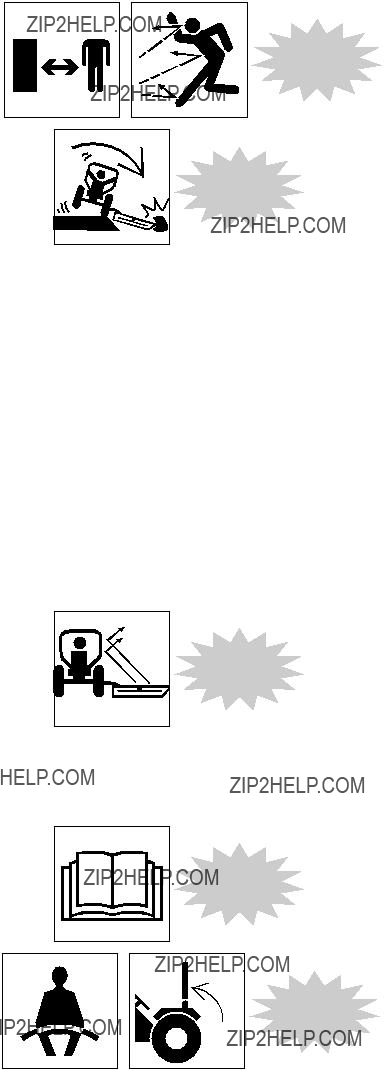
Wing And Side Mount Mowers Safety Practices
Raised wing positions reduce shielding protection and increases the thrown object and blade contact hazard risks.
Avoid possible serious injury or death by thrown objects or blade contact from raising and lowering wings during mowing operations:
???Do not mow with bystanders within 300 ft (92 m) of the mower.
???Be sure no one is near mower while raising or lowering wings.
???Shut off the PTO and wait for all rotating elements to stop before raising the mower deck or wing section.
???Only raise wing to clear objects in the mowing path or to match ground slope.
???Lower raised wing to ground after clearing object or ground slope conditions.
???Stop mowing if anyone approaches within 300 ft (92 m) of mowing area.
300 ft
(92 m) 
Keep Bystanders
Away from
Mowing Area
Avoid Hitting
Obstructions
Ditch Bank Mowing Safety Practices
Use extreme care when mowing ditch banks. Watch for washouts, eroded areas and mowing obstructions along the ditch banks. Hitting obstructions with side-mount or boom mowers may swerve the tractor???s front end toward the ditch.
Raised wing and boom mower ditch bank operations may reduce the mower???s thrown object shielding effectiveness for the mower operator???s protection.
???Use enclosed ROPS cabs, special protective enclosures and other operator shielding available from the manufacturer when performing these operations.
???Inspect mowing area and remove or mark all foreign objects and debris to be avoided by mower.
Uneven Terrain Mowing Safety Practices
Tractor and mower stability is reduced on slopes and uneven terrain.
As in all conditions when mowing, use tractors equipped with ROPS and seat belt. Make sure the
ROPS are raised and locked in place and always wear your seat belt.
Prevent tractor and mower overturns and maintain equipment stability control:
???Review tractor and mower operator???s manuals for operating safety practices on slopes and uneven terrain conditions. Explain the practices to those users and operators who cannot read.
???Avoid extremely steep slope operations.
Use
Enclosed ROPS
Cabs or Protective
Enclosures
Read and
Understand
Manuals Before
Operating
Use ROPS
and Seat Belt
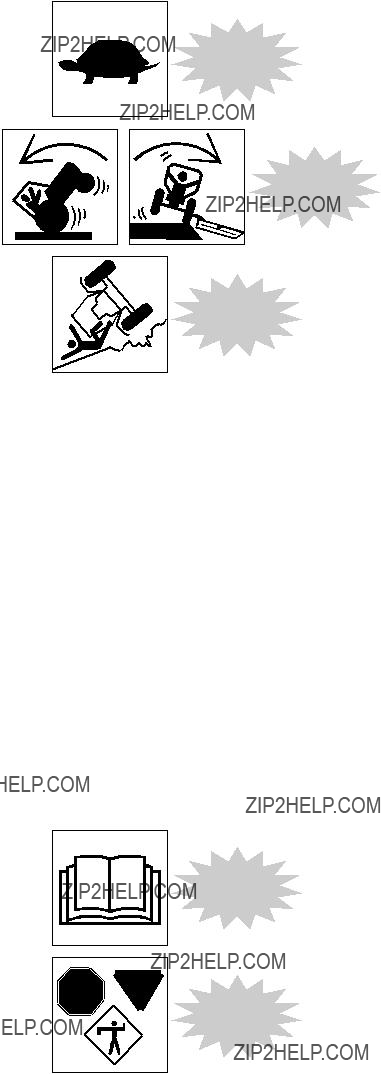
Operate Safely
Uneven Terrain Mowing Safety Practices (continued)
???Use extreme care to maintain control over the equipment when operating in these conditions.
???Increase tractor stability by adding wheel weights, ballast and increasing wheel spacing to maximum. Refer to operator???s manual for recommendations.
???Maintain minimum ground speed.
???Make wide and gradual turns.
???Avoid sudden starts, stops, and turns when operating
up, down, or across slopes.
??? Do not raise rear-mount or side-mount mowers or mower wings from the ground during these operations.
???Keep alert for holes, bumps, ruts, rocks, stumps or other obstructions that could overturn the machine.
???Avoid slippery ground conditions that could cause loss of control and overturn of tractor and mower.
???Avoid bottoming and striking the ground by diagonal crossing of sharp dips and drops.
Use extreme care in maintaining equipment stability during all uneven terrain and slope mowing operations. You are the final judge as to any slope that can be safely negotiated.
Maintain
Control, Use Low
Speeds
Add Ballast,
Widen Wheel
Spacing
Avoid Ruts,
Bumps, Holes
Road Transport Safety Practices
Before operating on public roads:
???Refer to tractor and mower manufacturers??? operator???s manuals for instructions.
???Explain the instructions to those users or operators who cannot read.
???Check local regulations for required equipment markings, lights, flashers, etc., while traveling on public roads. Lights are required on mowers that obscure tractor taillights and/or warning lights.
???When transporting the mower on a trailer, follow the manufacturer???s detailed instructions for loading, tying down and unloading the mower.
Before transporting on public roads:
???Disengage PTO power to mower.
???Raise mower into transport position and engage transport lock.
???Lock mower wings in the transport position with approved locking devices.
???Attach towing safety chain between pull-type mower and tractor.
???Make sure lights, warning lights and reflectors are in place and visible.
???Check SMV (Slow-Moving Vehicle) emblem for visibility to any rear-approaching vehicle.
While transporting on public roads:
???Obey all local traffic regulations.
???Approach intersections with caution.
???Observe speed and traffic control signs.
???Avoid panic stops and sharp turns.
Be a courteous operator and pull over periodically and allow traffic to pass.
Read and
Understand
Manuals Before
Operating
STOP YIELD
Obey Traf???c
Regulations
Shut down the mower and tractor using proper equipment shut down practice before dismounting tractor. (See page 18, Proper Equipment Shut Down Practices.)
Sloping ground parking locations:
???Position equipment across slope.
???Set parking brakes.
???Lower raised equipment to ground.
???Block tractor wheels.
Before temporarily parking and leaving disabled equipment near traffic areas:
???Remove equipment from public roads.
???Set out warning flags.
???Use tractor flashing warning lights.
Set
Parking Brake
Lower Raised
Equipment to
Ground
Proper Equipment Shut Down Practices
Make proper equipment shut down an important habit.
Properly shutting down a tractor and mower can prevent accidents from occurring when the mower is left unattended. Shut down the mower following the specific procedures in the manufacturer???s operator???s manual. These procedures will normally include:
???Reduce engine speed.
???Disengage PTO clutch and transmission drive.
???Idle engine for gradual cooling.
???Place all controls in PARK position.
???Set the parking brake.
???Lower mower to ground.
???Lower wings of wing mowers to ground.
???Shut off engine, lock ignition and remove key from the machine and take it with you.
???Wait for all moving parts to stop before dismounting.
???Relieve hydraulic pressure by moving hydraulic controls several times in all directions.
???Lock anti-vandalism covers and closures, if equipped, when equipment is unattended.
???Dismount carefully maintaining three-point contact.
Disengage PTO,
Set Brake
Lower Raised
Equipment to
Ground
Wait for Rotating Parts to Stop
Remove Key,
Lock Ignition, Take
Key With You
Dismounting Properly
???Never dismount from moving equipment.
???Never jump from any machines.
???Dismount carefully.
???Check for slippery steps.
???Keep feet and hands away from controls.
???Use handholds and steps during dismount.
???Face machine and use three-point contact (2 hands and 1 foot or 2 feet and 1 hand).
Wait for Moving Parts to Stop
Use Three-Point
Contact,
Face Machine
Perform Maintenance Safely
Maintain Your Equipment
Maintain
Equipment
Be sure to maintain the equipment according to manufacturer???s instructions. Regularly check the operation of the protective and safety devices.
Do not perform any work on a tractor or mower unless you are authorized and qualified to do so.
If you have been authorized to do maintenance, read the operator???s and service manuals. Study the instructions; check the lubrication charts; examine all the instruction messages on the machine. Maintenance can be hazardous unless performed properly. Be sure you have the necessary skill, information, correct tools and equipment to do the job.
WARNING! Do not modify equipment or add components not approved by the manufacturer. Use parts, lubricants and service techniques recommended by the manufacturer.
Mower Parts And Your Safety
Mower manufacturers use specific fasteners and specially designed parts to meet mowing operations requirements. Critical parts (self-locking blade bolts, blades, pins, shields and other special items) have specific strength, design and fit requirements for the make and model mower you are using.
Avoid possible death or serious injury from unapproved parts or modifications:
???Do not substitute common hardware for original manufacturer???s blade bolts or other special part items.
???Do not substitute for blades, pins, shields or other critical parts.
???Do not use higher strength bolts to replace original manufacturer???s shear bolts.
Perform Maintenance Safely
Prepare Yourself
Wear personal protective clothing and Personal Protective Equipment (PPE) issued to you or called for by job conditions. You must ALWAYS wear safety glasses with side shields.
You may also need:
???Hard hat
???Safety shoes
???Safety glasses, goggles or face shield
???Apron and gloves
???Hearing protection
???Welding helmet or goggles
???Respirator or filter mask
Wear whatever is needed???don???t take chances.
Keep hands???and clothing???away from all moving parts. Don???t wear dangling ties, loose sleeves, rings, watches, or long hair.
WARNING! Prevent death or serious injury from entangle- ment. Do not wear loose clothing or accessories. Stay away from all rotating components when the engine is running. Contact, wrapping or entanglement with rotating or moving parts could result in death or serious injury.
Avoid
Rotating Parts
Avoid
Pinch Points
Perform Maintenance Safely
Wear a rubber apron and rubber gloves when working with corrosives. Wear gloves and safety shoes when handling wooden blocks or sharp-edged metal.
Always use safety glasses, goggles or a face shield. They provide eye protection from fluids under pressure, during grinding and while servicing batteries. Protection is also needed from flying debris, liquids and loose material produced by equipment, tools and pressurized air/water.
Wear a face shield and follow manufacturer's instuctions when you disassemble spring-loaded components or work with battery acids. Wear a welding helmet or goggles with a shaded filter when you weld or cut with a torch.
Do not sand, grind, flame-cut, braze or weld without a NIOSH-approved respirator or appropriate ventilation. If welding is required on this machine, refer to the manufacturer???s operator's or service manuals or consult your equipment dealer for proper procedures.
Keep pockets free of all objects that could fall out???and drop into machinery.
Handle tools and heavy parts sensibly???with regard for yourself and other persons. Lower items???don???t drop them.
Clean
Slippery Surfaces
Ventilate
Work Area
Prepare The Work Area
???Position the mower in a level area out of the way of other working equipment.
???Make sure there is adequate light, ventilation and clearance.
???Remove oil, grease or water to eliminate any slippery surfaces.
???Clean around the area to be serviced to minimize contamination.
Perform Maintenance Safely
Prepare The Machine
Stored energy sources (electrical, mechanical, hydraulic, pneumatic, chemical, thermal, etc.) must be controlled or reduced to a practical minimum before performing any maintenance, repair or service procedures.
Safety practices to prevent potential injuries from energy-releasing sources:
???Disengage PTO before shutting off engine.
???Place controls in PARK or NEUTRAL before shutting off engine.
???Set parking brake or block wheels.
???Allow all moving parts to stop.
???Lower mower to ground.
???Lower wings to ground on wing mowers.
???Shut off tractor engine.
???Relieve hydraulic system pressure by moving controls several times in all directions.
???Lock ignition, remove key and take it with you.
???Look and listen for evidence of moving parts before dismounting.
???Securely support or block up mower before working underneath mower or other lifted components.
???Securely support, block up, or lock up mower wings with approved locking devices before working near or underneath a wing mower.
???Relieve pressure before disconnecting or disassembling any pressurized system.
???Block or relieve spring pressure before disassembling any spring-loaded mechanism.
???Securely support or block up any raised machine component before working on it.
???Avoid flames, sparks, or smoking near any fuel, hydraulic fluid or other flammable material such as mowing debris.
Prepare
Machine Systems
for Service
Perform Maintenance Safely
Attach a ???DO NOT OPERATE??? warning tag to the control levers and remove the ignition key if the mower should not be operated. Take the key with you.
Install approved support device(s) when working under or near raised equipment.
WARNING! Unsupported raised mowers or other equipment may drop unexpectedly. Never go under equipment when raised unless supported by an approved support device(s). Death or serious crushing injury could result from falling equipment.
Remove only guards or covers that provide access to the area being serviced. Replace all guards and covers when work is complete.
Use a
???Do Not Operate???
Tag
Use
Approved
Support Device
Replace
All Guards
Perform Maintenance Safely
Use Proper Ventilation
If it is necessary to run an engine in an enclosed area, remove the exhaust fumes from the area with an exhaust pipe extension. If you do not have an exhaust pipe extension, make sure you open the doors and get outside air into the area.
WARNING! Prevent possible injury. Never work on machinery with the engine running unless instructed by the manufacturer???s manuals for speci???c service.
WARNING! Never operate any type of engine without proper ventilation???EXHAUST FUMES CAN KILL.
Use Jacks And Hoists Carefully
Safety stands or blocks must be located on a rigid part of the mower. Do not position stands under axles or wheel supports that may rotate.
If you must work beneath raised equipment, always use wood???not concrete???blocks, jack-stands or other rigid and stable supports. When using jacks or hoists always be sure they are adequately supported.
WARNING! Prevent possible crushing injury. Never use concrete blocks for supports. They can collapse under even light loads.
Make sure the hoists or jacks you use are in good repair. Never use jacks with cracked, bent, or twisted parts. Never use frayed, twisted or pinched cables. Never use bent or distorted hooks.
Remove
Key and Read
Maintenance
Manual
Ventilate
Work Area
Use Proper
Support for Raised
Equipment
Perform Maintenance Safely
Common Maintenance Safety Practices
Fuel Hazards
WARNING! Always use approved fuel containers and/or dispensing equipment.
Fuels are flammable, so observe these practices to reduce the possibility of a serious accident.
???Shut off engine and ignition during refueling.
???Always ground the fuel nozzle against the filler neck to avoid sparks.
???Keep sparks and open flames away from fuel.
???Do not smoke while refueling or when handling fuel containers.
???Do not cut or weld on or near fuel lines, tanks or containers.
???Do not overfill the tank or spill fuel. Clean up spilled fuel immediately.
Engine Coolant Hazards
Liquid cooling systems build up pressure as the engine gets hot, so use extreme caution before removing the radiator cap.
Be sure to:
???Stop the engine and wait for the system to cool.
???Wear protective clothing and safety glasses.
???Turn the radiator cap slowly to the first stop to allow the pressure to escape before removing the cap completely.
No Smoking
and No Open
Flames
Remove
Radiator Cap
Slowly
Perform Maintenance Safely
Hydraulic System Hazards
The hydraulic system is under pressure whenever the engine is operating and may hold pressure even after the engine is shut off. Cycle all hydraulic controls including the auxiliary hydraulic control after the engine is shut down. Relieve trapped pressure in the lines after the attachments are shut down and resting on the ground.
During inspection of the hydraulic system:
???Wait for fluid to cool before disconnecting the lines. Hot hydraulic fluid can cause SEVERE BURNS.
???Do not use your hand to check for leaks. Instead, use a piece of cardboard or paper to search for leaks.
???Wear appropriate eye protection. Hydraulic fluid can cause permanent eye injury.
WARNING! Hydraulic fluid under pressure can penetrate the skin or eyes and cause serious injury, blindness or death. Fluid leaks under pressure may not be visible.
Use a piece of cardboard or wood to ???nd leaks, not your hand. Wear a face shield or safety goggles for eye protection. If fluid is injected into the skin, it must be removed within a few hours by medical personnel familiar with this type of injury.
When venting or filling the hydraulic system, loosen the filler cap slowly and remove it gradually.
Never reset any relief valve in the hydraulic system to a pressure higher than recommended by the manufacturer.
Wear
Eye Protection
High Pressure
Fluid Can Inject
Into the Body
Perform Maintenance Safely
Electrical System Hazards
Before working on the electrical system, disconnect the battery cable(s).
???Remove the battery negative (-) cable(s) first.
???When reconnecting the battery, connect the battery negative (-) cable(s) last.
The liquid in batteries contains acid, which is a POISON and can cause SEVERE CHEMICAL BURNS.
Avoid Injury
???Wear a face shield to prevent contact with your eyes.
???Wear chemical-resistant gloves and clothing to keep electrolyte off your skin and regular clothing.
WARNING! Electrolyte will damage eyes or skin on contact. Always wear a face shield to avoid
electrolyte in eyes. If electrolyte contacts eyes, flush immediately with clean water and get medical attention.
Wear chemical-resistant gloves and protective clothing to keep electrolyte off skin. If electrolyte contacts exposed skin or clothing, wash off immediately
with clean water. If electrolyte is ingested, seek medical attention immediately. NEVER give fluids that would induce vomiting.
Wear
Face Protection
Wear
Protective
Clothing
Perform Maintenance Safely
Avoid Explosion
WARNING! Avoid possible serious injury from explosion. Lead-acid batteries produce extremely explosive gases especially when being charged. Keep arcs, sparks, ???ames and lighted tobacco away.
???Do not smoke near batteries.
???Keep arcs, sparks and open flames away from batteries.
???Provide adequate ventilation.
Never check the battery by placing a metal object across the battery posts ??? the resulting spark could cause an explosion.
WARNING! Avoid possible serious injury from battery explosion. Do not charge a battery or boost start the engine if the battery is frozen. Warm to 60??F (15.5??C) or the battery may explode and could cause serious injury.
Safety rules during battery boost starting:
???Follow the instructions for proper ???battery boost starting??? as specified in the manufacturer???s manual.
???Be sure the machines are not touching.
???Observe the polarity of the batteries and connections.
???Make the final cable connection to the engine or the furthest ground point away from the battery. Never make the final connection at the starter or dead battery???sparks may ignite the explosive gases present at the battery.
???When disconnecting cables after jump starting, remove the cables in reverse order of connection (e.g., final connection first).
Avoid Sparks
and Open Flames
Near Batteries
For
Boost Starting
Observe Polarity
and Make Final
Connection at
Ground Point
Perform Maintenance Safely
Tire And Wheel Maintenance
Check your tires and wheels daily because the stability of the tractor and mower can be dramatically affected by tire pressure or damage to tires or wheels.
Check tires for:
???Correct pressure.
???Cuts and bulges.
???Nails or other punctures.
???Uneven or excessive wear.
???Condition of valve stems and caps.
Check wheels for:
???Damage to the rims.
???Missing or loose lug nuts or bolts.
???Misalignment.
All tire service should be performed by a qualified tire service center or by an authorized service person who has been properly trained in the procedures and use of safety equipment designed for tire servicing.
Check Tires and Wheels for Damage
Maintain
Proper Tire
Pressure
Perform Maintenance Safely
Tire And Wheel Maintenance (continued)
WARNING! The types of wheels and tires usually found on this equipment require special care when servicing to prevent death or serious injury.
Do not inflate the tires above the recommended pressure. Be sure to replace tire ballast if equipped. See manufacturer???s specifications for ballast requirements.
Keep wheel lug nuts tightened to manufacturer???s recommendations.
A rise in tire pressure during operation is normal, and should NOT be reduced.
Never reinflate a tire that has been run flat or seriously underinflated without removing the tire from the wheel. Have the tire and wheel closely inspected for damage before remounting.
When adding air to a tire, do so from a distance. Use a long hose with self-attaching chuck. Always stand behind tread when adjusting tire pressure.
Do not inflate tires with flammable gases or from systems using an alcohol injector.
Never cut or weld on a wheel with an inflated tire mounted on it. This could cause explosive decompression.
Check that the tire size and wheel are correctly matched.
When replacing the tires, ensure the tires are of the appropriate rating specified by the manufacturer.
Tires should not be operated at speeds higher than their rated speed. Most agricultural tires are rated for 20mph maximum speed.
Avoid
Tire Explosion
Perform Maintenance Safely
Complete Service And Repairs Before Machine
Is Released
Tighten all bolts, fittings, and connections to torques specified by the manufacturer.
Install all guards, covers, and shields after servicing. Replace or repair any damaged parts. Refill and recharge pressure systems only with manufacturer approved or recommended fluids.
Start the engine and check for leaks. (See page 23,
Hydraulic System Hazards.) Operate all controls to make sure the tractor and mower are functioning properly. Test the machine if necessary. After testing, shut down and check the work you performed. Are
there any missing cotter pins, washers, locknuts, etc.? Recheck all fluid levels before releasing the equipment for operation.
All parts should be inspected during repair and replaced if worn, cracked or damaged. Excessively worn or damaged parts can fail and cause injury or death.
Replace any damaged or illegible safety signs.
Verify
Service Work
When
Completed
Mower Blade Maintenance
Do not take chances using damaged or bent blades. The mower manufacturers from the Association
of Equipment Manufacturers (AEM) and the Farm Equipment Manufacturers Association (FEMA) advocate that you DO NOT reuse, straighten, hard face or weld mower blades. Death or serious injury could result if a broken blade is thrown from a mower.
Perform Maintenance Safely
Mower Blade Maintenance (continued)
???How are mower blades made?
Mower blades are made of high strength alloy spring steel. They are hot-forged and shaped to meet the manufacturer???s individual specifications, then heat treated and tempered to a high strength, ductile state to reduce the possibility of breaking while mowing. Blades are tested to ensure they meet strength, hardness, and ductility standards. If a blade fails to meet any of these specifications, it will not be used on the mower.
???What happens when a mower blade bends?
It takes a great amount of impact force to bend the blade. This impact force often results in the blades being gouged or chipped. After a blade is damaged by a gouge or chip a blade failure is
much more likely to occur. When a blade is severely bent, a microscopic crack may be created in the blade. Straightening the blade does not remove or repair this crack, but may cause additional cracks. Additional stresses during mowing operations can result in an unexpected blade failure.
???Avoid bending blades. Help prevent mower blades from bending or cracking by avoiding contact with solid objects. Mower blades are intended to cut grass, shrubs, woody vegetation, and small trees and limbs. They are not intended to contact solid objects such as rocks, concrete, or steel posts. Inspect the area prior to mowing. Remove or clearly mark any solid objects and mow around them.
???Replace damaged blades! Inspect the mower blade(s) daily or after hitting any solid object. If a mower blade becomes damaged (bent, gouged, cracked) or worn more than 25 percent of the original size, it should
be removed and replaced with a new blade. Always use the original manufacturer???s blades. Aftermarket brand blades may not meet the mower manufacturer???s strength, hardness and ductility requirements.
???Do not take chances mowing with damaged or bent blades. Using a damaged or straightened mower blade can result in the blade breaking and being thrown into the operator or a bystander causing death or serious injury. The price of a new blade is small compared to the potential for the serious injury that could result from a bent or broken blade being thrown from the mower.
You have just finished reading the AEM Industrial and Agricultural Mower Manual. It is impossible for this manual to cover every safety situation that you may encounter on a daily basis. Your knowledge of these safety precautions and your application to the
basic rules of safety will help to build good judgment in all situations. Our objective is to help you develop, establish and maintain good safety habits to make operating an Industrial and Agricultural Mower easier and safer for you.
This manual is another in a series on the safe operation of machinery published by AEM. Many pictorials in this safety manual can be found and downloaded at http://pictorials.aem.org.
For additional publications visit our website at www.safetymaterials.org.
ASSOCIATION OF
EQUIPMENT MANUFACTURERS
e-mail safetymaterials@aem.org www.aem.org

Contenido
Reconocimiento . . . . . . . . . . . . . . . . . . . . . . . . . . . . . . . 2
Introducci??n . . . . . . . . . . . . . . . . . . . . . . . . . . . . . . . . . . 2
Alertas de seguridad . . . . . . . . . . . . . . . . . . . . . . . . . . . 3
Palabras para el usuario/operador . . . . . . . . . . . . . . . . 3
Cortadora de c??sped industrial/para agricultura . . . . 4
Cumplimiento del programa de seguridad . . . . . . . . . 5
Preparaci??n para una operaci??n segura . . . . . . . . . . . 9
Arranque con seguridad . . . . . . . . . . . . . . . . . . . . . . . 13
Operaci??n con seguridad . . . . . . . . . . . . . . . . . . . . . . 13
Estacionamiento seguro . . . . . . . . . . . . . . . . . . . . . . . 18
Apagado con seguridad . . . . . . . . . . . . . . . . . . . . . . . 18
Realizaci??n de mantenimiento con seguridad . . . . . 19
Palabras ???nales para el usuario . . . . . . . . . . . . . . . . . 26
Reconocimiento
Deseamos reconocer las contribuciones de los miembros del Consejo de Fabricantes de Cortadoras de C??sped Industriales/para Agricultura para la preparaci??n de este Manual de seguridad.
AVISO DE PROTECCI??N DE COPYRIGHT
Copyright, 2010, por la Asociaci??n de Fabricantes de Equipos (Association of Equipment Manufacturers). Todos los derechos reservados. Queda prohibida la reproducci??n o difusi??n parcial o total de este trabajo por cualquier medio sin consentimiento previo por escrito de la Asociaci??n de Fabricantes de Equipos.
Copyright 2010?? AEM (Asociaci??n de Fabricantes de Equipos)
Revisado el 01/03, 09/10
Introducci??n
Este manual de seguridad est?? destinado a se??alar algunas de las situaciones de seguridad b??sicas que pueden surgir durante la operaci??n y el mantenimiento normales de la m??quina y a instruirlo en pr??cticas de seguridad para manejar estas condiciones. Este manual NO sustituye los manuales del operador del fabricante de la cortadora de c??sped.
Puede ser necesario tomar precauciones adicionales o algunas de las instrucciones pueden no ser pertinentes, dependiendo del equipo, los accesorios y las condiciones del sitio de trabajo o del ??rea de servicio. El fabricante no tiene control directo sobre la aplicaci??n, la operaci??n, la inspecci??n o el mantenimiento del equipo. Por lo tanto, es SU responsabilidad utilizar pr??cticas de seguridad correctas en estas ??reas.
La informaci??n que se proporciona en este manual complementa la informaci??n espec??fica sobre la m??quina que contienen los manuales del operador del fabricante. Puede haber otra informaci??n que afecte la operaci??n segura de
la m??quina en los letreros de seguridad o en los requisitos del seguro, programas de seguridad y capacitaci??n del empleador, c??digos de seguridad, leyes federales, locales, estatales o provinciales, reglas y ordenanzas.
Lea y aseg??rese de comprender los manuales antes de comenzar la operaci??n
??IMPORTANTE! Antes de hacer funcionar la cortadora de c??sped, aseg??rese de contar con los manuales del operador del fabricante para esta m??quina y todos los accesorios. Si faltan los manuales del fabricante, solicite manuales de repuesto a su empleador, al concesionario de los equipos o directamente al fabricante. Guarde este manual de seguridad y los manuales del fabricante con la m??quina en todo momento. Lea y aseg??rese de comprender todos los manuales.
Se encuentra disponible el video AEM Mower
Safety Practices (Pr??cticas de seguridad para la cortadora de c??sped de AEM) para capacitar y reforzar pr??cticas de seguridad correctas. Se alienta a los operadores a ver peri??dicamente el video de seguridad.
Alertas de seguridad
S??mbolo
Este s??mbolo de alerta de seguridad significa:
?????ATENCI??N! ??MANT??NGASE ALERTA! ??SU
SEGURIDAD EST?? EN RIESGO!???
El s??mbolo de alerta de seguridad identifica mensajes de seguridad importantes sobre el equipo, sobre letreros de seguridad, en manuales u otros lugares. Cuando vea este s??mbolo, mant??ngase alerta ante la posibilidad de muerte o lesiones personales. Siga las instrucciones del mensaje de seguridad.
Motivos por los cuales la seguridad es importante:
???Los accidentes provocan discapacidad y muerte.
???Los accidentes cuestan.
???Los accidentes pueden evitarse.
Palabras indicativas
Las palabras indicativas son palabras distintivas que t??picamente se encontrar??n en letreros de seguridad de la cortadora de c??sped y otros equipos del sitio de trabajo. Estas palabras tambi??n se pueden encontrar en este manual y en los manuales del fabricante. Est??n
destinadas a alertar al operador sobre un riesgo y el grado de gravedad del riesgo.
Palabras para el usuario/operador
Es SU responsabilidad leer y asegurarse de comprender el manual de seguridad y los manuales del fabricante antes de hacer funcionar esta m??quina. Este manual de seguridad lo lleva paso a paso a trav??s de su d??a de trabajo.
El reconocimiento de los riesgos y la prevenci??n de accidentes dependen de que usted est?? alerta, sea cuidadoso y se capacite correctamente para la operaci??n, el transporte, el mantenimiento y el almacenamiento de este equipo.
Se han suministrado gr??ficos ??tiles para comprender el texto.
Lea y aseg??rese de comprender todos los letreros de seguridad
Recuerde que USTED es la clave de la seguridad. Las pr??cticas de seguridad correctas lo protegen no s??lo a usted sino tambi??n a las personas que lo rodean. Estudie este manual y los manuales del fabricante para su m??quina en particular. Transf??rmelos en una parte
activa de su programa de seguridad. Tenga presente que este manual de seguridad est?? escrito para cortadoras de c??sped industriales/para agricultura.
Cont??ctese con el fabricante del equipo si le queda alguna pregunta sobre la operaci??n segura despu??s de estudiar los manuales del operador del fabricante y este manual de seguridad.
Tome todas las dem??s precauciones habituales y acostumbradas para un trabajo seguro y, sobre todo:
RECUERDE:
??LA SEGURIDAD DEPENDE DE USTED!
??PUEDE EVITAR LESIONES GRAVES O MUERTE
CAUSADAS POR PR??CTICAS LABORALES
NO SEGURAS!
Cortadora de c??sped industrial/para agricultura
Tipos de cortadora de c??sped industrial/para agricultura
Las cortadoras de c??sped se usan para recortar pasturas, desmenuzar residuos de cultivos, cortar arbustos, realizar desbroce pesado, cortar la hierba en v??as de agua, derechos de paso, costados de caminos o autopistas. Adem??s, estas cortadoras se usan para cortar la hierba
y otras plantas en zonas p??blicas como parques y cementerios.
Giratorio
Barra en forma de hoz
Giratorio con lateral plegable
Cortadora de c??sped industrial/para agricultura
Tipos de cortadora de c??sped de disco para agricultura
Las cortadoras de c??sped de disco est??n dise??adas y equipadas para cortar cultivos de heno a mayor velocidad de desplazamiento.
Cortadora de c??sped de disco
Cumplimiento del programa de seguridad
Prot??jase a s?? mismo
Use la ropa de protecci??n personal y los equipos de protecci??n personal (PPE) que se le proporcionen o que requieran las condiciones del trabajo. SIEMPRE debe usar gafas de seguridad con escudos laterales.
Puede necesitar tambi??n:
???Casco
???Calzado de seguridad
???Antiparras de seguridad o protecci??n facial
???Guantes gruesos
???Protecci??n para o??dos
???Indumentaria reflectiva
???Indumentaria impermeable
???Respirador o m??scara con filtro
Use la ropa necesaria; no corra ning??n riesgo.
??ADVERTENCIA! Evite lesiones graves o muerte por
enredos. No use ropa ???oja ni accesorios. Ate el cabello largo. Mant??ngase alejado de todos los componentes giratorios cuando el motor est?? en funcionamiento. El contacto, el enrollado o el enredo con piezas giratorias o m??viles podr??an resultar en lesiones graves o la muerte.
Cumplimiento del programa de seguridad
???Lea, aseg??rese de comprender y siga las instrucciones escritas del fabricante que se encuentran en el manual del operador y en los letreros de seguridad sobre la cortadora y el tractor.
???Obtenga capacitaci??n para la operaci??n de la cortadora y el tractor.
???Aproveche los programas de capacitaci??n que se ofrecen en su zona.
???Solic??tele al distribuidor de equipos o al supervisor que le explique cualquier informaci??n que no comprenda.
???Explique las instrucciones escritas de los manuales del operador y los letreros de seguridad a los usuarios u operadores que no puedan leerlas.
???Inspeccione la cortadora y el tractor diariamente antes de hacerlos funcionar. Aseg??rese de que todas las guardas se encuentren en su lugar y de que el equipo funcione correctamente.
???Nunca fume mientras lo est?? manejando. Nunca llene el dep??sito de combustible con el motor en funcionamiento o cerca de una llama abierta.
???Aseg??rese de tener visibilidad adecuada e iluminaci??n suficiente.
???Sepa cu??les son los puntos donde puede quedar atrapado y las partes giratorias. Su conocimiento puede evitar accidentes.
???Nunca intente hacer funcionar los controles, excepto desde el asiento del operador. Las funciones controladas de manera incorrecta pueden producir el movimiento imprevisto de la m??quina y resultar en lesiones graves o muerte.
???Apague la cortadora y el tractor antes de descender. (Consulte la p??gina 18, Pr??cticas correctas de apagado de los equipos.)
Lea, aseg??rese de comprender y siga las indicaciones de los manuales y los letreros de seguridad
Evite las partes giratorias
Sepa cu??les son y evite los puntos donde pueda quedar atrapado
Cumplimiento del programa de seguridad
Evite las lesiones provocadas por equipos elevados
Evite posibles lesiones de aplastamiento por ca??das de la cortadora u otros equipos elevados.
Evite ser aplastado ??? Bloquee o apoye con seguridad la cortadora
Antes de trabajar cerca o debajo de partes levadas de la cortadora o de los equipos:
???Apoye o bloquee con seguridad las partes elevadas de la cortadora o los equipos de acuerdo con el manual del operador.
???Apoye, bloquee o trabe con seguridad los laterales con dispositivos de bloqueo aprobados o descienda las partes de la cortadora o de los equipos hasta el suelo.
???Use trabas de transporte cuando transporte la cortadora por la v??a p??blica.
Evite lesiones producidas por l??quidos a alta presi??n
Evite las lesiones por inyecci??n de fluidos debidas a fugas de l??quidos a alta presi??n.
Si un ???uido se inyecta en la piel, debe ser extra??do dentro de pocas horas por personal m??dico familiarizado con este tipo de lesi??n.
Las fugas de fluido bajo presi??n pueden no ser visibles. Al verificar en busca de fugas o cuando trabaja cerca de sistemas presurizados:
???Lea las pr??cticas de seguridad recomendadas en los manuales del operador del fabricante.
???Use una protecci??n facial o antiparras de seguridad para proteger los ojos.
???Use un cart??n o una madera para buscar fugas; NO use las manos.
???Alivie la presi??n del sistema antes de desconectar l??neas.
???Busque y repare las l??neas, los tubos y las mangueras da??ados o con fugas.
???Busque y apriete las conexiones flojas.
???Purgue el aire del sistema antes de hacerlo funcionar.
El ???uido a alta presi??n puede inyectarse en el cuerpo
Cumplimiento del programa de seguridad
Evite lesiones por incendios y explosiones
Aplique el freno de estacionamiento, apague el motor de la cortadora y del tractor y retire la llave mientras llena el dep??sito de combustible. Tenga precauci??n adicional cuando carga combustible en un motor caliente. Nunca fume mientras carga combustible. Evite las chispas conectando a tierra la boquilla de combustible contra el cuello de llenado del dep??sito.
Los vapores de un dep??sito de combustible vac??o son explosivos. Nunca suelde o realice cortes en l??neas, dep??sitos o contenedores de combustible.
Retire toda la basura o los residuos de corte de la m??quina todos los d??as o seg??n sea necesario. Mantenga los residuos alejados del motor, el escape, los embragues y otras fuentes de calor. Use supresores de chispas, seg??n corresponda, en el sistema de escape del motor. Aseg??rese de que no haya trapos con aceite u otro material inflamable almacenado en la m??quina.
Revise en busca de fugas de combustible, aceite o fluido hidr??ulico. Repare las fugas y limpie la m??quina antes de hacerla funcionar.
El ??ter/fluido para arranque en fr??o es inflamable. No fume cuando usa ??ter/fluido para arranque en fr??o. Siempre siga las instrucciones del recipiente y de los manuales del
operador del fabricante correspondientes a la cortadora de c??sped. No use ??ter/fluido para arranque en fr??o si el motor est?? equipado con buj??as de precalentamiento u otro dispositivo de precalentamiento.
Siempre use solvente no inflamable para limpiar las partes. No use gasolina, combustible diesel u otros fluidos inflamables. Almacene todos los fluidos y materiales inflamables lejos de la m??quina y de la zona de trabajo.
Sepa d??nde se guardan los extintores de incendios, c??mo funcionan y para qu?? tipo de incendio est??n destinados. Verifique la disponibilidad de los extintores de incendios de acuerdo con las instrucciones del fabricante. Aseg??rese de que cada tractor est?? equipado con un extintor de incendios.
No fumar; evitar las llamas abiertas
Retire los residuos a diario o seg??n sea necesario
Cumplimiento del programa de seguridad
??Mant??ngase alerta!
Sepa d??nde obtener asistencia. Sepa c??mo usar un equipo de primeros auxilios y un extintor de incendios/ sistema de supresi??n de fuego.
??Mant??ngase informado!
Aproveche los programas de capacitaci??n que se ofrecen.
??Tenga cuidado!
El error humano es causado por muchos factores: descuido, fatiga, sobrecarga, preocupaci??n, desconocimiento de
la m??quina por parte del operador, f??rmacos y alcohol, entre muchos otros. Los da??os al tractor o la cortadora de c??sped se pueden arreglar en un tiempo breve, pero las lesiones o la muerte tienen un efecto perdurable.
Por su seguridad y la de los dem??s, aliente a sus compa??eros de trabajo a actuar con seguridad.
Nunca use f??rmacos o alcohol mientras est?? operando la m??quina
Para una operaci??n segura
Usted debe ser un operador cualificado y autorizado para operar la m??quina correctamente. Debe comprender claramente las instrucciones por escrito que proporciona el fabricante, recibir capacitaci??n (que incluya la operaci??n real de la cortadora de c??sped) y conocer
las reglas y ordenanzas de seguridad correspondientes al sitio de trabajo. Una buena pr??ctica de seguridad consiste en se??alar y explicar los letreros y las pr??cticas de seguridad y asegurarse de que otras personas comprendan la importancia de seguir estas instrucciones.
??ADVERTENCIA! Los f??rmacos y el alcohol afectan la capacidad de alerta y de coordinaci??n del operador, as?? como su capacidad para operar los equipos con seguridad. Nunca use f??rmacos o alcohol mientras opera el equipo de la cortadora. Nunca permita a sabiendas que otra persona opere esta m??quina con la capacidad de alerta o coordinaci??n deteriorada.
Un operador que toma un medicamento recetado o de venta libre debe consultar a un profesional m??dico con respecto a los efectos colaterales del medicamento que podr??an reducir su capacidad de operar este equipo con seguridad.
Cumplimiento del programa de seguridad
Conozca las reglas
La mayor??a de los empleadores tienen reglas que rigen la operaci??n y el mantenimiento de los equipos. Antes de comenzar a trabajar en una ubicaci??n nueva, verifique con el supervisor o con el coordinador de seguridad. Averig??e sobre las reglas que tendr?? que obedecer.
La Administraci??n de Seguridad y Salud Ocupacional (Occupational Safety and Health Administration, OSHA) hace cumplir leyes federales dentro de los
EE.UU. que se aplican a la operaci??n, la aplicaci??n y el mantenimiento seguros de equipos en un sitio de trabajo. Es responsabilidad del empleador cumplir estas leyes. Un representante de OSHA puede visitar peri??dicamente un sitio de trabajo para ver si estas leyes se cumplen.
Tambi??n puede haber leyes estatales/provinciales o locales u ordenanzas internacionales que se apliquen a este equipo y a su uso, junto con reglas espec??ficas del sitio
de trabajo o del empleador. Es importante que conozca y cumpla todas las leyes y reglas aplicables, incluso las que requieren capacitaci??n y certificaci??n del operador.
Las siguientes son algunas de las reglas que debe cumplir al trabajar:
???Un ROPS (sistema de protecci??n antivuelco) y un tractor equipado con cintur??n de seguridad es exigencia del
gobierno federal (OSHA) par ala protecci??n de los operadores durante el funcionamiento de la cortadora. Una cabina cerrada proporciona protecci??n adicional para el operador con respecto a objetos arrojados. Verifique el manual del operador de la cortadora de c??sped para ver si tambi??n se requiere una cabina de tractor.
???Use y verifique que otras personas usen la indumentaria y los equipos de protecci??n personal correctos.
???Inspeccione la m??quina y los accesorios antes de cada uso seg??n lo especificado por el fabricante y por su empleador.
???Conozca las limitaciones y las caracter??sticas operativas del equipo de corte de c??sped. No haga un uso indebido.
???Verifique que todos los escudos y las guardas est??n correctamente instalados antes de hacer funcionar la m??quina.
???Nunca modifique o retire partes de la m??quina (excepto para realizar servicios; despu??s, aseg??rese de que se vuelvan a colocar en su lugar).
Cumplimiento del programa de seguridad
Algunas reglas que debe cumplir al trabajar (continuaci??n)
?????nicamente personas cualificadas y autorizadas pueden manejar estos equipos.
???Nunca permita que los ni??os jueguen en los equipos, viajen en ellos o los hagan funcionar. Los ni??os no est??n cualificados para manejar estos equipos.
???No transporte pasajeros.
???Use contacto en tres puntos (asideros y pelda??os) y enfrente el equipo al ascender o descender de ??l.
???Mantenga a las personas ajenas a 300 pies (92 m) de la operaci??n de corte.
???Familiar??cese con el sitio de trabajo antes de usar la cortadora de c??sped. Tenga en cuenta posibles riesgos que puede encontrar en el terreno. Retire o marque los obst??culos y residuos que podr??an da??ar la cortadora o ser arrojados por ella.
???Utilice s??lo accesorios y partes aprobados por el fabricante de la cortadora de c??sped.
???Aseg??rese de que todos accesorios est??n descendidos, aplique el freno de estacionamiento, apague el motor y haga funcionar todas las palancas de control. Retire la llave antes de salir del tractor. (Consulte la p??gina 18,
Pr??cticas correctas de apagado de los equipos.)
???Cuando transporte la cortadora de c??sped en un remolque, siga las instrucciones detalladas del fabricante para la carga, el amarre y la descarga de la cortadora.
Mantenga
a los ni??os alejados de los equipos
Mantenga a las personas ajenas alejadas
No lleve pasajeros
Apague los equipos cuando est??n sin vigilancia
Cumplimiento del programa de seguridad
Conozca los equipos
Lea y aseg??rese de comprender los letreros de seguridad que indican PELIGRO, ADVERTENCIA, PRECAUCI??N
y AVISO y otros letreros informativos que hay sobre el tractor y la cortadora de c??sped y en el manual del operador del fabricante. Solic??tele al supervisor o al distribuidor de la cortadora que le explique cualquier
informaci??n que no comprenda. El incumplimiento de las instrucciones de seguridad podr??a resultar en lesiones graves o muerte.
Lea y aseg??rese de comprender todos los letreros de seguridad
Aseg??rese de que todas las estructuras de protecci??n, guardas, escudos, pantallas y paneles del fabricante est??n bien reparados, en su lugar y bien ajustados. Los componentes de seguridad da??ados, faltantes o debilitados pueden crear una situaci??n de riesgo para usted como operador. Nunca retire o modifique ning??n componente de seguridad (incluso escudos para objetos arrojados) que haya en la cortadora.
Conozca lo siguiente sobre el tractor y la cortadora de c??sped:
???Funcionamiento, prop??sito y uso de todos los controles.
???Velocidades de funcionamiento correctas.
???Capacidades y funcionamiento correcto en pendientes y terrenos desparejos.
???Caracter??sticas del frenado y la direcci??n.
???Radio de giro y separaciones.
???C??mo detener los equipos r??pidamente en una emergencia.
Lea y aseg??rese de comprender los manuales antes de comenzar la operaci??n
Preparaci??n para una operaci??n segura
Revise los equipos de la cortadora de c??sped y el tractor
Antes de comenzar la jornada de trabajo, inspeccione la m??quina y aseg??rese de que todos los sistemas est??n en buenas condiciones operacionales.
??ADVERTENCIA! Evite posibles lesiones por aplastamiento producidas por equipos que caen. La falla del sistema hidr??ulico o de una parte podr??a causar la ca??da de equipos que no est??n apoyados. No permanezca debajo de equipos elevados excepto que est??n correctamente apoyados de acuerdo con el manual del operador.
???Realice procedimientos de servicio diarios y peri??dicos seg??n lo indicado por el fabricante del equipo.
???Verifique para detectar piezas faltantes, da??adas, rotas o flojas en el tractor y en la cortadora de c??sped. Repare o sustituya esas piezas.
???Verifique que los accesorios del tractor y la cortadora sean los correctos.
???Verifique que la clasificaci??n nominal de velocidad de TDF del tractor y la cortadora sea la correcta.
???Verifique el estado de las hojas de la cortadora de c??sped. Sustituya las hojas que se encuentren gravemente gastadas, dobladas, agujereadas o
marcadas; incluya los pernos y sujetadores de las hojas. Nunca enderece o suelde en las hojas.
???Aseg??rese de que el escudo para objetos que son arrojados se encuentre correctamente instalado y en buen estado. Rep??relo o sustit??yalo si est?? da??ado o falta.
Recorrida de inspecci??n
Realice el mantenimiento de la m??quina
Lea el manual ??? Bloquee o apoye con seguridad la cortadora
Preparaci??n para una operaci??n segura
???Verifique que todos los escudos y guardas est??n en su lugar y que todos los equipos se encuentren en buenas condiciones de funcionamiento. Esto incluye la l??nea motriz de la TDF, la caja de engranajes y las guardas y escudos de los implementos que se usan para proteger al operador.
???Verifique que los dispositivos de bloqueo del extremo en horquilla de la l??nea motriz est??n correctamente enclavados.
???Verifique en busca de sistemas hidr??ulicos da??ados o con fugas en el tractor o la cortadora. Repare o ajuste seg??n sea necesario.
??ADVERTENCIA! El fluido hidr??ulico bajo presi??n puede penetrar la piel o los ojos y causar lesiones graves, ceguera o la muerte. Las fugas de fluido bajo presi??n pueden no ser visibles. Utilice un cart??n o una madera para buscar fugas, no la mano. Use protecci??n ocular.
Si el fluido se inyecta en la piel, debe ser extra??do dentro de las pr??ximas pocas horas por personal m??dico familiarizado con este tipo de lesi??n.
???Mantenga la superficie de la plataforma del operador limpia y libre de grasa, aceite, suciedad, nieve o hielo. Los pelda??os y asideros deben estar limpios y funcionar correctamente.
???Aseg??rese de que las luces de trabajo se mantengan limpias (si est??n instaladas). Verifique que todas las luces funcionen correctamente.
???Aseg??rese de que el letrero de veh??culo de movimiento lento, los y las luces de advertencia est??n en buenas condiciones y puedan verse claramente.
???Aseg??rese de que todas las herramientas y objetos sueltos se retiren o se sujeten con seguridad mientras se opera la m??quina.
???Verifique que todos los letreros de seguridad se vean con claridad. Sustituya los letreros da??ados.
Revise para detectar/guardas y escudos da??ados
Veri???que en busca de fugas e inspeccione las mangueras
Aparte las re???ectores herramientas
Preparaci??n para una operaci??n segura
Familiar??cese con la zona de trabajo
Antes de hacer funcionar la cortadora de c??sped, inspeccione cuidadosamente la zona de trabajo. Recorra a pie alrededor de la zona e inspeccione las superficies sobre las cuales se desplazar?? cuando utilice la cortadora.
Busque residuos y obst??culos recorriendo a pie la zona antes de cortar. Los objetos como alambre, cable, rocas, neum??ticos y metales que podr??an da??ar o ser arrojados por la cortadora de c??sped deben retirarse o marcarse claramente y evitarse.
Corrija las condiciones no seguras. No opere en ??reas con problemas donde no se puedan retirar o marcar los residuos y los obst??culos.
Analice la zona de corte para determinar:
???El procedimiento de corte m??s eficiente.
???La altura del material que debe cortarse.
???Las condiciones operativas del terreno.
???C??mo usar mejor el patr??n de corte en sentido de avance.
???Las posibilidades de que personas ajenas o que pasan circunstancialmente queden expuestas a objetos que se arrojan.
Retire o marque los residuos y obst??culos
Tenga cuidado con otras personas
Antes de poner en marcha los equipos:
???Recorra a pie alrededor de los equipos.
???Verifique en busca de personas debajo o cerca de los equipos.
???Retire a todas las personas de esas zonas.
???Haga sonar una advertencia.
Preparaci??n para una operaci??n segura
Ascienda y descienda del tractor correctamente
Siempre use contacto de tres puntos al ascender o descender del tractor o de la cortadora de c??sped. Enfrente la m??quina al ingresar o salir de ella. Un contacto de tres puntos significa que tres de los cuatro miembros
(brazos y piernas) est??n en contacto con la m??quina en todo momento durante el ascenso y descenso.
Antes de ascender:
???L??mpiese el calzado y las manos. Limpie la nieve, el hielo, el lodo o el aceite de los pelda??os y asideros.
Durante el ascenso y el descenso:
???Use los asideros y los estribos.
???Nunca se aferre al volante o a los controles como asideros.
???Nunca ascienda o descienda de un tractor en movimiento.
???Nunca ascienda o descienda transportando herramientas u objetos que impidan el contacto de tres puntos. Deje en el piso las piezas o las herramientas. Manteniendo el contacto correcto, suba y, despu??s, recoja el objeto.
Utilice contacto de tres puntos
Limpie las super???cies resbaladizas
Preparaci??n para una operaci??n segura
Prueba de seguridad de los controles del tractor y de la cortadora de c??sped
Arranque el tractor siguiendo los procedimientos espec??ficos del manual del operador del fabricante. Estos procedimientos normalmente incluyen:
???Col??quese y aj??stese el cintur??n de seguridad en el tractor equipado con ROPS.
???Verifique que el freno de estacionamiento est?? aplicado.
???Verifique que la TDF est?? desenganchada.
???Verifique que todos los controles est??n en la posici??n de estacionamiento.
???Advierta a otras personas en la zona antes de arrancar el tractor.
???Arranque el tractor siguiendo los procedimientos de arranque que recomienda el fabricante del tractor.
??ADVERTENCIA! Evite lesiones graves o muertes producidas por el movimiento inesperado de la m??quina.
Arranque el motor ??nicamente desde el puesto del operador. Nunca intente arrancar el motor haciendo un corto entre los bornes del arranque o tomando la llave desde el suelo o desde afuera de la cabina.
Despu??s del arranque:
???Verifique que todos los instrumentos, indicadores y luces indicadoras funcionen normalmente.
???Verifique que todos los controles, la direcci??n y los frenos del tractor funcionen correctamente.
Use el ROPS y el cintur??n de seguridad
Arranque ??nicamente desde el asiento del operador
Revise los instrumentos y controles
???Eleve y descienda la cortadora de c??sped en busca de problemas en el descenso total o el enganche de la l??nea motriz.
???Verifique los equipos en busca de vibraciones excesivas y ruidos anormales.
Preparaci??n para una operaci??n segura
???Use las pr??cticas correctas de apagado de los equipos antes de inspeccionar equipos. Espere hasta que todo movimiento de los equipos se haya detenido antes de descender del tractor o la cortadora de c??sped.
???No haga funcionar la cortadora si el tractor y la cortadora de c??sped no funcionan correctamente. Coloque una etiqueta que indique ???No poner en funcionamiento??? en la m??quina, retire la llave y no haga funcionar la cortadora hasta que el problema se haya corregido.
Sistema de toma de fuerza (TDF)
Aseg??rese de hacer funcionar el tractor a la velocidad de TDF indicada para la cortadora.
Al hacer funcionar tractores con sistemas de TDF impulsados por transmisi??n, una cortadora giratoria tiene un significativo efecto de rueda volante. La cortadora puede seguir propulsando un tractor con un sistema de
TDF impulsado por transmisi??n.
El tractor debe estar equipado y funcionar como sigue:
???Instale una l??nea motriz equipada con un embrague de sobrecarga.
???Prevea suficiente espacio y tiempo para maniobrar anticipando los giros, las paradas y las reducciones de velocidad.
No descienda hasta que el movimiento de los equipos se haya detenido
Use una etiqueta que indique ???No poner en funcionamiento???
Use la velocidad de la TDF
Preparaci??n para una operaci??n segura
Enganche de la cortadora de c??sped al tractor
Cortadoras montadas en enganche de tres puntos:
???Consulte los manuales de los fabricantes de la cortadora y del tractor.
???Coloque la palanca selectora de elevaci??n de potencia hidr??ulica del tractor en la posici??n descendida para evitar movimientos imprevistos.
???Explique los procedimientos de enganche a los operadores que no puedan leerlos.
???Pueden requerirse pesos en el extremo delantero para mantener el control de la direcci??n y la estabilidad del extremo delantero. Consulte los manuales del operador de los fabricantes.
???Al hacer retroceder el tractor hasta la cortadora de c??sped, NUNCA permita que haya personas entre tractor y la cortadora.
???Instale la cortadora en los eslabones de tres puntos del tractor y aseg??rela en su lugar con pasadores.
???Instale con seguridad la l??nea motriz a la TDF del tractor. Descienda el escudo principal hasta su lugar si es m??vil. Empuje y tire de la l??nea motriz para asegurarse de que est?? trabada en el v??stago de
la TDF.
Lea y aseg??rese de comprender los manuales antes de comenzar la operaci??n
Mantenga una distribuci??n correcta del peso
No permita que haya nadie entre el tractor y la cortadora de c??sped
Evite quedar enredado, use guardas y escudos
Preparaci??n para una operaci??n segura
Cortadoras montadas en enganche tipo de tiro:
???Consulte los manuales de los fabricantes de la cortadora y del tractor.
???Retire el acople r??pido del enganche de tres puntos si est?? instalado.
???Inst??lelo ??nicamente al enganche de la barra de tiro.
???Ajuste la longitud de la barra de tiro del tractor para el funcionamiento de la TDF a 540 ?? 1000 rpm.
???Al hacer retroceder el tractor hasta la cortadora de c??sped, NUNCA permita que haya personas entre tractor y la cortadora.
???Instale correctamente la cadena de remolque de seguridad de la cortadora en el tractor.
???Instale con seguridad la l??nea motriz a la TDF del tractor. Empuje y tire de la l??nea motriz para asegurarse de que est?? trabada en la TDF. Descienda el escudo principal a su lugar.
???Conecte las mangueras hidr??ulicas de la cortadora de c??sped en el tractor.
???Aseg??rese de que los laterales o las plataformas elevadas de la cortadora est??n sostenidas por los cilindros antes de retirar las trabas de transporte. Nunca haga fuerza para soltar las trabas de transporte o de los laterales. Los laterales o la plataforma podr??an caerse y aplastarlo.
TDF540ARPO540 RPMPTO
1ESTR??A-3/8" 66SPLINEA 1 3/8"
14  PULG14IN .
PULG14IN .
Ajuste de la barra de tiro del tractor
TDF A 1000 RPM
1000 RPO PTO
1ESTR??A-3/8" 2121SPLINEA 1 3/8"
16 PULG16IN .
TDF A 1000 RPM 1
1000 RPO PTO
ESTR??A1-3/4" 20 ASPLINE1 ??"
20 PULG20IN .
Con???rme que los laterales est??n apoyados antes de soltar las trabas
Evite quedar enredado, use guardas y escudos

C??mo realizar un arranque correcto
Corte la hierba ??nicamente con luz diurna o en condiciones de buena luz artificial.
Evite lesiones graves o muerte producidas por objetos arrojados por la cortadora o por el contacto con las hojas:
???Mantenga los escudos de las cadenas, los escudos deflectores flexibles o s??lidos y las rampas de descarga en su lugar y en buen estado de reparaci??n.
???Mantenga a las personas ajenas a 300 pies (92 m) de la operaci??n de corte.
???Nunca dirija la descarga de la cortadora hacia una persona.
???Mantenga las manos, los pies y otras partes del cuerpo alejadas de las piezas giratorias, las hojas y las aberturas de descarga.
???No haga funcionar la cortadora de c??sped en la posici??n de transporte.
No se acerque a una cortadora hasta que todo movimiento se haya detenido.
Enganche de la transmisi??n de RDF de la cortadora de c??sped:
???Eleve la cortadora hasta la altura de corte m??xima.
???Enganche la TDF a baja velocidad del motor.
???Aumente la velocidad del motor hasta llegar a la velocidad nominal de la TDF.
???Descienda la cortadora hasta la altura de corte deseada.
???Detenga y apague de inmediato si la cortadora golpea contra una obstrucci??n.
???Inspeccione y repare cualquier da??o de la cortadora antes de reanudar el corte.
???No haga funcionar una cortadora que vibra en exceso o produce ruidos anormales.
Hojas giratorias ???
Mant??ngase
No ponga en funcionamiento una cortadora de c??sped da??ada
Objetos arrojados por la cortadora de c??sped
Dependiendo del prop??sito previsto, las cortadoras est??n dise??adas para cortar hierba, maleza, broza y cultivos. Las hojas de la cortadora est??n dise??adas y probadas para uso intensivo. Las hojas de la cortadora, sin embargo, no est??n dise??adas para entrar en contacto con objetos s??lidos como rocas, cemento o metales. Un impacto de este tipo puede arrojar objetos rotos hasta 300 pies (92 m) de distancia. Nunca debe haber personas ajenas a menos de 300 pies (92 m) de una cortadora giratoria en funcionamiento o a menos de 100 pies (30 m) de una cortadora de disco correctamente equipada.
Los escudos de la cortadora est??n dise??ados para reducir el riesgo de objetos arrojados y se deben mantener correctamente y en su lugar durante las operaciones de corte.
El riesgo de lesiones graves o muerte puede reducirse significativamente si se siguen estas reglas. Si no se siguen todas estas reglas de seguridad, la operaci??n de corte debe detenerse en caso de que alguna persona ingrese dentro del l??mite de seguridad correspondiente a cada tipo de cortadora.
Primero ??? Inspeccione la zona antes de cortar y retire las piedras, ramas, alambres, cables, metales, vidrios y otros objetos s??lidos antes de hacer funcionar la m??quina. Los objetos que no puedan retirarse deben marcarse con claridad y ser evitados con cuidado por el operador.
En ??reas sin cultivos con hierba y maleza de altura suficiente como para ocultar objetos que podr??an ser golpeados por las hojas, inspeccione la zona y retire o marque los residuos u obst??culos grandes.
Siga todas las reglas de seguridad
Realice el corte de la zona a una altura intermedia. Inspeccione la zona atentamente y retire o marque cualquier residuo u obst??culo restante. Corte nuevamente a la altura final deseada.
Segundo ??? Los escudos para objetos arrojados por la cortadora deben usarse cuando se opera cerca de caminos, parques, zonas pobladas u otras zonas donde objetos arrojados podr??an lesionar a personas ajenas o da??ar la propiedad. Siga el manual del operador del fabricante.
Tercero ??? Cruce en sentido diagonal cuando realiza el corte a trav??s de zanjas, depresiones marcadas y
hundimientos. Eleve la cortadora para evitar que las hojas de la cortadora golpeen el suelo.
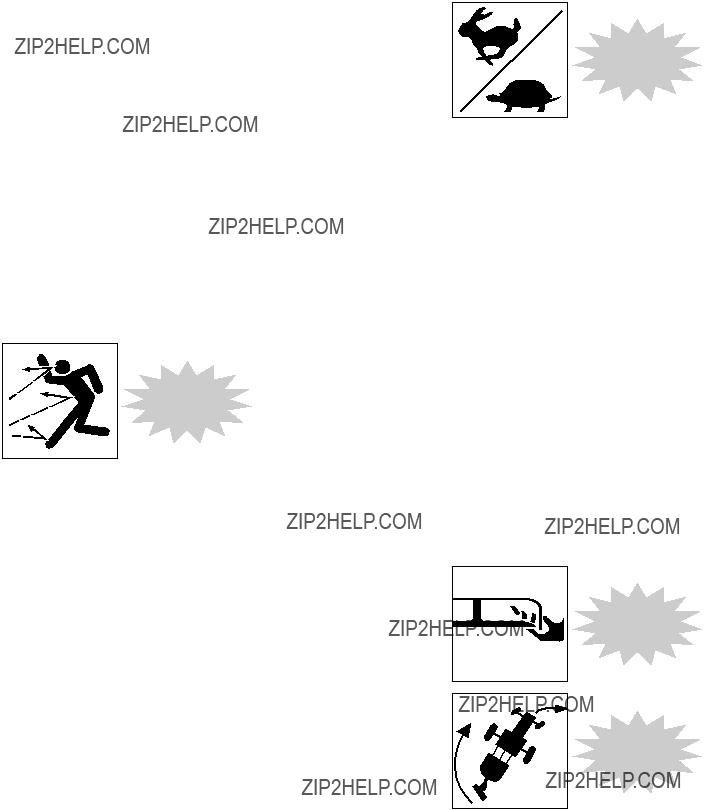
Objetos arrojados por la cortadora de c??sped (continuaci??n)
Cortadoras de disco ??? Cuando se usa una cortadora de disco, es importante conocer la zona donde se va a cortar. Si el operador ha realizado cortes en el terreno antes y est?? familiarizado con todos los obst??culos que puede haber, es suficiente observar delante de la trayectoria de la cortadora para detectar cualquier objeto adicional que pueda haber ingresado en el terreno. Est?? preparado para detenerse o evitar objetos que podr??an ser peligrosos si son arrojados por la cortadora. Si piensa cortar en un terreno que no conoce bien y se encuentra junto a un camino transitado o puede haber personas
a menos de 100 pies (30 m) de la cortadora de c??sped, debe inspeccionar y limpiar o marcar el terreno.
C??mo cortar en retroceso
No corte mientras se desplaza en retroceso. Es m??s probable que se arrojen objetos y que ??stos puedan llegar m??s lejos.
No corte en retroceso
Apague la TDF, espere que las hojas dejen de girar, eleve la cortadora y, despu??s, retroceda.
Corte desplaz??ndose en sentido de avance.
Use la velocidad de desplazamiento correcta
Velocidad de desplazamiento durante el corte
La velocidad de desplazamiento correcta depende de las condiciones del terreno y del tipo de hierba, la densidad y la altura que debe cortarse:
???El rango normal de velocidad de desplazamiento es de 2 a 5 mph (3.2 a 8 km/h).
???Use una velocidad de desplazamiento menor para cortar hierbas altas y densas.
???Use una velocidad de desplazamiento mayor para cortar hierba delgada a altura media y con condiciones de terreno sin dificultades.
???Use una velocidad de desplazamiento menor par acortar en terreno irregular, con pendientes o no muy conocido.
Las cortadoras de disco est??n dise??adas para usar velocidades de desplazamiento mayores cuando funcionan en terrenos despejados de residuos y peligros superficiales.
Corte de hierba extremadamente alta
Puede ser necesario cortar dos veces la hierba extremadamente alta que no sea cultivo. (Consulte la p??gina 13, Objetos arrojados por la cortadora de c??sped.)
Primera pasada de corte:
???Apague la cortadora y el tractor usando la pr??ctica correcta de apagado de equipos antes de descender del tractor. (Consulte la p??gina 18, Pr??cticas correctas de apagado de los equipos.)
???Inspeccione la zona y retire o marque cualquier residuo u obst??culo.
???Corte la hierba a mayor altura (10 a 15 pulg. [25 a 38 cm]) para evitar los objetos ocultos.
Segunda pasada de corte:
???Apague la cortadora y el tractor usando la pr??ctica correcta de apagado de equipos antes de descender del tractor.
???Inspeccione la zona y retire o marque cualquier residuo u obst??culo.
???Corte la hierba a la altura deseada y, de ser posible, a
90 grados con respecto a la primera pasada de corte.
Detenga
la hoja antes de desatascar
Proporcione el espacio libre adecuado para la oscilaci??n de la cortadora de c??sped
Preste atenci??n a los espacios libres de los equipos
Las cortadoras con enganche de tres puntos y montaje lateral tienen un arco de giro mayor que las tipo de tiro. Deje el espacio libre suficiente para la oscilaci??n de la cortadora cuando gira.
No permita que haya personas ajenas cerca del tractor y la cortadora de c??sped cuando mueve o transporta el tractor y la cortadora.
Operaci??n con seguridad
Pr??cticas de seguridad para la cortadora de c??sped de montaje inferior
Cuando se traslada con una cortadora de c??sped de montaje inferior:
???Mantenga la rampa de descarga extra??ble en su lugar y por encima de la abertura de descarga.
???Nunca se pare sobre la carcasa de una cortadora de c??sped cuando el motor del tractor est?? en funcionamiento.
???Distribuya los recortes de hierba con la rampa de descarga orientada hacia la zona donde se cort??.
???Antes de limpiar una cortadora o una rampa de descarga atascada, apague la m??quina usando la pr??ctica correcta para apagado del equipo. (Consulte la p??gina 18, Pr??cticas correctas de apagado de los equipos.)
Nunca se pare sobre la cortadora de c??sped ??? Mant??ngase alejado
Mantenga la rampa en su lugar
Detenga
la hoja antes de desatascar
Operaci??n con seguridad
Cortadora de c??sped con lateral o aguil??n Peligros y riesgos de obstrucciones elevadas
Verifique en busca de obstrucciones elevadas con las cortadoras que tienen el lateral o el aguil??n elevado, para evitar lesiones graves o la muerte por contacto con:
???L??neas y aparatos el??ctricos.
???Ramas bajas de los ??rboles.
???Otras obstrucciones elevadas.
???Mantenga las distancias especificadas con respecto a los cables y los aparatos el??ctricos. Nunca se acerque a cables o aparatos el??ctricos energizados con ninguna parte de la m??quina, salvo que se hayan tomado todas las precauciones de seguridad locales, estatales/ provinciales y federales (OSHA) necesarias. Use extrema precauci??n.
??PELIGRO! Evite la electrocuci??n o lesiones graves por contacto o un espacio libre inadecuado con respecto a l??neas o aparatos el??ctricos energizados. No permita que la m??quina o el accesorio se acerque o entre en
contacto con una l??nea de electricidad. No se acerque ni toque una m??quina que est?? en contacto con una l??nea de electricidad.
No se acerque a l??neas de electricidad energizadas
Mant??ngase alejado de los equipos energizados
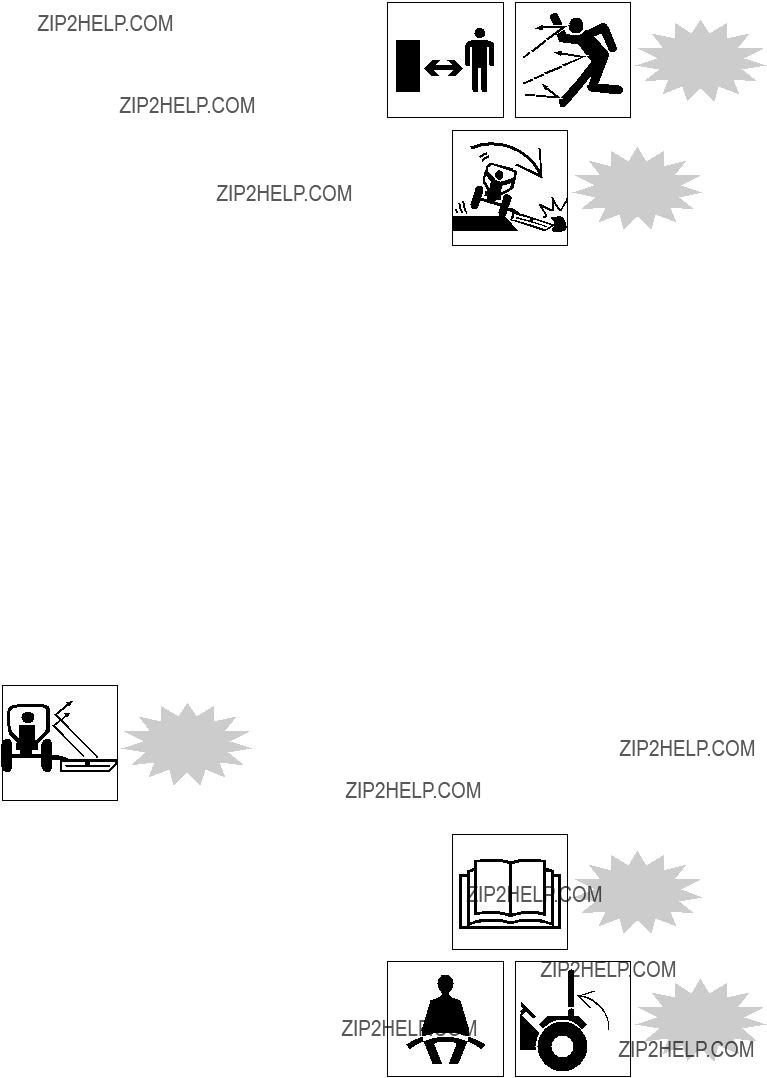
Pr??cticas de seguridad para cortadoras de c??sped con laterales y montaje lateral
Las posiciones elevadas de los laterales reducen la protecci??n de los escudos y aumentan los riesgos de objetos arrojados y contacto con las hojas.
Evite la posibilidad de lesiones graves o muerte por objetos arrojados o contacto con las hojas causados por la elevaci??n y el descenso de los laterales durante las operaciones de corte:
???No realice cortes con personas ajenas presentes a menos de 300 pies (92 m) de la cortadora de c??sped.
???Aseg??rese de que no haya personas cerca de la cortadora mientras se elevan o descienden los laterales.
???Apague la TDF y espere hasta que todos los elementos giratorios se hayan detenido antes de elevar la plataforma o la secci??n lateral de la cortadora.
?????nicamente eleve el lateral para quitar objetos de la trayectoria de corte o para acompa??ar una pendiente del terreno.
???Descienda hasta el suelo el lateral elevado una vez que se elimin?? el objeto o se super?? la pendiente.
???Detenga el trabajo de corte si alguna persona se acerca a menos de 300 pies (92 m) de la zona de corte.
Evite golpear obstrucciones
Pr??cticas de seguridad para trabajos de corte en orillas de zanjas
Use extremo cuidado al realizar cortes en orillas de zanjas. Preste atenci??n a escurrimientos, zonas
erosionadas y obstrucciones para el corte a lo largo de las orillas de zanjas. Si se golpean obstrucciones con cortadoras de montaje lateral o con aguil??n, el extremo delantero del tractor puede desviarse hacia la zanja.
Los trabajos en orillas de zanjas con aguil??n y lateral elevado pueden reducir la eficacia de la protecci??n del operador de la cortadora que proporcionan los escudos para objetos arrojados.
Utilice cabinas cerradas con ROPS o cerramientos de protecci??n
???Cuando realice estas operaciones, use cabinas cerradas con ROPS, cerramientos protectores especiales y otros escudos para el operador que ofrece el fabricante.
???Inspeccione la zona de corte y retire o marque todos los objetos extra??os y los residuos que deber?? esquivar la cortadora.
de que el ROPS est?? elevado y trabado en su lugar y use siempre el cintur??n de seguridad.
Prevenga los vuelcos del tractor y de la cortadora de c??sped y mantenga controlada la estabilidad de los equipos:
???Repase los manuales del operador del tractor y de la cortadora para ver las pr??cticas de seguridad para operaciones en pendientes y terrenos desparejos. Explique las pr??cticas a los operadores que no puedan leerlas.
???Evite trabajar en pendientes extremadamente empinadas.
Lea y aseg??rese de comprender los manuales antes de comenzar la operaci??n
Pr??cticas de seguridad para trabajos de corte en terrenos desparejos
Las pendientes y los terrenos desparejos reducen la estabilidad del tractor y de la cortadora.
Como en todas las condiciones de corte, use tractores equipados con ROPS y cintur??n de seguridad. Aseg??rese
Use el ROPS y el cintur??n de seguridad

Pr??cticas de seguridad para trabajos de corte en terrenos desparejos (continuaci??n)
???Use extremo cuidado para mantener el control de los equipos cuando trabaja en estas condiciones.
???Aumente la estabilidad del tractor agregando pesos o lastre en las ruedas y aumentando al m??ximo la separaci??n entre las ruedas. Consulte las recomendaciones en el manual del operador.
???Mantenga la velocidad de desplazamiento en el m??nimo.
???Realice giros amplios y graduales.
???Evite los arranques, las paradas y los giros bruscos cuando trabaje en subidas o bajadas de pendientes o sobre ellas.
???No levante del suelo las cortadoras de montaje trasero o de montaje lateral ni los laterales de la cortadora durante estas operaciones.
???Mant??nganse alerta en busca de agujeros, baches, pozos, tocones u otras obstrucciones que podr??an hacer volcar la m??quina.
???Evite las condiciones de suelo resbaladizo que podr??an causar la p??rdida de control y el vuelco del tractor y la cortadora.
???Evite bajar completamente y golpear el suelo cuando cruza en sentido diagonal depresiones marcadas y hundimientos.
Mantenga el control, despl??cese
Agregue lastre, ensanche la separaci??n entre las ruedas
Evite los pozos, baches y agujeros
Use extremo cuidado al mantener la estabilidad de los equipos durante todos los trabajos de corte en terrenos desparejos y pendientes. Usted es quien juzga en ??ltima instancia si en cualquier pendiente se puede trabajar con seguridad.
Pr??cticas de seguridad para el transporte en caminos
Antes de operar en la v??a p??blica:
???Consulte los manuales del operador de los fabricantes de la cortadora y del tractor para ver instrucciones.
???Explique las instrucciones a los usuarios u operadores que no puedan leerlas.
???Verifique las ordenanzas locales sobre marcas, luces, balizas, etc. requeridas en los equipos durante el desplazamiento por la v??a p??blica. Se requieren luces en las cortadoras que obstaculizan la visibilidad de las luces traseras y/o las luces de advertencia del tractor.
???Cuando transporte la cortadora de c??sped en un remolque, siga las instrucciones detalladas del fabricante para la carga, el amarre y la descarga de la cortadora.
Antes de transportar en la v??a p??blica:
???Desconecte la alimentaci??n de la TDF a la cortadora.
???Eleve la cortadora a la posici??n de transporte y aplique la traba para transporte.
???Trabe los laterales de la cortadora de c??sped en la posici??n de transporte con dispositivos de bloqueo aprobados.
???Instale una cadena de seguridad para remolque entre la cortadora tipo de tiro y el tractor.
???Aseg??rese de que las luces, las luces de advertencia y los reflectores est??n en su lugar y son visibles.
???Verifique que el emblema de veh??culo de movimiento le resulte visible a cualquier veh??culo que se aproxime por atr??s.
Durante el transporte en la v??a p??blica:
???Obedezca todas las ordenanzas de tr??nsito locales.
???Ac??rquese a las intersecciones con precauci??n.
???Observe los letreros de velocidad y control del tr??nsito.
???Evite las paradas de emergencia y los giros cerrados.
Sea un operador amable y ap??rtese peri??dicamente para dejar pasar el tr??nsito.
Lea y aseg??rese de comprender los manuales antes de comenzar la operaci??n

Pr??cticas de seguridad para el estacionamiento
???Use las zonas designadas o alejadas del tr??nsito.
???Use lugares con suelo firme y nivelado.
???Aplique el freno de estacionamiento.
???Descienda el equipo de la cortadora de c??sped hasta el suelo.
Apague la cortadora y el tractor usando la pr??ctica correcta de apagado de equipos antes de descender del tractor. (Consulte la p??gina 18, Pr??cticas correctas de apagado de los equipos.)
Lugares de estacionamiento con suelo en pendiente:
???Ubique los equipos transversalmente con respecto a la pendiente.
???Aplique los frenos de estacionamiento.
???Descienda el equipo de la cortadora de c??sped hasta el suelo.
???Bloquee las ruedas del tractor.
PAplique el freno de estacionamiento
Descienda
los equipos elevados hasta el suelo
Antes de estacionar temporalmente y dejar equipos deshabilitados cerca de zonas con tr??nsito:
???Retire los equipos de la v??a p??blica.
???Instale banderas de advertencia.
???Use las balizas de advertencia del tractor.
Apagado con seguridad
Pr??cticas correctas de apagado de los equipos
Transforme el apagado correcto de los equipos en un h??bito.
El apagado correcto de un tractor y una cortadora de c??sped puede ayudar a evitar accidentes cuando la cortadora est?? sin vigilancia. Apague la cortadora siguiendo los procedimientos espec??ficos del manual del operador del fabricante. Estos procedimientos normalmente incluir??n:
???Reduzca la velocidad del motor.
???Desenganche el embrague de la TDF y la transmisi??n.
???Haga funcionar el motor en ralent?? para que se enfr??e gradualmente.
???Coloque todos los controles en la posici??n de estacionamiento.
???Aplique el freno de estacionamiento.
???Descienda la cortadora de c??sped hasta el suelo.
???Descienda los laterales de las cortadoras con laterales hasta el suelo.
???Apague el motor, trabe la ignici??n y retire la llave de la m??quina; ll??vela con usted.
???Espere hasta que todas las piezas m??viles se hayan detenido antes de descender.
???Libere la presi??n hidr??ulica moviendo los controles hidr??ulicos varias veces en todas las direcciones.
???Trabe las cubiertas y los cerramientos antivandalismo, si est??n instalados, cuando los equipos est??n sin vigilancia.
???Descienda con cuidado manteniendo contacto de tres puntos.
PTO
Desenganche la TDF, STOPaplique el freno
P
Descienda los equipos elevados hasta el suelo
Espere hasta que las piezas giratorias se detengan
Retire la llave, trabe la ignici??n, ll??vese la llave
Apagado con seguridad
Descenso correcto
???Nunca descienda de equipos en movimiento.
???Nunca baje de una m??quina saltando.
???Descienda con cuidado.
???Verifique que no haya pelda??os resbaladizos.
???Mantenga los pies y las manos lejos de los controles.
???Use los asideros y los pelda??os durante el descenso.
???Enfrente la m??quina y use contacto de tres puntos (2 manos y 1 pie o 2 pies y 1 mano).
Espere hasta que las piezas m??viles se detengan
Use contacto de tres puntos; enfrente a la m??quina
Realizaci??n de mantenimiento con seguridad
Mantenimiento de los equipos
Realice el mantenimiento de los equipos
Aseg??rese de mantener los equipos de acuerdo con las instrucciones del fabricante. Verifique con regularidad el funcionamiento de los dispositivos de protecci??n y de seguridad.
No realice ning??n trabajo en un tractor o en una cortadora de c??sped si no est?? autorizado y cualificado para hacerlo.
Si ha sido autorizado para realizar mantenimiento, lea los manuales del operador y de servicios. Estudie las instrucciones; verifique las tablas de lubricaci??n; examine todos los mensajes de instrucciones que haya sobre la m??quina. El mantenimiento puede ser peligroso si no se realiza correctamente. Aseg??rese de tener las habilidades necesarias, la informaci??n y las herramientas y equipos correctos para realizar el trabajo.
??ADVERTENCIA! No modi???que equipos ni agregue componentes no aprobados por el fabricante. Use piezas, lubricantes y t??cnicas de servicio recomendadas por el fabricante.
Piezas de la cortadora de c??sped y seguridad personal
Los fabricantes de cortadoras de c??sped usan sujetadores y espec??ficos y piezas especialmente dise??adas para cumplir con los requisitos de las operaciones de las cortadoras. Las piezas cr??ticas (pernos autobloqueantes de las hojas, hojas, pasadores, escudos y otros componentes especiales) tienen requisitos espec??ficos de resistencia, dise??o y ajuste para la marca y el modelo de cortadora que usted est?? usando.
Evite posibles lesiones graves o la muerte por el uso de piezas o modificaciones no aprobadas:
???No sustituya con torniller??a com??n los pernos de las hojas u otros componentes de piezas especiales originales del fabricante.
???No sustituya hojas, pasadores, escudos u otras piezas cr??ticas.
???No use pernos de mayor resistencia para reemplazar los pernos de seguridad originales del fabricante.
Realizaci??n de mantenimiento con seguridad
Preparaci??n personal
Use la ropa de protecci??n personal y los equipos de protecci??n personal (PPE) que se le proporcionen o que requieran las condiciones del trabajo. SIEMPRE debe usar gafas de seguridad con escudos laterales.
Puede necesitar tambi??n:
???Casco
???Calzado de seguridad
???Anteojos de seguridad, antiparras o protecci??n facial
???Delantal y guantes
???Protecci??n para o??dos
???Casco o antiparras para soldar
???Respirador o m??scara con filtro
Use la ropa necesaria; no corra ning??n riesgo.
Mantenga las manos (y la ropa)alejadas de todas las piezas m??viles. No use cordones sueltos, mangas flojas, anillos, relojes o cabello largo.
??ADVERTENCIA! Evite lesiones graves o muerte por enredos. No use ropa ???oja ni accesorios. Mant??ngase alejado de todos los componentes giratorios cuando el motor est?? en funcionamiento. El contacto, el enrollado o el enredo con piezas giratorias o m??viles podr??an resultar en lesiones graves o la muerte.
Evite las piezas giratorias
Evite puntos donde pueda quedar atrapado
Realizaci??n de mantenimiento con seguridad
Use un delantal de caucho y guantes de caucho cuando trabaja con sustancias corrosivas. Use guantes y calzado de seguridad cuando manipula bloques de madera o metales con bordes agudos.
Use siempre anteojos de seguridad, antiparras o protecci??n facial. Proporcionan protecci??n ocular para fluidos bajo presi??n, mientras se esmerila y se realizan servicios a las bater??as. Tambi??n es necesaria protecci??n contra residuos, l??quidos y material suelto producido por el equipo, las herramientas y el aire/agua presurizada.
Use protecci??n facial y siga las instrucciones del fabricante cuando desarma componentes cargados a resorte o cuando trabaja con ??cidos de bater??a. Use un casco o antiparras para soldar con filtro esfumado cuando suelda o corta con soplete.
No arene, esmerile, corte con soplete o suelde sin un respirador aprobado por NIOSH o una ventilaci??n
adecuada. Si se requiere soldar en esta m??quina, consulte los manuales del operador o de servicios del fabricante o consulte al concesionario de los equipos para obtener los procedimientos correctos.
Mantenga los bolsillos sin objetos que podr??an salirse y caer dentro de la maquinaria.
Limpie las super???cies resbaladizas
Ventile la zona de trabajo
Maneje las herramientas y las piezas pesadas con sensatez con respecto a usted mismo y a otras personas. Deposite los elementos, no los deje caer.
Preparaci??n de la zona de trabajo
???Ubique la cortadora de c??sped en una zona nivelada fuera del paso de otros equipos en funcionamiento.
???Aseg??rese de que haya luz, ventilaci??n y espacio libre adecuados.
???Quite el aceite, la grasa o el agua para eliminar toda superficie resbaladiza.
???Limpie alrededor de la zona donde se realizar??n servicios para minimizar la contaminaci??n.
Realizaci??n de mantenimiento con seguridad
Preparaci??n de la m??quina
Deben controlarse o reducirse las fuentes de energ??a almacenada (el??ctricas, mec??nicas, hidr??ulicas, neum??ticas, qu??micas, t??rmicas, etc.) al m??nimo practicable antes de realizar cualquier procedimiento de mantenimiento, reparaci??n o servicio.
Pr??cticas de seguridad para prevenir posibles lesiones por fuentes que liberan energ??a:
???Desenganche la TDF antes de apagar el motor.
???Coloque los controles en la posici??n de estacionamiento o punto muerto antes de apagar el motor.
???Aplique el freno de estacionamiento o bloquee las ruedas.
???Espere hasta que todas las piezas m??viles se detengan.
???Descienda la cortadora de c??sped hasta el suelo.
???Descienda los laterales de las cortadoras con laterales hasta el suelo.
???Apague el motor del tractor.
???Libere la presi??n del sistema hidr??ulico moviendo los controles varias veces en todas las direcciones.
???Trabe la ignici??n, retire la llave y ll??vesela.
Prepare los sistemas de la m??quina para realizarles servicios
???Escuche y observe en busca de evidencias que indiquen piezas en movimiento antes de descender.
???Apoye o bloquee con seguridad la cortadora de c??sped antes de trabajar debajo de ella o de otros componentes elevados.
???Apoye, bloquee o trabe con seguridad los laterales de la cortadora con dispositivos de traba aprobados antes de trabajar cerca o debajo de una cortadora con laterales.
???Alivie la presi??n antes de desconectar o desarmar un sistema presurizado.
???Bloquee o alivie la presi??n de los resortes antes de desarmar un mecanismo cargado a resorte.
???Apoye o bloquee con seguridad cualquier componente elevado de la m??quina antes de trabajar en ??l.
???Evite las llamas, las chispas y no fume cerca de combustibles, fluido hidr??ulico u otro material inflamable como los residuos de los cortes.
Realizaci??n de mantenimiento con seguridad
Fije una etiqueta con la advertencia ???NO PONER EN FUNCIONAMIENTO??? en todas las palancas de control y retire la llave de contacto si la cortadora de c??sped no debe ser utilizada. Ll??vese la llave.
Instale dispositivos de apoyo aprobados cuando trabaja debajo o cerca de equipos elevados.
??ADVERTENCIA! Las cortadoras de c??sped u otros equipos elevados no apoyados pueden caerse de manera imprevista. Nunca se introduzca debajo de equipos elevados si no est??n apoyados en dispositivos de apoyo aprobados. La ca??da de equipos podr??a resultar en una lesi??n grave o la muerte por aplastamiento.
Retire s??lo las guardas o cubiertas que permiten acceder a la zona donde se realizar??n servicios. Vuelva a colocar todas las guardas y cubiertas cuando el trabajo est?? terminado.
Use una ???etiqueta que indique No poner en funcionamiento???
Utilice dispositivos de apoyo
aprobados
Vuelva a colocar todas las guardas
Realizaci??n de mantenimiento con seguridad
Use ventilaci??n adecuada
Si es necesario hacer funcionar un motor en una zona cerrada, elimine del ??rea las emanaciones de escape con una extensi??n del ca??o de escape. Si no tiene esa extensi??n, aseg??rese de abrir las puertas y dejar entrar aire del exterior.
??ADVERTENCIA! Evite posibles lesiones. Nunca trabaje en la maquinaria con el motor en funcionamiento salvo que as?? lo indiquen los manuales del fabricante para un servicio en particular.
??ADVERTENCIA! Nunca haga funcionar ning??n tipo de motor sin la ventilaci??n adecuada: LAS EMANACIONES
DEL ESCAPE PUEDEN SER MORTALES.
Use gatos y malacates con cuidado
Los soportes o bloques de seguridad deben ubicarse en una parte r??gida de la cortadora. No ubique soportes debajo de ejes o apoyos de ruedas que puedan girar.
Si debe trabajar debajo de equipos elevados, siempre use bloques de madera (no de concreto), soportes de gato u otros soportes r??gidos y estables. Cuando use gatos o malacates, siempre aseg??rese de que est??n correctamente apoyados.
??ADVERTENCIA! Evite posibles lesiones por aplastamiento. Nunca use bloques de concreto para apoyo. Pueden colapsar bajo cargas incluso livianas.
Retire la llave y lea el manual de mantenimiento
Ventile la zona de trabajo
Use un apoyo adecuado para los equipos elevados
Aseg??rese de que los malacates o gatos que usa est??n en buenas condiciones. Nunca use gatos con piezas rajadas, dobladas o retorcidas. Nunca use cables pelados, retorcidos o pellizcados. Nunca use ganchos doblados o deformados.
Realizaci??n de mantenimiento con seguridad
Pr??cticas de seguridad para tareas de mantenimiento comunes
Riesgos del combustible
??ADVERTENCIA! Siempre use recipientes y/o equipos de distribuci??n de combustible aprobados.
Los combustibles son inflamables; por eso, debe cumplir estas pr??cticas con el fin de reducir la posibilidad de un accidente grave.
???Apague el motor y la ignici??n mientras carga combustible.
???Siempre conecte a tierra la boquilla de combustible contra el cuello de llenado del dep??sito para evitar chispas.
???Mantenga las chispas y llamas abiertas alejadas del combustible.
???No fume mientras carga combustible o manipula recipientes con combustible.
???No corte ni suelde en l??neas, tanques o recipientes de combustible ni cerca de ellos.
???No llene el dep??sito en exceso o derrame combustible. Limpie el combustible derramado de inmediato.
Riesgos del refrigerante de motor
Los sistemas de refrigeraci??n con l??quidos acumulan presi??n a medida que el motor se calienta; tenga suma precauci??n antes de retirar la tapa del radiador. Aseg??rese de:
???Detener el motor y esperar que el sistema se enfr??e.
???Usar ropa de protecci??n y anteojos de seguridad.
???Girar la tapa del radiador lentamente hasta el primer tope para permitir que la presi??n escape antes de retirar la tapa por completo.
No fumar; evitar las llamas abiertas
Retire la tapa del radiador lentamente
Realizaci??n de mantenimiento con seguridad
Riesgos del sistema hidr??ulico
El sistema hidr??ulico se encuentra bajo presi??n siempre que el motor est?? funcionando; puede conservar presi??n incluso despu??s de apagar el motor. Haga funcionar todos los controles hidr??ulicos incluyendo el control hidr??ulico auxiliar despu??s de que el motor est?? apagado. Alivie la presi??n atrapada en las l??neas despu??s de que los accesorios est??n apagados y apoyados en el suelo.
Durante la inspecci??n del sistema hidr??ulico:
???Espere que el fluido se enfr??e antes de desconectar las l??neas. El fluido hidr??ulico caliente puede causar
QUEMADURAS GRAVES.
???No use las manos para verificar la presencia de fugas. En cambio, use un cart??n o papel para buscar fugas.
???Use protecci??n ocular adecuada. El fluido hidr??ulico puede causar lesiones oculares permanentes.
??ADVERTENCIA! El fluido hidr??ulico bajo presi??n pueden penetrar la piel o los ojos y causar lesiones graves, ceguera o la muerte. Las fugas de fluido bajo presi??n pueden no ser visibles. Utilice un cart??n o una madera para buscar fugas, no la mano. Use una protecci??n facial o antiparras de seguridad para proteger los ojos. Si el fluido se inyecta en la piel, debe ser extra??do dentro de las pr??ximas pocas horas por personal m??dico familiarizado con este tipo de lesi??n.
Cuando ventila o llena el sistema hidr??ulico, afloje la tapa de llenado con lentitud y ret??rela gradualmente.
Nunca restablezca una v??lvula de alivio del sistema hidr??ulico a una presi??n mayor que la recomendada por el fabricante.
Use protecci??n ocular
El ???uido a alta presi??n puede
inyectarse en el cuerpo
Realizaci??n de mantenimiento con seguridad
Riesgos del sistema el??ctrico
Antes de trabajar en el sistema el??ctrico, desconecte los cables de la bater??a.
???Retire primero los cables negativos (-) de la bater??a.
???Al reconectar la bater??a, conecte los cables negativos (-) de la bater??a al final.
El l??quido del interior de las bater??as contiene ??cido, que es un VENENO y puede causar QUEMADURAS
QU??MICAS GRAVES.
Evite lesiones
???Use una protecci??n facial para evitar el contacto con los ojos.
???Use guantes y ropa resistentes a los productos qu??micos para mantener al electrolito alejado de la piel y la ropa com??n.
??ADVERTENCIA! El contacto con el electrolito da??a los ojos y la piel. Siempre use una protecci??n facial para evitar que el electrolito penetre en los ojos. Si el electrolito entra en contacto con los ojos, enjuague de inmediato con agua limpia y busque atenci??n m??dica.
Use guantes de caucho y ropa de protecci??n para mantener el electrolito lejos de la piel. Si el electrolito entra en contacto con la piel o la ropa, lave de inmediato con agua limpia.
Si se ingiere, busque atenci??n m??dica de inmediato. NUNCA proporcione l??quidos que induzcan el v??mito.
Use protecci??n facial
Use indumentaria de protecci??n
Realizaci??n de mantenimiento con seguridad
Evite explosiones
??ADVERTENCIA! Evite posibles lesiones graves por explosiones. Las bater??as de plomo-??cido producen gases sumamente explosivos, especialmente durante la carga. Mantenga alejados los arcos, las chispas, las llamas y el tabaco encendido.
???No fume cerca de las bater??as.
???Mantenga los arcos, las chispas y llamas abiertas alejadas de las bater??as.
???Proporcione ventilaci??n adecuada.
Nunca revise la bater??a colocando un objeto met??lico entre los bornes: la chispa resultante podr??a causar una explosi??n.
??ADVERTENCIA! Evite posibles lesiones graves por explosiones de bater??as. No cargue bater??as ni arranque con refuerzo el motor si la bater??a est?? congelada.
Caliente a 60 ??F (15,5 ??C) o la bater??a puede explotar y causar lesiones graves.
Reglas de seguridad durante el arranque con refuerzo de bater??a:
???Siga las instrucciones para el ???arranque con refuerzo de bater??a??? correcto como se especifica en el manual del fabricante.
???Aseg??rese de que las m??quinas no se est??n tocando.
???Observe la polaridad de las bater??as y conexiones.
???Realice la conexi??n final de cable al motor o al punto de tierra m??s alejado de la bater??a. Nunca realice la conexi??n final en el arrancador o la bater??a muerta: las chispas pueden encender gases explosivos presentes en la bater??a.
???Cuando desconecta cables despu??s de un arranque con puente, retire los cables en el orden inverso al de la conexi??n (es decir, la conexi??n final primero).
Evite las chispas y las llamas abiertas
cerca de las bater??as
Para el arranque con refuerzo, observe la polaridad y realice la conexi??n ???nal en el punto de descarga a tierra
Realizaci??n de mantenimiento con seguridad
Mantenimiento de neum??ticos y ruedas
Revise los neum??ticos y las ruedas a diario porque la estabilidad del tractor y la cortadora de c??sped puede verse significativamente afectada por la presi??n de los neum??ticos o da??os en los neum??ticos o en las ruedas.
Revise los neum??ticos para verificar:
???La presi??n correcta.
???Cortes y protuberancias.
???Clavos u otras pinchaduras.
???Desgaste desparejo o excesivo.
???Estado de los v??stagos y tapas de las v??lvulas.
Revise las ruedas para verificar:
???Da??os en las llantas.
???Tuercas o pernos faltantes o flojos.
???Desalineaci??n.
Todos los servicios de neum??ticos deben ser realizados por un centro de servicios para neum??ticos cualificado o por una persona de servicio autorizada debidamente capacitada en los procedimientos y el uso del equipo de seguridad destinado a los servicios de neum??ticos.
Revise los neum??ticos y las ruedas en busca de da??os
Mantenga la presi??n correcta en los neum??ticos
Realizaci??n de mantenimiento con seguridad
Mantenimiento de neum??ticos y ruedas (continuaci??n)
??ADVERTENCIA! Los tipos de ruedas y neum??ticos que generalmente se encuentran en estos equipos requieren cuidados especiales al realizar servicios para evitar lesiones graves o la muerte.
No infle los neum??ticos por encima de la presi??n recomendada. Aseg??rese de volver a colocar el lastre de los neum??ticos si est?? instalado. Consulte las especificaciones del fabricante para ver los requisitos de lastre.
Mantenga las tuercas de las ruedas apretadas seg??n las recomendaciones del fabricante.
Es normal que la presi??n de los neum??ticos aumente durante el funcionamiento; NO se debe reducir.
Nunca vuelva a inflar un neum??tico que se ha desinflado mucho o por completo sin retirar el neum??tico de la rueda. Haga inspeccionar atentamente el neum??tico y la rueda para detectar da??os antes de volverlos a armar.
Al agregar aire a un neum??tico, h??galo desde cierta distancia. Use una manguera larga con mandril de autofijaci??n. Siempre p??rese detr??s de la trocha cuando ajusta la presi??n de un neum??tico.
Evite la explosi??n de los neum??ticos
No infle neum??ticos con gases inflamables o con sistemas que usan un inyector de alcohol.
Nunca corte o suelde una rueda con un neum??tico inflado instalado en ella. Esto podr??a causar descompresi??n explosiva.
Verifique que el tama??o del neum??tico y la rueda coincidan correctamente.
Cuando reemplaza neum??ticos, aseg??rese de que sean de la clasificaci??n adecuada especificada por el fabricante.
Los neum??ticos no deben funcionar a velocidades m??s altas que las nominales. La mayor??a de los neum??ticos para agricultura est??n clasificados para una velocidad m??xima de 20 mph (32 km/h).
Realizaci??n de mantenimiento con seguridad
Servicio y reparaciones completas antes de liberar la m??quina
Apriete todos los pernos, accesorios y conexiones con las torsiones especificadas por el fabricante.
Instale todas las guardas, cubiertas y escudos despu??s de realizar los servicios. Reemplace o repare los que est??n da??ados. Llene y recargue los sistemas a presi??n s??lo con los fluidos aprobados o recomendados por el fabricante.
Arranque el motor y revise para detectar fugas. (Consulte la p??gina 23, Riesgos del sistema hidr??ulico.) Haga funcionar todos los controles para asegurarse de que el tractor y la cortadora de c??sped funcionan correctamente. Pruebe la m??quina si es necesario. Despu??s de las pruebas, apague y verifique el trabajo realizado. ??Falta alg??n pasador, arandela, tuerca de seguridad, etc.? Vuelva a revisar todos los niveles de fluidos antes de liberar la m??quina para el funcionamiento.
Todas las piezas deben ser inspeccionadas durante la reparaci??n y deben reemplazarse si est??n gastadas, rajadas o da??adas. Las piezas excesivamente gastadas o da??adas pueden fallar y causar lesiones o la muerte.
Reemplace cualquier letrero da??ado o ilegible.
Veri???que el trabajo de servicio cuando est?? completo
Mantenimiento de las hojas de la cortadora
No corra riesgos usando hojas da??adas o dobladas. Los fabricantes de cortadoras de c??sped de la Asociaci??n de Fabricantes de Equipos (Association of Equipment Manufacturers, AEM) y la Asociaci??n de Fabricantes de Equipos para Agricultura (Farm Equipment Manufacturers Association, FEMA) piden que las hojas de cortadoras
NO se reutilicen, enderecen, refuercen en su superficie o suelden. Si una hoja rota es arrojada por una cortadora, podr??an producirse lesiones graves o la muerte.
Realizaci??n de mantenimiento con seguridad
Mantenimiento de las hojas de la cortadora (continuaci??n)
?????C??mo est??n hechas las hojas de la cortadora de c??sped? Est??n hechas acero para resortes de aleaci??n de alta resistencia. Se forjan en caliente y se les da forma para cumplir con las especificaciones individuales del fabricante; luego, se tratan y templan a un estado d??ctil, de alta resistencia para reducir la posibilidad de rupturas durante el corte. Las hojas se prueban para garantizar que cumplan con las normas de resistencia, dureza y ductilidad. Si una hoja no cumple con alguna de estas especificaciones, no se utilizar?? en la cortadora de c??sped.
?????Qu?? sucede cuando se dobla una hoja de la cortadora? Se necesita una gran fuerza de impacto para doblar la hoja. Esta fuerza de impacto a menudo resulta en que las hojas se agujerean o marcan. Una vez que una hoja est?? da??ada por un agujero o una marca, es mucho m??s probable que ocurra una falla de la hoja. Cuando una hoja est?? gravemente doblada, puede crearse una rajadura microsc??pica en ella. Enderezar la hoja no quita o repara esta rajadura, sino que puede causar rajaduras adicionales.Tensiones adicionales durante los trabajos de corte pueden resultar en una falla imprevista de la hoja.
???Evite doblar las hojas. Contribuya a prevenir que las hojas de la cortadora se doblen o rajen evitando el contacto con objetos s??lidos. Las hojas de la cortadora de c??sped est??n destinadas a cortar hierba, arbustos, vegetaci??n le??osa y ??rboles y ramas peque??os. No est??n dise??adas para entrar en contacto con objetos s??lidos como roca, cemento o postes de acero. Inspeccione la zona antes de usar la cortadora. Retire o marque claramente los objetos s??lidos y corte alrededor de ellos.
???Sustituya las hojas da??adas! Inspeccione las hojas de la cortadora diariamente o despu??s de golpear alg??n objeto s??lido. Si una hoja de la cortadora de c??sped se da??a (est?? doblada, agujereada, rajada) o desgasta m??s del 25 por ciento del tama??o original, debe retirarse y sustituirse con una nueva. Siempre use las hojas originales del fabricante. Las hojas de marcas no originales pueden no cumplir con los requisitos de resistencia, dureza y ductilidad del fabricante de la cortadora.
???No corra riesgos usando hojas da??adas o dobladas.
El uso de una hoja de cortadora da??ada o enderezada puede resultar en la ruptura de la hoja y que la hoja sea arrojada hacia el operador o una persona ajena causando una lesi??n grave o la muerte. El precio
de una nueva hoja es bajo en comparaci??n con la posibilidad de una lesi??n grave que podr??a resultar de una hoja doblada o rota arrojada por la cortadora
Palabras ???nales para el usuario
Acaba de terminar de leer el Manual de la cortadora de c??sped industrial y para agricultura AEM. Es imposible que este manual abarque todas las situaciones
de seguridad que se podr??a encontrar a diario. Su conocimiento de estas precauciones de seguridad y de su cumplimiento de las reglas b??sicas de seguridad
contribuir??n a formar un buen juicio en todas las situaciones. Nuestro objetivo es ayudarlo a desarrollar, establecer y mantener buenos h??bitos de seguridad para que la operaci??n de una cortadora de c??sped industrial y para agricultura le resulte m??s f??cil y m??s segura.
??ste es otro manual de una serie publicada por AEM sobre la operaci??n de maquinaria en condiciones de seguridad. Muchas de las ilustraciones de este manual de seguridad se pueden encontrar y descargar en http://pictorials.aem.org.
Para obtener publicaciones adicionales, visite nuestro sitio web en www.safetymaterials.org.
ASOCIACI??N DE FABRICANTES
DE EQUIPOS
Correo electr??nico: safetymaterials@aem.org
www.aem.org
INTRODUCTION SECTION
Introduction Section 2-1
?? 2011 Alamo Group Inc.
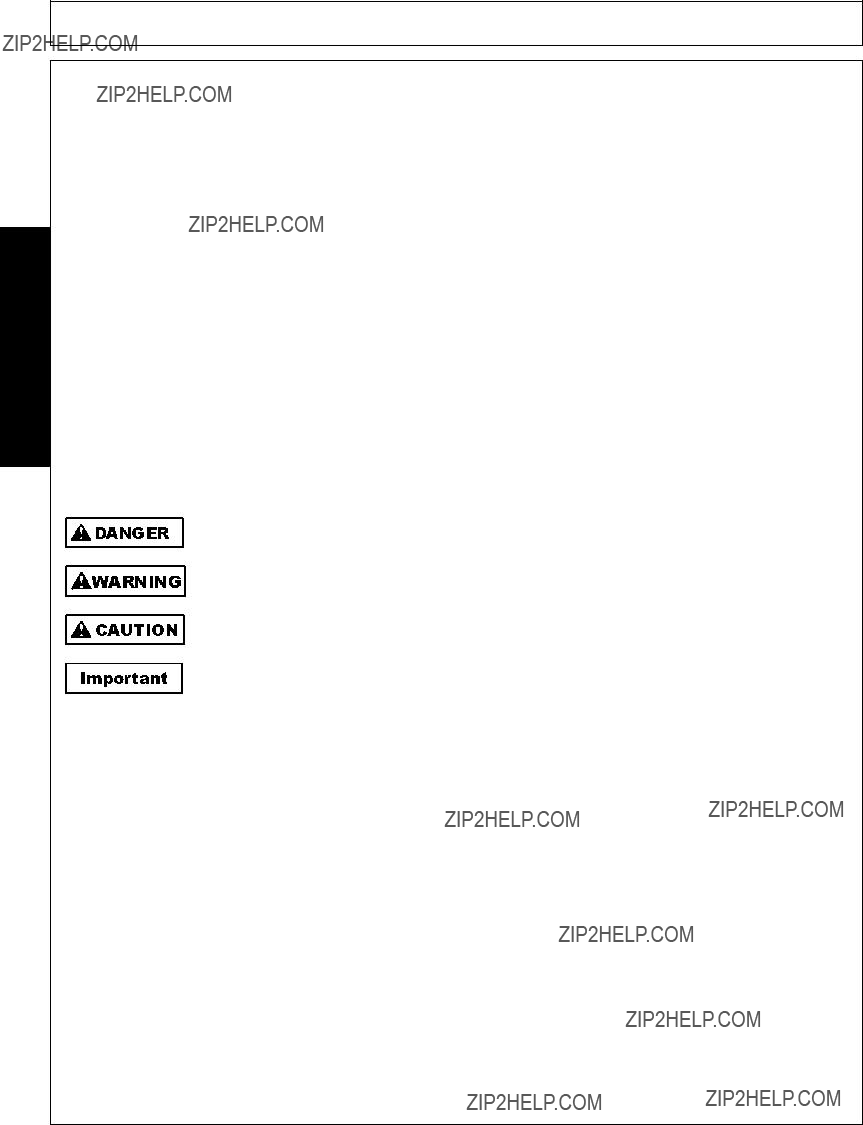
INTRODUCTION
This Finishing Mower is designed with care and built with quality materials by skilled workers. Proper assembly, maintenance, and operating practices, as described in this manual, will help the owner/operator get years of satisfactory service from the machine.
The purpose of this manual is to familiarize, and instruct. The Assembly Section instructs the owner/operator in the correct assembly of the Mower using standard and optional equipment. The Parts Listing section is designed to familiarize the owner/operator with replaceable parts on the Mower. This section provides exploded assembly drawings of each mower component illustrating each piece and the corresponding part number.
Careful use and timely service saves extensive repairs and costly downtime losses. The Operation and Maintenance Sections of the manual train the owner/operator how to work the Mower correctly and attend to appropriate maintenance. The Trouble Shooting Guide helps diagnose difficulties with mower and offers solution to the problems.
Safety is of primary importance to the owner/operator and to the manufacturer. The first section of this manual includes a list of Safety Messages, that, if followed, will help protect the operator and bystanders from injury or death. Many of the Safety Messages will be repeated throughout the manual. The owner/operator/dealer should know these Safety Messages before assembly and be aware of the hazards of operating this mower during assembly, use, and maintenance. The Safety Alert Symbol combined with a Signal Word, as seen below, is intended to warn the owner/operator of impending hazards and the degree of possible injury faced when operating this machine.
Indicates an imminently hazardous situation that, if not avoided, WILL result in DEATH OR
VERY SERIOUS INJURY.
Indicates an imminently hazardous situation that, if not avoided, COULD result in DEATH
OR SERIOUS INJURY.
Indicates an imminently hazardous situation that, if not avoided, MAY result in MINOR
INJURY.
Identifies special instructions or procedures that, if not strictly observed, could result in damage to, or destruction of the machine, attachments or the environment.
?? 2011 Alamo Group Inc.
INTRODUCTION
INTRODUCTION
Your RHINO TM finishing mower is designed for light-duty cutting such as lawn maintenance plus small weed and grass control. With a reasonable amount of preventive maintenance, your Mower will provide years of dependable service.
NEVER ALLOW CHILDREN TO OPERATE, RIDE ON, OR COME CLOSE TO MOWER OR TRACTOR. Usually, 15-16 year-old children who are mature and responsible can operate the mower with reasonable safety if they have read Operator???s Manual, been trained in safe operation of the machine, and are physically large and strong enough to reach and operate controls easily.
For Non-Agricultural use, OSHA, ASABE, SAE, and ANSI standards require the use of chain Chain Guards, Deflectors, or Solid Skirts at all times. The Mower manufacturer strongly recommends the use of Chain Guards or Solid Skirts for Agricultural purposes as well, to reduce the risk of property damage, serious bodily injury, or even death from objects thrown out by or from contact with the cutting blades.
At least 20% of the tractor???s weight must be on the front tires with the Mower lifted to provide adequate traction for safe steering under good conditions. Slow down on hills, rough terrain, and curves.
Front and rear and left and right are determined by the normal direction of travel, the same as driving an automobile.
?? 2011 Alamo Group Inc.
INTRODUCTION
Attention Owner/Operator
BEFORE OPERATING THIS MACHINE:
1.Carefully read the Operator???s Manual, completely understand the Safety Messages and instructions, and know how to operate correctly both the tractor and implement.
2.Fill out the Warranty Card in full. Be sure to answer all questions, including the Serial Number of the implement. Mail within 30 days of delivery date of this implement.
NOTE: Warranties are honored only if completed ???Owner Registration and Warranty??? forms are received by Alamo Group within thirty days of delivery of the implement.
3. Record the Mower Model and Serial Numbers on the Warranty page at the front of the Operator???s Manual. Keep this as part of the permanent maintenance file for the implement.
?? 2011 Alamo Group Inc.
ASSEMBLY SECTION
Assembly Section 3-1
?? 2011 Alamo Group Inc.
ASSEMBLY
The TM60, TM72, TM84 and TM100 mowers will attach to most tractors with Cat. I Three-Point hitch and a 540
RPM PTO. DO NOT EXCEED HORSEPOWER RECOMMENDATIONS.
Operating with PTO speed over 540 RPM can cause excessive vibration with subsequent machine failure which can cause serious injury or even death. Never exceed 600 RPM.
DEALER SET-UP INSTRUCTIONS
Assembly of this mower is the responsibility of the Rhino dealer. The mower should be delivered to the owner completely assembled, lubricated, and adjusted for normal cutting conditions.
Set up mower as received from the factory with these instructions. Remove mower from pallet. Lay parts out to make location easy. Refer to parts lists and exploded view drawings for more detail.
This mower is shipped partially assembled. Assembly will be easier if components are aligned and loosely assembled before tightening hardware.
Always use personal protection devices such as eye and ear protectors during assembly.
?? 2011 Alamo Group Inc.
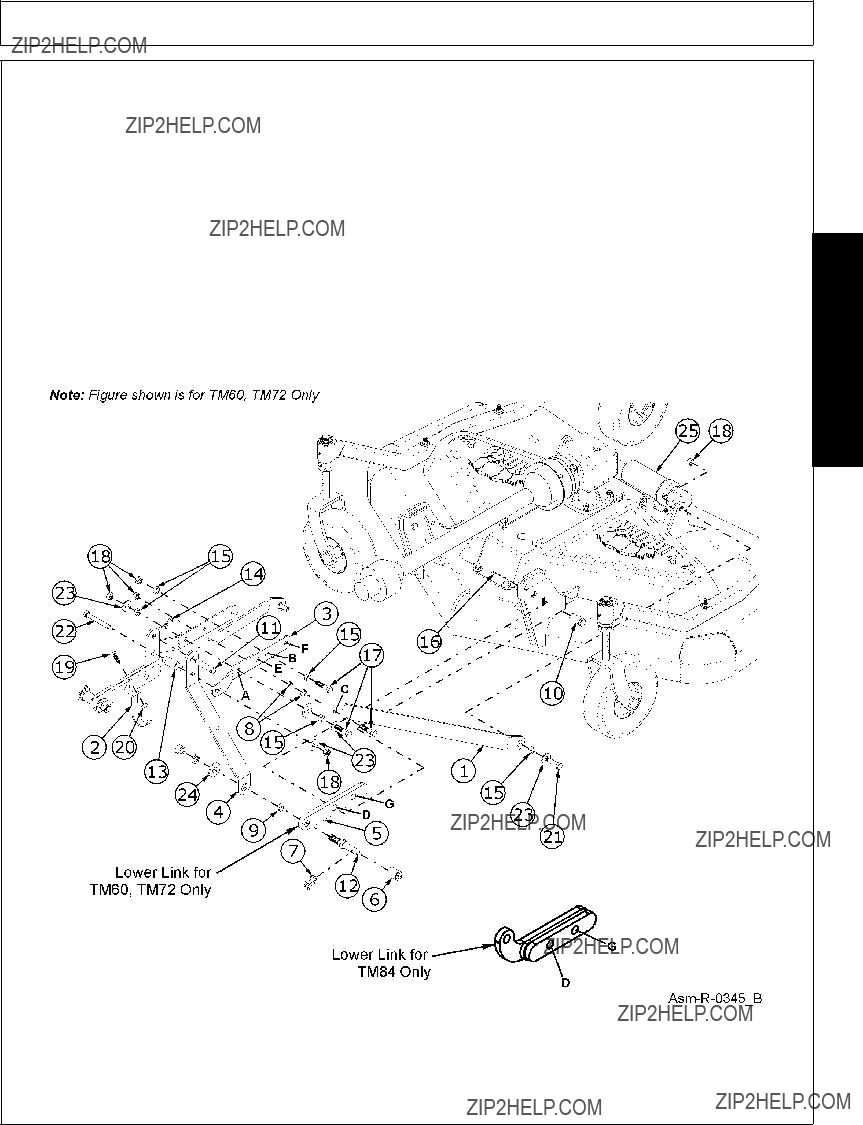
ASSEMBLY
A-FRAME ATTACHMENT FOR TM60-72-84
Attach the rear brace bars (1) to the rear of the deck with 5/8 x 2 bolts(21), flatwasher(23), bushing(15) and 5/8 locknut (18). Insert bar (5) between double lugs on deck and pin in place using pin (10) and cotter pin (16), in hole ???D???. Attach A-frame bars (4) to end holes in bar (5) using hitch pin (12), flatwasher (24), bushing (9), lockwasher, and 7/8??? nut. Insert bushing (13) between upper end of A-frame bars (4). Install flatwasher (23) onto 5/8 x 5 bolt (22) and insert through link bar (3) through bushing (13) and link bar (3) on side and install 5/8 locknut (18). Insert 5/8 x 2 1/2 (17) bolt through hole ???C??? in rear brace bar (1) insert two bushings (18) then through opposite rear brace bar (1) and 5/8 locknut (18). Insert washer (23) then bushing (15) on 5/8 x 2 1/2 bolt (17). Insert bolt through top hole on rear brace bar (1) and through hole ???A??? on link bar (3) then through opposite rear brace bar (1), bushing (15), flatwasher (23) and 5/8 locknut (18). Inset 5/8 x 2-1/2 bolt (17) through bushing (15), link bar (3) hole ???B??? another bushing (15) then 5/8 lock nut (18). Insert pin (11) through top holes in A-frame bar (4) and lock with lynch pin (14). Insert bushing (6) into hitch pin (12). Lock into place using pin (7). If A-frame needs to be moved out, move holes A to E, B to F, and D to G. See Figure Asm-R- 0354_B.
?? 2011 Alamo Group Inc.

ASSEMBLY
A-FRAME ATTACHMENT FOR TM100
Attach the rear brace bars (1) to the rear of the deck with 5/8 x 2 bolts (2), flatwasher (3), bushing (4) and 5/8 locknut (5). Insert weldment (6) between double lugs on deck and pin in place using pin (7) and cotter pin (8) in hole ???D??? of weldment. Attach A-frame bars (9) to inside holes in weldment (6) using 7/8 x 2-1/2 bolt (10), flatwasher cotter pin (8). Attach A-frame bars (9) to inside holes in weldment (6) using 7/8 x 2-1/2 bolt (10), flatwasher (11), bushing (12), and 7/8??? nut (13). Insert top link bushing (14) between upper end of A-frame bars
(9). Install flatwasher (3) onto 5/8 x 5 bolt (15), and insert through link bar (16) through top link bushing (14) and link bar (16) on side, and install 5/8 locknut (5). Insert 5/8 x 2-1/2 bolt (17) through hole ???C??? in rear brace bar (1), then insert two bushings (18) through opposite rear brace bar (1) and 5/8 locknut (5). Insert washer (3) then bushing (4) on 5/8 x 2-1/2 bolt (17). Insert bolt through top hole on rear brace bar (1) and through hole ???A??? on link bar (16), then through opposite rear brace bar (1), bushing (4), flatwasher (3), and 5/8 locknut (5). Insert 5/8 x 2-1/2 bolt (17) through bushing (4), link bar (16) hole ???B??? another bushing (4) then 5/8 lock nut (5). Insert pin (19) through top holes in A-frame bar (9), and lock with lynch pin (20). Insert pin (21) into weldment (6). Lock into place using pin (22). If A-frame needs to be extended out for clearance purposes, move holes A to E, B to F, and D to G. See Figure Asm-R-0447.
?? 2011 Alamo Group Inc.
ASSEMBLY
CASTER WHEEL ATTACHMENTS
Attach the right and left Axle Arm Weldment (14) to the deck with 1/2??? bolts (11), flatwasher (8), 1/2??? locknuts (10). Install to rear end of slots in deck. Install axle depth bushing (1) on each fork assembly. Insert fork shaft into axle arm weldment. Install large retaining ring (7) onto bushing (1) and small retaining ring (6) onto fork shaft (12).
.
ASSEMBLY
?? 2011 Alamo Group Inc.
ASSEMBLY
DRIVELINE ATTACHMENT - TO GEARBOX
1.Insert yoke onto splined shaft. Pull slide collar so yoke and slide onto gearbox shaft.
2.Move yoke back and forth until collar clicks and locks the yoke in place.
ASSEMBLY
Note: Shield has been removed for clarity.
?? 2011 Alamo Group Inc.
OPERATION SECTION
Operation Section 4-1
?? 2011 Alamo Group Inc.
Operation Section 4-2
(SG-3)
(SG-2)
OPERATION
RHINO TM60/TM72/TM84 and TM100
FINISHING MOWER OPERATION INSTRUCTIONS
Rhino TM60/72/84/and TM100 finishing mowers are manufactured with quality material by skilled workers. These mowers are designed to cut grass, weeds, small brush and other vegetative material up to 1??? diameter in areas such as pastures, industrial areas, and roadsides. All shields, guards, deflectors, and chains equipped on the unit must be maintained on the mower in good operational condition.
It is the operator???s responsibility to be knowledgeable of all potential operating hazards and to take every reasonable precaution to ensure oneself, others, animals, and property are not injured or damaged by the mower, tractor, or a thrown object. Do not operate the mower if passersby, pets, livestock, or property are directly in front or to the rear of the unit.
This section of the Operator???s Manual is designed to familiarize, instruct, and educate safe and proper mower use to the operator. Pictures contained in this section are intended to be used as a visual aid to assist in explaining the operation of a rotary mower and are not specific to a TM mower. Some pictures may show shields removed for purposes of clarity. NEVER OPERATE this implement without all shields in place and in good operational condition. The operator must be familiar with the mower and tractor operation and all associated safety practices before operating the mower and tractor. Proper operation of the mower, as detailed in this manual, will help ensure years of safe and satisfactory use of the mower.
READ AND UNDERSTAND THE ENTIRE OPERATING INSTRUCTIONS AND SAFETY SECTION OF THIS
MANUAL AND THE TRACTOR MANUAL BEFORE ATTEMPTING TO USE THE TRACTOR AND IMPLEMENT. If you do not understand any of the instructions, contact your nearest authorized dealer for a full explanation. Pay close attention to all safety signs and safety messages contained in this manual and those affixed to the implement and tractor. OPS-U- 0001
READ, UNDERSTAND, and FOLLOW the following Safety Messages. Serious injury or death may occur unless care is taken to follow the warnings and instructions stated in the Safety Messages. Always use good common sense to avoid hazards.
Si no lee ingles, pida ayuda a alguien que si lo lea para que le traduzca las medidas de seguridad.
TM60/72/84/100 02/11
?? 2011 Alamo Group Inc.
OPERATION
1. Standard Equipment and Specifications
*Safety Deflectors are standard equipment. Single and double chain guards are available as extra equipment at extra cost. Servis-Rhino recommends mowers be equipped with deflectors or double chain guards for all mowing purposes. Single chain guards may be used for agriculture purposes only and are specifically not recommended for highway, right-of-way, parks or greenbelt mowing.
**Ratings based on actual field performance.
?? 2011 Alamo Group Inc.

OPERATION
2. OPERATOR REQUIREMENTS
Safe operation of the unit is the responsibility of a qualified operator. A qualified operator has read and understands the implement and tractor Operator???s Manuals and is experienced in implement and tractor operation and all associated safety practices. In addition to the safety messages contained in this manual, safety signs are affixed to the implement and tractor. If any part of the operation and safe use of this equipment is not completely understood, consult an authorized dealer for a complete explanation.
If the operator cannot read the manuals for themselves or does not completely understand the operation of the equipment, it is the responsibility of the supervisor to read and explain the manuals, safety practices, and operating instructions to the operator.
Safe operation of equipment requires that the operator wear approved Personal Protective Equipment (PPE) for the job conditions when attaching, operating, servicing, and repairing the equipment. PPE is designed to provide operator protection and includes the following safety wear:
PERSONAL PROTECTIVE EQUIPMENT (PPE)
???Always Wear Safety Glasses
???Hard Hat
???Steel Toe Safety Footwear
???Gloves
???Hearing Protection
???Close Fitting Clothing
???Respirator or Filter Mask (depends on operating conditions) OPS-U- 0002
DO NOT use drugs or alcohol immediately before or while operating the
Tractor and Implement. Drugs and alcohol will affect an operator???s alertness and coordination and therefore affect the operator???s ability to operate the equipment safely. Before operating the Tractor or Implement, an operator on prescription or over-the-counter medication must consult a medical professional regarding any side effects of the medication that would hinder their ability to operate the Equipment safely. NEVER knowingly allow anyone to operate this equipment when their alertness or coordination is impaired. Serious injury or death to the operator or others could result if the operator is under the influence of drugs or alcohol. (SG-27)
?? 2011 Alamo Group Inc.
(SG-7)
OPERATION
3. TRACTOR REQUIREMENTS
The tractor used to operate the mower must have the power capacity to lift, pull, and operate the Power Take Off (PTO) at the mower???s rated speed while traveling at a ground speed between 2 and 5 MPH. Operating the mower with a tractor that does not meet the following requirements may cause tractor or mower damage and be a potential danger to the operator and passersby.
Tractor Requirements and Capabilities
???ASABE approved Roll-Over Protective Structure (ROPS) or ROPS cab and seat belt.
3.1 ROPS and Seat Belt
The tractor must be equipped with a Roll-Over-Protective-Structure (ROPS) (tractor cab or roll-bar) and seat belt to protect the operator from falling off the tractor, especially during a roll over where the driver could be crushed and killed. Only operate the tractor with the ROPS in the raised position and seat belt fastened. Tractor models not equipped with a ROPS and seat belt should have these life saving features installed by an authorized dealer. OPS-U- 0003
Operate this Equipment only with a Tractor equipped with an approved roll- over-protective system (ROPS). Always wear seat belts. Serious injury or even death could result from falling off the tractor--particularly during a turnover when the operator could be pinned under the ROPS.
3.2 Tractor Safety Devices
If transporting or operating the tractor and implement near a public roadway, the tractor must be equipped with proper warning lighting and a Slow Moving Vehicle (SMV) emblem which are clearly visible from the rear of the unit. Lights and a SMV emblem must be equipped directly on implements if the visibility of the tractor warning signals are obscured.
Maintain all manufacturer equipped safety shields and guards. Always replace shields and guards that were removed for access to connect, service, or repair the tractor or implement. Never operate the tractor PTO with the PTO master shield missing or in the raised position. OPS-U- 0004
?? 2011 Alamo Group Inc.

OPERATION
3.3 Tractor Horsepower
The horsepower required to operate the mower depends on many factors including the vegetation to be cut, terrain condition, operator experience, and condition of the mower and tractor. For most mowing condition, the TM60 mower requires a tractor with at least 17HP, and TM72 23HP. Operating the mower with a tractor that does not have adequate power may damage the tractor engine.
3.4 Tractor 3-Point Hitch
The tractor 3-point hitch must be rated to lift at least 456lbs if attaching a TM60 and 568 lbs if attaching a TM72.
The mower is designed to be mounted on tractors with a CAT I hitch. Refer to the tractor operator???s manual for the category of the tractor being used. If the hitch does not conform to ASABE CAT I dimensions, the mower may not fit or raise properly. Consult an authorized dealer for possible modification procedures to mount non-conforming hitches.
Use the correct hitch pins for the hitch category being used. For a Cat I hitch, 7/8??? lower and 3/4??? upper diameter hitch pins.
3.5 Front End Weight
A minimum of 20% total tractor weight must be maintained on the tractor front end at all times. Front end weight is critical to maintain steering control and to prevent the tractor from rearing up while driving. If the front end is too light, add weight until a minimum of 20% total weight is reached on the front tires. Front weights and weight carriers can be purchased through an authorized tractor dealership. OPS-U- 0005
?? 2011 Alamo Group Inc.
(SG-12)
OPERATION
3.6 Power Take Off (PTO)
Depending on the unit, the mower is designed to operate at a PTO speed of 540 or 1000 RPM. Most tractors operate at either 540, or a combination of 540 and 1000 RPM PTO speeds. The operating speed of the mower and tractor can be determined by the number of splines on the driveline yoke and PTO output shaft. Those operating at 540 RPM will have a 6-spline shaft and those operating at 1000 RPM will have a 20 or 21- spline shaft. Note: Refer to the tractor owner???s manual for instructions to change PTO speeds on models that operate at more than one speed.
If operating an older model tractor where the tractor???s transmission and PTO utilize one master clutch, an over-running clutch must be used between the PTO output shaft and the driveline of the mower. An authorized tractor dealer can provide the over-running clutch and its installation if needed. OPS-U- 0006_A
DO NOT use a PTO adapter to attach a non-matching Implement driveline to a Tractor
PTO. Use of an adapter can double the operating speed of the Implement resulting in excessive vibration, thrown objects, and blade and implement failure. Adapter use will also change the working length of the driveline exposing unshielded driveline areas. Serious bodily injury and/or equipment failure can result from using a PTO adapter. Consult an authorized dealer for assistance if the Implement driveline does not match the Tractor PTO.
(S3PT-14)
Never operate the Tractor and Mower if the Implement input driveline is directly connected to the Tractor transmission. Tractor braking distances can be substantially increased by the momentum of the rotating Mower blades driving the Tractor transmission even though the Tractor clutch has been disengaged. Install an over running clutch between the Tractor PTO and the Mower driveline to prevent this potentially dangerous situation. (S3PT-16)
4. GETTING ON AND OFF THE TRACTOR
Before getting onto the tractor, the operator must read and completely understand the implement and tractor operator manuals. If any part of either manual is not completely understood, consult an authorized dealer for a complete explanation. OPS-U- 0007
Do not mount or dismount the Tractor while the tractor is moving. Mount the Tractor only when the Tractor and all moving parts are completelystopped.
?? 2011 Alamo Group Inc.
(SG-10)
(SG-11)
OPERATION
4.1 Boarding the Tractor
Use both hands and equipped handrails and steps for support when boarding the tractor. Never use control levers for support when mounting the tractor. Seat yourself in the operator???s seat and secure the seat belt around you.
Never allow passengers to ride on the tractor or attached equipment. Riders can easily fall off and be seriously injured or killed from falling off and being ran over. It is the operator???s responsibility to forbid all extra riders at all times. OPS-U- 0008
OPERATION

Never allow children to operate, ride on, or come close to the Tractor or
Implement. Usually, 16-17 year-old children who are mature and responsible can operate the implement with adult supervision, if they have read and understand the Operator???s Manuals, been trained in proper operation of the tractor and Implement, and are physically large enough to reach and operate the controls easily.
Never allow children or other persons to ride on the Tractor or Implement.
Falling off can result in serious injury or death.
4.2 Dismounting the Tractor
Before dismounting, park the tractor and implement on a reasonably level surface, apply the parking brake, idle the engine down, disengage the PTO, and lower the implement to the ground. Shut down the tractor engine according to the operator???s manual, remove the key, and wait for all motion to completely stop. Never leave the seat until the tractor, its engine and all moving parts have come to a complete stop.
Use hand rails and steps when exiting the tractor. Be careful of your step and use extra caution when mud, ice, snow or other matter has accumulated on the steps or hand rails. Use all handrails and steps for support and never rush or jump off the tractor. OPS-U- 0009
BEFORE leaving the tractor seat lower the implement, set the parking brake and/or set the tractor transmission in parking gear, disengage the PTO, stop the engine, remove the key, and wait for all moving parts to stop. Place the tractor shift lever into a low range or parking gear to prevent the tractor from rolling. Never dismount a Tractor that is moving or while the engine is running. Operate the Tractor controls from the tractor seat only. (SG-9)
?? 2011 Alamo Group Inc.
(SG-13)
(SG-23)
OPERATION
5. STARTING THE TRACTOR
The operator must have a complete understanding of the placement, function, and operational use of all tractor controls before starting the tractor. Review the tractor operator???s manual and consult an authorized dealer for tractor operation instructions if needed.
Essential Tractor Controls:
???Locate the light control switch.
???Locate the engine shut off control.
???Locate the brake pedals and the clutch.
???Locate the PTO control.
???Locate the 3-point hitch control lever.
???Locate the hydraulic remote control levers.
Before starting the tractor ensure the following:
???Conduct all pre-start operation inspection and service according to the tractor operator???s manual.
???Make sure all guards, shields, and other safety devices are securely in place.
???The parking brake is on.
???The PTO control lever is disengaged.
???The 3-point hitch control lever is in the lowered position.
???The hydraulic remote control levers are in the neutral position.
???The tractor transmission levers are in park or neutral.
Refer to the tractor owner???s manual for tractor starting procedures. Only start the tractor while seated and belted in the tractor operator???s seat. Never bypass the ignition switch by short circuiting the starter solenoid.
After the tractor engine is running, avoid accidental contact with the tractor transmission to prevent sudden and unexpected tractor movement. OPS-U-0028
Never run the Tractor engine in a closed building or without adequate ventilation. The exhaust fumes can be hazardous to your health.
Start tractor only when properly seated in the Tractor seat. Starting a tractor in gear can result in injury or death. Read the Tractor operators manual for proper starting instructions.
6. CONNECTING THE MOWER TO THE TRACTOR
Use extreme caution when connecting the mower to the tractor. The mower should be securely resting at ground level or setting on blocks. Keep hands and feet from under the mower deck and clear of pinch points between the tractor hitch arms and mower pins. OPS-R-0001
?? 2011 Alamo Group Inc.

OPERATION
Always shut the Tractor completely down, place the transmission in park, and set the parking brake before you or anyone else attempts to connect or disconnect the Implement and Tractor hitches. (S3PT-15)
6.1 Connecting the Mower
1.Make sure the tractor is equipped with the correct PTO shaft. Change shafts if needed.
2.Shorten or remove the tractor drawbar to avoid interference when raising and lowering the mower.
3.Board the tractor and start the engine. Position the tractor to the mower with the 3-point lift arms positioned at the same height and to the outside of the mower hitch pins. Note: Set the 3-point lift control to ???Position Control??? so that the lift arms maintain a constant height when attaching the mower. See the tractor Operator???s Manual for correct settings when attaching 3-point equipment.
4.Turn off the tractor engine, set the parking brake, place the tractor in park, and dismount.
5.One lift arm at a time, position the tractor lift
arms over the A-frame hitch pins. Insert lynch pins to retain lift arms to the mower. Walk around to opposite side and repeat procedure for remaining lift arm and hitch pin.
Note: Lower hitch link bar has two adjustment positions. Bar can be extended 4??? for additional tire clearance.
6.Extend or retract the 3-point top link to align its end hole with the holes of the mower???s top link. Insert the top link hitch pin and insert retaining pin into hitch pin.
7.Adjust any lower link check chains, guide blocks, or sway blocks to prevent the mower from swaying side to side and possible contact with tractor rear tires.
7.SETTING THE MOWER
Properly setting the cutting height is essential for efficient and safe operation. A properly set mower will make a more uniform cut, distribute clippings more evenly, require minimal tractor work, and follow the contour of uneven terrain. NOTE: Avoid very low cutting heights, striking the ground with the blades gives the most damaging shock loads and will cause damage to the mower and drive. Blades contacting the ground may cause objects to be thrown out from under the mower deck. Always avoid operating the mower at a height which causes the blades to contact the ground. OPS-U- 0010
?? 2011 Alamo Group Inc.
(SG-14)
OPERATION
Never work under the Implement, the framework, or any lifted component unless the Implement is securely supported or blocked up to prevent sudden or inadvertent falling which could cause serious injury or even death.
8. CUTTING HEIGHT ADJUSTMENT
Avoid personal injury! Be sure tractor engine is off, key is removed, and ALLOW BLADES TO STOP TURNING before dismounting to make adjustments.
1.Using the tractor, raise the mower off the ground and support under it with secure blocking so not to let the mower drift down during maintenance.
2.Holding wheel and fork assembly, remove quick-lock pin. Position for at approximate height and install lock pin in appropriate holes per table below. Placing pin in hole ???D??? in bushing a hole ???1??? in for shaft gives 1-1/ 2??? approximate cutting height.
?? 2011 Alamo Group Inc.

OPERATION
9. DRIVELINE ATTACHMENT
The driveline yoke and tractor PTO shaft must be dirt free and greased for attachment.
To connect the mower driveline to the tractor PTO output shaft, pull the driveline yoke collar back and align the grooves and splines of the yoke with those of the PTO shaft. Push the driveline yoke onto the PTO shaft, release the locking collar, and position the yoke until the locking collar balls are seated onto the PTO shaft. Push and pull the driveline back and forth several times to ensure a secure attachment. OPS-R-0003_A
When attaching the Implement input driveline to the Tractor PTO, it is important that the connecting yoke spring activated locking collar slides freely and the locking balls are seated securely in the groove on the Tractor PTO shaft. Push and pull the driveline back and forth several times to ensure it is securely attached. A driveline not attached correctly to the Tractor PTO shaft could come loose and result in personal injury and damage to the Implement. (S3PT-17)
9.1 Driveline Length Modification
Before operating the Implement, check to make sure the Implement input driveline will not bottom out or become disengaged. Bottoming out occurs when the inner shaft penetrates the outer housing until the assembly becomes solid-it can shorten no more. Bottoming out can cause serious damage to the Tractor PTO by pushing the PTO into the Tractor and through the support bearings or downward onto the PTO shaft, breaking it off. A broken driveline can cause personal injury. (S3PT-18)
When fitting the mower to the tractor, the telescoping driveline must be inspected to ensure that at its most compressed position, the profiles do not ???bottom out???, and when at its farthest extended position, there is sufficient engagement between the profiles to operate safely. At its shortest length, there must be at least a 1??? clearance between each profile end and opposite profile universal joint. At its farthest operating extension, a minimum profile engagement of 8-1/2??? must be maintained.
?? 2011 Alamo Group Inc.
OPERATION
???Recheck for proper operation.
Engagement Check Procedure
???With the driveline attached, position the mower to the point where the telescoping driveline is at its maximum extension. Completely shut down the tractor and secure in position.
???Mark the inner driveline shield 1/8??? from the end of the outer shield.
???Disconnect the driveline from the tractor and separate the two driveline halves.
???Measure the distance from the mark to the end of the inner profile. This length is the amount the driveline profiles were engaged.
???If the engaged length is less than 8-1/2??? for driveline, the shaft is considered too short and should be replaced with a longer shaft. Consult an authorized dealer to purchase the required driveline length.
NOTE: When raising the mower, at least 1??? clearance must be maintained between the driveline and the mower deck. If necessary, place an upper lift stop on the 3-point hitch control lever to limit the height the mower can be raised. OPS-R-0005-L
?? 2011 Alamo Group Inc.
(SG-21)
(SG-14)
(S3PT-11)
OPERATION
10. PRE-OPERATION INSPECTION AND SERVICE
Before each use, a pre-operation inspection and service of the implement and tractor must be performed. This includes routine maintenance and scheduled lubrication, inspecting that all safety devices are equipped and functional, and performing needed repairs. DO NOT operate the unit if the pre-operation inspection reveals any condition affecting safe operation. Perform repairs and replacement of damaged and missing parts as soon as noticed. By performing a thorough pre-operation inspection and service, valuable down time and repair cost can be avoided. OPS-U-0029
Always disconnect the main PTO Driveline from the Tractor before performing service on the Implement. Never work on the Implement with the tractor PTO driveline connected and running. Rotating Parts, Blades or Drivelines could turn without warning and cause immediate entanglement, injury or death.
Never work under the Implement, the framework, or any lifted component unless the Implement is securely supported or blocked up to prevent sudden or inadvertent falling which could cause serious injury or even death.
Periodically inspect all moving parts for wear and replace when necessary with authorized service parts. Look for loose fasteners, worn or broken parts, and leaky or loose fittings. Make sure all pins have cotter pins and washers. Serious injury may occur from not maintaining this machine in good working order.
?? 2011 Alamo Group Inc.

OPERATION
10.1 Tractor Pre-Operation Inspection/Service
Refer to the tractor operator???s manual to ensure a complete pre-operation inspection and scheduled service is performed according to the manufacturers recommendations. The following are some of the items that require daily service and inspection:
???Tire condition/air pressure
???Wheel lug bolts
???Steering linkage
???PTO shield
???SMV sign is clean and visible
???Tractor???s lights are clean and functional
???Tractor Seat belt is in good condition
???Tractor ROPS is in good condition
???ROPS is in the raised position
???No tractor oil leaks
???Radiator free of debris
???Engine oil level and condition
???Engine coolant level and condition
???Power brake fluid level
???Power steering fluid level
???Fuel condition and level
???Sufficient lubrication at all lube points
???Air filter condition OPS-U-0030
10.2Mower Pre-Operation Inspection/Service
Before each mower use, a complete inspection and service is required to ensure the mower is in a good and safe working condition. Damaged and/or broken parts should be repaired and/or replaced immediately. To ensure the mower is ready for operation, conduct the following. OPS-R-0007
All Safety Shields, Guards and Safety devices including (but not limited to) - the Deflectors, Chain Guards, Steel Guards, Gearbox Shields, PTO integral shields, and Retractable Door Shields should be used and maintained in good working condition. All safety devices should be inspected carefully at least daily for missing or broken components. Missing, broken, or worn items must be replaced at once to reduce the possibility of injury or death from thrown objects, entanglement, or blade contact. (SGM-3)
Replace bent or broken blades with new blades. NEVER ATTEMPT TO STRAIGHTEN,
WELD, OR WELD HARDFACING ON BLADES SINCE THIS WILL LIKELY CRACK OR
OTHERWISE DAMAGE THE BLADE WITH SUBSEQUENT FAILURE AND POSSIBLY
CAUSE SERIOUS INJURY FROM THROWN BLADES. (SGM-10)
?? 2011 Alamo Group Inc.
OPERATION
The operator???s manual and safety signs affixed on the unit contain important instructions on the safe and proper use of the equipment. Maintain these important safety features on the implement in good condition to ensure the information is available to the operator at all times.
???Ensure the manual canister is secured to the equipment with the operator???s manual inside.
???Ensure all safety signs are in place and legible. Replace missing, damaged, and illegible decals. OPS-U- 0011
???Ensure the axle arm weldment bolts are properly installed and tightened.
???Ensure the snapper pin is installed correctly on the fork and wheel assembly.
???Inspect all bolts and screws and tighten to the recommended torque. OPS-R-0063_A
???Inspect the condition of the drive belts.
???Ensure the driveline shield and drive belt shields are in place and in good repair.
???Ensure the tractor PTO master shield is in place, lowered and in good condition. OPS-R- 0064_C
?? 2011 Alamo Group Inc.
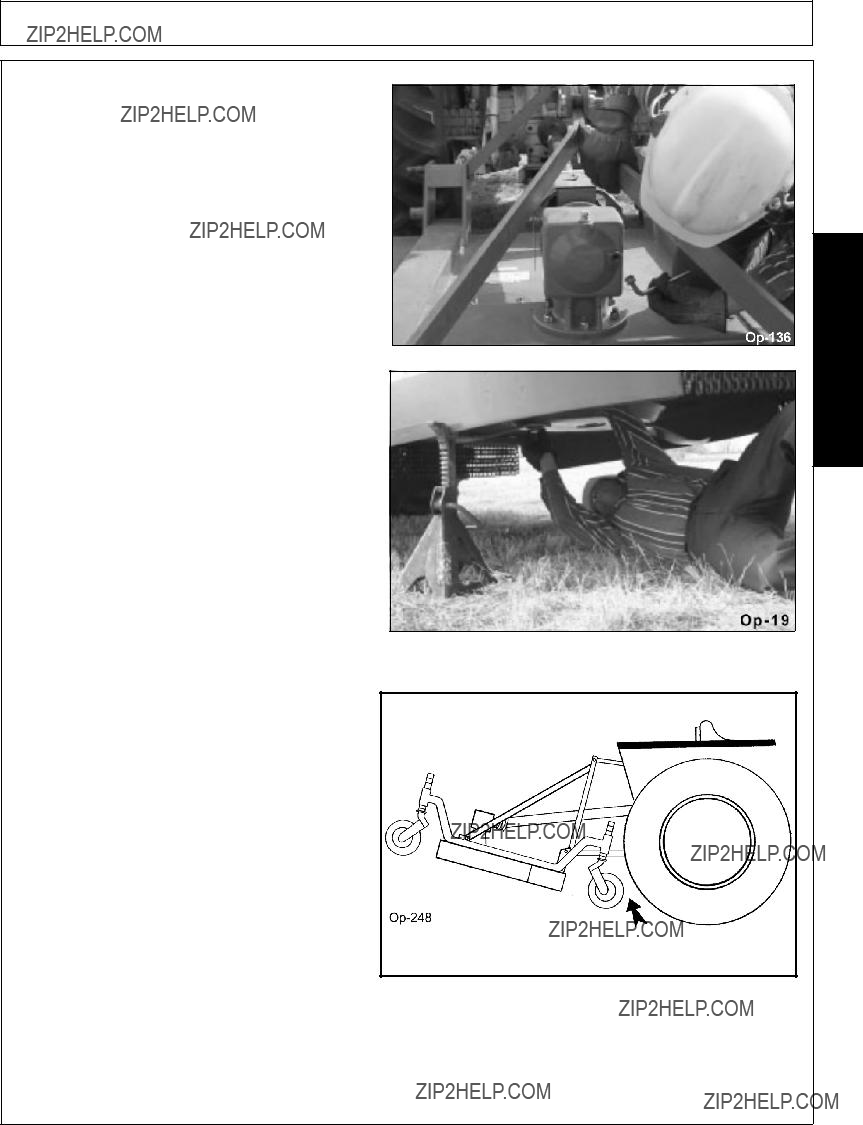
OPERATION
???Inspect the gearbox oil level. A low oil level is a warning sign that the gearbox may be cracked or its seal is damaged and needs replacement.
???Ensure the gearbox vent is in place and free from clogs. OPS-R-0040
???Inspect blades and blade bolts for looseness and excessive wear. Make sure the mower is securely blocked up before crawling beneath. Replace damaged, worn, and missing blades as complete sets to maintain rotary balance.
OPS-R-0012_B
10.3 Front Gauge Wheel Interference Check
Do not operate mower until this interference check has been performed. If you change tractors, you must perform the check for that mounting.
Raise mower with tractor hydraulics to maximum height of tractor lift.
Pivot both front gauge wheels forward and check that there is clearance between gauge wheels and tractor tires.
If there is interference, you must move hitch pin to extended position (See assembly section). Move tractor tires inward to obtain clearance or lower mower until clearance exists. Set 3-Point quadrant stop so mower cannot be raised beyond set point.
?? 2011 Alamo Group Inc.
OPERATION
10.4 Cutting Component Inspection
Inspect blade pan and blade assembly for the following:
OPERATION
OPS-U-0031
Inspect the Blades daily for abnormal wear. REPLACE BLADES IMMEDIATELY if any blade has:
???Become bent or deformed from it???s original shape or
???Any cracks are visible, or
???Deep gouges in the blade???s surface are present, or
???Gouges or chipped areas in the cutting edge are larger than 1/2???, or
???The material on the leading edge has been worn away by more than 1/2???
Failure to replace abnormally worn blades may lead to catastrophic failure of the blades and ejection of the broken part with tremendous force which may cause serious bodily injury or death. OPS-U-0032_A
?? 2011 Alamo Group Inc.
OPERATION
10.5 Blade Bolt Inspection
Inspect Blade Bolt Head daily for wear as followed:
OPERATION
Inspect the Blade Bolt Heads daily for abnormal wear. REPLACE BOTH BLADE BOLTS on the Blades IMMEDIATELY if either blade bolts has:
???Visible cracks or
???If the recessed area on blade bolt is worn off or
???If Blade Bolt has gouges or chipped areas.
Failure to replace abnormally worn blade bolts may lead to catastrophic failure of the blades and ejection of the broken part which may cause serious bodily injury or death.
Always replace Blade Bolts with new bolts whenever replacing the Blades. OPS-U-0037
?? 2011 Alamo Group Inc.
OPERATION
Tractor PRE-OPERATION Inspection
Before conducting the inspection, make sure the tractor engine is off, all rotation has stopped and the tractor is in park with the parking brake engaged. Make sure the mower is resting on the ground or securely blocked up and all hydraulic pressure has been relieved.
DO NOT OPERATE an UNSAFE TRACTOR or MOWER
?? 2011 Alamo Group Inc.

OPERATION
Finish Mower PRE-OPERATION Inspection
Mower ID#________________________Make____________________
Date:_____________________________Shift____________________
Before conducting the inspection, make sure the tractor engine is off, all rotation has stopped and the tractor is in park with the parking brake engaged. Make sure the mower is resting on the ground or securely blocked up and all hydraulic pressure has been relieved.
The Operator???s Manual is in the canister on the mower
All safety decals are in place and legible
The tongue/hitch connection bolts & pins are tight
There are no cracks on hitch
The tow chain is secured to the tractor & mower
The hydraulic cylinders pins are tight
There are no leaking or damaged hoses
The mower deck is clear of cut grass and debris
Chain guards/deflectors are in place & in good condition
Driveline/gearbox shields are in good condition
Driveline clutches are in good condition; not frozen
Driveline telescoping members & U-joints are lubricated
Driveline yokes are securely attached to PTO & mower
Gearbox mounting bolts are tight
Gearbox oil is at the proper level
Blade carrier retaining nut is tight
Blades are not chipped, cracked or bent
Blade bolts are tight
Wheel lug nuts are tight
Transport locks are in good condition
Operator???s Signature:
DO NOT OPERATE an UNSAFE TRACTOR or MOWER
?? 2011 Alamo Group Inc.
(SG-19)
OPERATION
11. DRIVING THE TRACTOR AND IMPLEMENT
Safe tractor transport requires the operator possess a thorough knowledge of the model being operated and precautions to take while driving with an attached implement. Ensure the tractor has the capacity to handle the weight of the implement and the tractor operating controls are set for safe transport. To ensure safety while driving the tractor with an attached implement, review the following. OPS-U- 0012
This Implement may be wider than the Tractor. Be careful when operating or transporting this equipment to prevent the Implement from running into or striking sign posts, guard rails, concrete abutments or other solid objects. Such an impact could cause the Implement and Tractor to pivot violently resulting in loss of steering control, serious injury, or even death. Never allow the Implement to contact obstacles. (S3PT-12)
Transport only at speeds where you can maintain control of the equipment. Serious accidents and injuries can result from operating this equipment at high speeds. Understand the Tractor and Implement and
how it handles before transporting on streets and highways. Make sure the Tractor steering and brakes are in good condition and operate properly.
Before transporting the Tractor and Implement, determine the proper transport speeds for you and the equipment. Make sure you abide by the following rules:
Test the tractor at a slow speed and increase the speed slowly. Apply the Brakes smoothly to determine the stopping characteristics of the Tractor and Implement. As you increase the speed of the Tractor the stopping distance increases. Determine the maximum transport speed not to exceed 20 mph (30 kph) for transporting this equipment.
Test the equipment at a slow speed in turns. Increase the speed through the turn only after you determine that the equipment can be operated at a higher speed. Use extreme care and reduce your speed when turning sharply to prevent the tractor and implement from turning over. Determine the maximum turning speed for you and this equipment before operating on roads or uneven ground.
Only transport the Tractor and Implement at the speeds which allow you to properly control the equipment.
Be aware of the operating conditions. Do not operate the Tractor with weak or faulty brakes or worn tires. When operating down a hill or on wet or rain slick roads, the braking distance increases: use extreme care and reduce your speed. When operating in traffic always use the Tractor???s flashing warning lights and reduce your speed. Be aware of traffic around you and watch out for the other guy.
?? 2011 Alamo Group Inc.

11.1 Starting the Tractor
The procedure to start the tractor is model specific. Refer to the tractor operator???s manual for starting procedures for your particular tractor. Consult an authorized dealer if the starting procedure is unclear. Ensure the 3-point control lever is in the lowered position and the PTO is disengaged before starting the tractor. OPS-U-0033
11.2 Brake and Differential Lock Setting
Make sure the tractor brakes are in good operating condition. Tractor brakes can be set to operate independently allowing single rear wheel braking action or locked together to provide simultaneous rear wheel braking. FOR MOST DRIVING AND
OPERATING CONDITIONS, THE BRAKE PEDALS
SHOULD BE LOCKED TOGETHER TO PROVIDE
THE MOST EFFECTIVE BRAKING ACTION.
Always disengage the tractor differential lock when turning. When engaged the differential lock will prevent or limit the tractor from turning. During normal cutting conditions, locking the differential provides no benefit and should not be used. OPS- U- 0013
Be aware of the operating conditions. Do not operate the Tractor with weak or faulty brakes. When operating down a hill or on wet or rain slick roads, the braking distance increases; use extreme care and reduce your speed in these conditions. When operating in traffic, always use the Tractor???s flashing warning lights and reduce your speed. Be aware of traffic around you and watch out for the other guy.
?? 2011 Alamo Group Inc.
OPERATION


OPERATION
11.3 Raising the Mower
Using the tractor 3-point hitch control lever, raise the mower off the ground about 6???, or just high enough to clear any ground obstacles. When raising the mower, make sure all connection points are securely attached and at least 1??? clearance is maintained between the driveline and the deck. If necessary, place an upper lift stop on the 3-point hitch control lever to limit the height the mower can
be raised to avoid driveline damage. OPS-R-
0042_B
11.4 Operating the Tractor and Mower
Start off operating at a slow speed and gradually increase your speed while maintaining complete control of the tractor and mower. Moving slowly at first will also prevent the tractor from rearing up and loss of steering control. The tractor should never be operated at speeds that cannot be safely handled or which will prevent the operator from stopping quickly during an emergency. If the power steering or engine ceases operating, stop the tractor immediately as the tractor will be difficult to control.
Perform turns with the tractor and mower at slow speeds to determine how the tractor with an attached mower handles a turn. Determine the safe speed to maintain proper control of the tractor when making turns. When turning with a towed implement, the overall working length of the unit is increased. Allow additional clearance for the mower when turning..
To avoid overturns, drive the tractor with care and at safe speeds, especially when operating over rough ground, crossing ditches or slopes, and turning corners. Tractor wheel tread spacing should be increased when working on inclines or rough ground to reduce the possibility of tipping.
Use extreme caution when operating on steep slopes. Keep the tractor in a low gear when going downhill. DO NOT coast or free-wheel downhill.
OPS-R-0018_D
?? 2011 Alamo Group Inc.

OPERATION
11.5 Crossing Ditches and Steep Inclines
When crossing ditches with steep banks or going up sharp inclines, it is possible that the main driveline inner profile will penetrate into the outer housing to its maximum depth until the assembly becomes solid (driveline is at its extreme shortest length). This type of abusive operation can cause serious damage to the tractor and mower drive by pushing the PTO into the tractor and through the support bearings or downward onto the PTO shaft, breaking it off.
Damage resulting from over-collapse of the driveline???s inner profile and its outer housing may allow the driveline to come loose from the Tractor which could cause bodily injury to the operator or bystanders and/or extensive damage to the Tractor or Implement. OPS-R-0020
When confronted with an incline or ditch, do not approach from an angle which is perpendicular or straight on as damaged to over collapse of the driveline may occur.
When crossing such terrain, the implement should be fully lowered for a lower center of gravity and added stability. OPS-R-0021
?? 2011 Alamo Group Inc.
(SGM-05)
OPERATION
Inclines and ditches should be approached along a line which is at an angle as shown. This type of path will reduce the possibility of over-collapse of the driveline and resulting damage. If the gradient is so steep that such an approach increases the possibility of a tractor roll-over, select an alternate crossing path.
When operating the tractor and mower across slopes and inclines, through ditches, and other uneven terrain conditions, it is important to maintain sufficient deck to ground clearance. Blade contact with the ground may cause soil, rocks and other debris to be thrown out from under the mower resulting in possible injury and/or property damage. Ground contact also produces a severe shock load on the mower drive and to the mower blades
resulting in possible damage and premature wear.
OPS-R-0022
12. OPERATING THE TRACTOR AND IMPLEMENT
THE OPERATOR MUST COMPLETELY UNDERSTAND HOW TO OPERATE THE TRACTOR AND IMPLEMENT AND ALL CONTROLS BEFORE ATTEMPTING TO OPERATE. The operator must read and understand the Safety and Operation Sections of the implement and tractor operator???s manuals. These manuals must be read and explained to any operator who cannot read. Never allow someone to operate the implement and tractor without complete operating instructions.
Before starting any operation, the operator must become familiar with the area to be worked in and any obstacles and hazards contained within to ensure safety to the operator, bystanders, and equipment. Special attention should be paid to foreign debris, rough terrain, steep slopes, and passersby and animals in the area.
OPS-U- 0015
Extreme care should be taken when operating near loose objects such as gravel, rocks, wire, and other debris. Inspect the area before mowing. Foreign objects should be removed from the site to prevent machine damage and/or bodily injury or even death. Any objects that cannot be removed must be clearly marked and carefully avoided by the operator. Stop mowing immediately if blades strike a foreign object. Repair all damage and make certain rotor or blade carrier is balanced before resuming mowing.
?? 2011 Alamo Group Inc.
OPERATION
Many varied objects, such as wire, cable, rope, or chains, can become entangled in the operating parts of the mower head. These items could then swing outside the housing at greater velocities than the blades. Such a situation is extremely hazardous and could result in serious injury or even death. Inspect the cutting area for such objects before mowing. Remove any like object from the site. Never allow the cutting blades to contact such items.
(SGM-06)
12.1 Foreign Debris Hazards
Before mowing, inspect the area to make sure there are no foreign objects that the mower blades could hit or become entangled with. Remove all foreign objects and debris. If objects are too big to remove, mark them clearly and be sure to prevent the mower blades from contacting them.
If you hit a solid object or foreign debris, stop the mower and tractor at once. Immediately idle the engine speed and disengage the PTO. Wait for all mower rotating motion to stop, then raise the mower and move the tractor and implement off the object. Inspect the area and remove, or mark the location of the debris. Inspect the condition of the mower and make any needed repairs immediately. Make sure the blades are not damaged and the carrier is balanced before resuming operation.
Always wear your seat belt securely fastened and only operate the tractor and mower with the ROPS in the raised position. If the tractor or mower hits a tree stump, rock, or bump, a sudden movement could throw you off of the seat and under the tractor and/or mower. The seat belt is your best protection from falling off the tractor and the ROPS provides protection from being crushed during a tractor roll-over. OPS-R-0023
Raise Mower over solid objects
12.2 Bystanders/Passersby Precautions
If a bystander comes within 300 feet of the tractor while the mower is being operated, stop the tractor at once, idle the engine and disengage the PTO. Do not engage the PTO again until all bystanders are well past the 300 foot distance. OPS-R-0024
?? 2011 Alamo Group Inc.
(SGM-09)
(SRM-01)
OPERATION
Rotary Mowers are capable under adverse conditions of throwing objects for great distances (300 feet or more) and causing serious injury or death. Follow safety messages carefully.
STOP MOWING IF PASSERSBY ARE WITHIN 300 Feet UNLESS:
-Front and Rear Deflectors, Chain Guards, or Bands are installed and in good, workable condition;
-Mower sections or Wings are running close to and parallel to the ground without exposed Blades;
-Passersby are outside the existing thrown-object zone;
-All areas have been thoroughly inspected and all foreign material such as rocks, cans, glass, and general debris has been removed.
NOTE: Where there are grass and weeds high enough to hide debris that could be struck
by the blades, the area should be: inspected and large debris removed, mowed at an intermediate height, inspected, closely with any remaining debris being removed, and mowed again at desired final height. (This will also reduce power required to mow, reduce wear and tear on the Mower drivetrain, spread cut material better, reduce streaking, and make the final cut more uniform).
12.3 Engaging the Power Take Off (PTO)
Before engaging the PTO, make certain that the area is clear of bystanders and passersby. The implement must be completely lowered and the deck positioned at a safe operating height. NEVER engage the PTO with the implement in the raised position.
Set the tractor engine speed at approximately 1,000 RPM before engaging the PTO. Shift the PTO control to the on position, and slowly increase the engine speed until the PTO is operating at the rated speed. If you hear unusual noises or see or feel abnormal vibrations, disengage the PTO immediately. Inspect the implement to determine the cause of the noise or vibration and repair the abnormality. OPS-U- 0027
Do not let the Blades turn when the Mower Deck is raised for any reason, including clearance or for turning. Raising the Mower deck exposes the Cutting Blades which creates a potentially serious hazard and could cause serious injury or even death from objects thrown from the Blades. (SRM-07)
Do not put hands or feet under mower decks. Blade Contact can result in serious injury or even death. Stay away until all motion has stopped and the decks are securely blocked up.
?? 2011 Alamo Group Inc.
(SG-26)
OPERATION
12.4 PTO RPM and Ground Speed
Ground speed for mowing will depend upon the height, type, and density of vegetation to be cut. Recommended speed for efficient mower performance is between 2 and 5 mph(3-8 kph). Operate the mower at its full rated PTO speed to maintain blade speed for a clean cut. Refer to the tractor operator???s manual or the tractor instrument panel for the engine speed and gear to provide the required PTO and desired ground speed. Make sure that the mower is operating at its full rated speed before entering the vegetation to be cut. If it becomes necessary to temporarily regulate engine speed, increase or decrease the throttle gradually.
Ground speed is achieved by transmission gear selection and not by the engine operating speed. The operator may be required to experiment with several gear range combinations to determine the best gear and range which provides the most ideal performance from the mower and most efficient tractor operation. As the severity of cutting conditions increase, the ground speed should be decreased by selecting a lower gear to maintain the proper operating PTO speed. OPS-R-0025
Do not exceed the rated PTO speed for the Implement. Excessive PTO speeds can cause
Implement driveline or blade failures resulting in serious injury or death.
Mow at the speed that you can safely operate and control the tractor and mower. The correct mowing speed depends on terrain condition and grass type, density, and height of cut. Normal ground speed range is from 2 to 5 mph(3-8 kph). Use slow mowing speeds when operating on or near steep slopes, ditches, drop-offs, overhead obstructions, power lines, or when debris and foreign objects are to be avoided. (SGM-07)
12.5 Operating the Mower
The mower is designed to cut grass and light weeds. Travel at a speed that allows the mower sufficient time to cut through the vegetation and maintain the PTO operating speed to prevent overloading the mower and tractor and to produce a clean cut. Choose a driving pattern that provides the maximum pass length and minimizes turning. Remember, sharp blades produce cleaner cuts and use less power.
Under certain conditions, tractor tires may roll some grasses down preventing them from being cut at the same height as the surrounding area. When this occurs, reduce the tractor ground speed while maintaining the operating speed of the mower. A slower ground speed will permit grasses to at least partially rebound and be cut. Taking a partial cut and/or reversing the direction of travel may also help produce a cleaner cut.
Avoid mowing in the reverse direction when possible. In situations where the mower must be backed to access areas to be cut, make sure there are no persons or other foreign debris behind the mower before mowing in reverse. When mowing in reverse, operate the tractor and mower at a reduced ground speed to ensure control is maintained of the tractor and mower. OPS-R-0026_I
?? 2011 Alamo Group Inc.
(SGM-11)
OPERATION
Do not mow with two machines in the same area except with Cab tractors with the windows closed.
Mow only in conditions where you have clear visibility in daylight or with adequate artificial lighting. Never mow in darkness or foggy conditions where you cannot clearly see at least 300 feet (90 m) in front and to the sides of the tractor and mower. Make sure that you can clearly see and identify passersby, steep slopes, ditches, drop-offs, overhead obstructions, power lines, debris and foreign objects. If you are unable to clearly see these type of items discontinue mowing. (SGM-1)
Avoid mowing in reverse direction when possible. Check to make sure there are no persons behind the mower and use extreme care when mowing in reverse. Mow only at a slow ground speed where you can safely operate and control the tractor and mower. Never mow an area that you have not inspected and removed debris or foreign material.
(SGM-08)
Follow these guidelines to reduce the risk of equipment and grass fires while operating, servicing, and repairing the Mower and Tractor:
-Equip the Tractor with a fire extinguisher in an accesible location. -Do Not operate the Mower on a Tractor with an underframe exhaust. -Do Not smoke or have an open flame near the Mower and Tractor. -Do Not drive into burning debris or freshly burnt areas.
-Ensure slip clutches are properly adjusted to prevent excessive slippage and plate heating.
-Never allow clippings or debris to collect near drivelines, slip clutches, and gearboxes. Periodically shut down the Tractor and Mower and clean clippings and collected debris from the mower deck. (SGM-12)
Do not let the Blades turn when the Mower Deck is raised for any reason, including clearance or for turning. Raising the Mower deck exposes the Cutting Blades which creates a potentially serious hazard and could cause serious injury or even death from objects thrown from the Blades. (SRM-07)
?? 2011 Alamo Group Inc.
OPERATION
Stay alert and watch for trees, low hanging limbs, power lines, and other overhead obstacles and solid ground objects while you are operating. Use care
to avoid hitting these items. OPS-R-0028_C
When mowing across uneven areas such as road shoulders, ditch edges, and other uneven terrain, position mower so that one support wheel is near the highest point to prevent blades from cutting into gravel or dirt which can cause rapid blade wear and extremely severe shock loads on the drivetrain resulting in rapid wear or damage to these components. Blades contacting the ground may cause objects to be thrown out from under the mower deck. Always avoid operating the mower at a height or position which may cause the blades to contact the ground. Cutting into the berm or edge of the ditch will cause abnormal and accelerated blade wear and possible blade component failure. OPS-R-0029_A
?? 2011 Alamo Group Inc.
OPERATION
The grass is discharged to the rear and slightly to the right. To keep clippings off of streets and sidewalks mow two to three passes clockwise as shown. OPS-R-0065
OPERATION
12.6 Shutting Down the Implement
To shut down attached mower head, first bring the tractor to a complete stop. Decrease engine RPM to idle then disengage cutterhead. The mower head will come to a complete stop within a suitable amount of time. Do not engage or disengage the cutterheads at a high RPM unless there is an emergency situation.
Park the tractor on a level surface, place the transmission in park or neutral and apply the parking brake, lower the attached implement to the ground, shut down the engine, remove the key, and wait for all motion to come to a complete stop before exiting the tractor. OPS-U- 0016
?? 2011 Alamo Group Inc.
OPERATION
13. DISCONNECTING THE MOWER FROM THE TRACTOR
Before disconnecting the mower, the PTO must be disengaged and blade rotation at a complete stop. Move the mower to a level storage location and lower it to the ground. If the mower is not resting securely on the ground, block the mower up securely before attempting to disconnect it from the tractor.
Use extreme care to keep feet and hands from under the mower and clear of any pinch points caused by the tractor hitch arms and mower pins.
OPS-R-0030_D
Always shut the Tractor completely down, place the transmission in park, and set the parking brake before you or anyone else attempts to connect or disconnect the Implement and Tractor hitches. (S3PT-15)
?? 2011 Alamo Group Inc.
OPERATION
Lift Mower-To disconnect the mower, first extend the tractor 3-point hitch top link to remove tension on the top link hitch pin. When the pin is loose and easy to rotate, remove the pin from the mower. Next remove both lower lift arms.
After disconnecting the hitch points, remove the mower driveline from the tractor PTO shaft. Lay the driveline down carefully to avoid damaging the driveline or its shield. Do not let the driveline fall into mud or dirt, which can contaminate the bearing and shorten the life of the driveline. OPS- R-0031_E
?? 2011 Alamo Group Inc.
(SG-10)
(SG-25)
OPERATION
14. MOWER STORAGE
Properly preparing and storing the mower at the end of the season is critical to maintaining its appearance and to help ensure years of dependable service. The following are suggested storage procedures:
???Thoroughly clean all debris off the mower to prevent damage from rotting grass and standing water.
???Lubricate all mower grease points and fill gearbox oil levels as detailed in the maintenance section.
???Tighten all bolts and pins to the recommended torque.
???Check the mower for worn and damaged parts. Perform repairs and make replacements immediately so that the mower will be ready for use at the start of the next season.
???Store the mower in a clean, dry place with the mower housing resting securely on blocks or at ground level.
???Keep the driveline yoke from sitting in water, dirt and other contaminants.
???Use spray touch-up enamel where necessary to prevent rust and maintain the appearance of the mower. OPS-R-0032_D
Never allow children to play on or around Tractor or Implement. Children can slip or fall off the Equipment and be injured or killed. Inadvertent contact with controls can cause the Implement to shift or fall crushing themselves or others.
15. TRANSPORTING THE TRACTOR AND IMPLEMENT
Inherent hazards of operating the tractor and implement and the possibility of accidents are not left behind when you finish working in an area. Therefore, the operator must employ good judgement and safe operation practices when transporting the tractor and implement between locations. By using good judgement and following safe transport procedures, the possibility of accidents while moving between locations can be substantially minimized. OPS-U- 0017
Never allow children or other persons to ride on the Tractor or Implement.
Falling off can result in serious injury or death.
?? 2011 Alamo Group Inc.

OPERATION
Before transporting the tractor and mower, idle the tractor engine, disengage the PTO and wait for all mower moving parts to come to a complete stop. Once all mower parts are completely stopped, raise the mower to transport height. NOTE: When raising the mower, maintain 1??? clearance between the driveline and mower deck. If additional mower deck height is needed for safe transport, disconnect the driveline from the tractor and secure its end to the mower deck. The mower can then be raised to the maximum lift height. OPS-R-0033_A
If the tractor???s hydraulic pump is not independent of the tractor PTO, or if the tractor PTO has to be run to have hydraulic power, disconnect the mower driveline from the tractor PTO output shaft. Secure the driveline to the mower deck to prevent driveline damage or loss during transport. OPS-R-0034
Before transporting the tractor on a public roadway or boarding a trailer for transport, the tractor brake pedals should be locked together. Locking the pedals ensures that both wheels brake simultaneously while stopping, especially when making an emergency stop.
Use extreme caution and avoid hard applications of the tractor brakes when towing heavy loads at road speeds. Never tow the implement at speeds greater than 20 MPH (32 kph). OPS-U- 0018
?? 2011 Alamo Group Inc.
(SG-6)
(SG-10)
(STI-06)
OPERATION
15.1 Transporting on Public Roadways
Extreme caution should be used when transporting the tractor and mower on public roadways. The tractor must be equipped with all required safety warning features including a SMV emblem and flashing warning lights to alert drivers of the tractor???s presence. Remember that roadways are primarily designed for automotive drivers and most drivers will not be looking out for you, therefore, you must look out for them. Check your side view mirrors frequently and remember that vehicles will approach quickly because of the tractor???s slower speed. Be extremely cautious when the piece of equipment that you are towing is wider than the tractor tire width and/or extends beyond your lane of the road. OPS-R-0036_B
Only tow the Implement behind a properly sized and equipped Tractor which exceeds the weight of the Implement by at least 20%. DO NOT tow the Implement behind a truck or other type of vehicle. Never tow the Implement and another Implement connected in tandem. Never tow the Implement at speeds over 20 MPH.
Never allow children or other persons to ride on the Tractor or Implement.
Falling off can result in serious injury or death.
Make certain that the ???Slow Moving Vehicle??? (SMV) sign is installed in such a way as to be clearly visible and legible. When transporting the Equipment use the Tractor flashing warning lights and follow all local traffic regulations.
The SMV (Slow-Moving Vehicle) emblem is universal symbol used to alert drivers of the presence of equipment traveling on roadways at a slow speed. SMV signs are a triangular bright orange with reflective red trim for both easy day and night visibility. Make sure the SMV sign is clean and visible from the rear of the unit before transporting the tractor and implement on a public roadway. Replace the SMV emblem if faded, damaged, or no longer reflective. OPS-U- 0020
?? 2011 Alamo Group Inc.

OPERATION
Make sure that all tractor flashing warning lights, headlights, and brake/tail lights are functioning properly before proceeding onto public roads. While newer model tractors have plenty of lighting to provide warning signals and operating lighting, most older models are only equipped with operating lights. Consult an authorized tractor dealer for lighting kits and modifications available to upgrade the lighting on older tractor models. OPS-U- 0021
When operating on public roads, have consideration for other road users. Pull to the side of the road occasionally to allow all following traffic to pass. Do not exceed the legal speed limit set in your country for agricultural tractors. Always stay alert when transporting the tractor and implement on public roads. Use caution and reduce speed if other vehicles or pedestrians are in the area. OPS- U- 0022
Reduce speed before turning or applying the brakes.
Ensure that both brake pedals are locked together when operating on public roads. OPS-U- 0023
?? 2011 Alamo Group Inc.

OPERATION
15.2 Hauling the Tractor and Implement
Before transporting a loaded tractor and implement, measure the height and width dimensions and gross weight of the complete loaded unit. Ensure that the load will be in compliance with the legal limits set for the areas that will be traveled through. OPS-U- 0024
Use adequately sized and rated trailers and equipment to transport the tractor and implement. Consult an authorized dealer to determine the proper equipment required. Using adequately sized chains, heavy duty straps, cables and/or binders, securely tie down both the front and rear of the tractor utilizing the proper tie down locations as specified by the tractor manufacturer. OPS-U- 0025
Arrange the chains so that when tightened, the chains are pulling downward and against themselves. Carefully tighten the securing chains or other fasteners using boomers or binders to apply maximum tension. Use extreme care when attaching and removing the securing devices as the extreme tension involved when released has the potential to inflict serious injury.
While hauling the tractor and implement, make occasional stops to check that the tractor and implement have not moved or shifted and that the securing chains have maintained tension. If during transport a hard braking, sharp turning, or swerving action was performed, stop at the next safe location to inspect the security of the load. OPS-U- 0026
?? 2011 Alamo Group Inc.
OPERATION
16. TROUBLESHOOTING GUIDE
?? 2011 Alamo Group Inc.
OPERATION
* Check broken belt for damage by laying it flat on floor. If belt does not lie flat (has humps or twists), which indicated broken or stretched cords, it must be replaced.
?? 2011 Alamo Group Inc.
MAINTENANCE SECTION
Maintenance Section 5-1
?? 2011 Alamo Group Inc.

MAINTENANCE
Before operating your Finishing Mower, make sure it is properly lubricated and thoroughly inspected. Only a minimum of time and effort is required to regularly lubricate and maintain this machine to provide long life and trouble free operation.
Always disengage the PTO before raising the Finishing Mower for transporting or making adjustments.
Lubrication
Do not let excess grease collect on or around parts, particularly when operating in sandy areas. The illustrations below shows lubrication points. The chart gives the frequency of lubrication in hours, based on normal operating conditions. Severe or unusual conditions may require more frequent lubrication. MntP-R- 0059.
Use Multi-purpose Gear Oil P/N 00786250 for all locations shown. Be sure to clean the fitting thoroughly before using grease gun. Daily lubrication of the wing driveline slip joint is necessary. Failure to maintain proper lubrication will result in damage to U-joints, gearbox, and/or driveshaft.
?? 2011 Alamo Group Inc.
MAINTENANCE
GEARBOX
The Gearbox has been filled with lubricant prior to shipment. However, you should check the oil level before operating, and frequently thereafter.
The gearbox should not require additional lubricant unless the box is cracked or a seal is leaking. It is recommended that the oil level Dipstick/Breather plug be removed after every 10 hours of operation and add oil if needed. Mnt-R-0189.
MAINTENANCE
Recommended lubricant is Multi-Purpose Gear Oil P/N 00786250. Gearbox capacity is 1 Quart.
NOTE: Overfilling the Gearbox will cause pressure to build up and cause Oil Seals to leak.
ATTENTION: If the Gearbox suddenly starts making an unusual noise, stop at once, check for leaks, and refill Gearbox as required.
GAUGE WHEEL ASSEMBLIES
Gauge wheels are equipped with bushings which require grease daily. Grease Fittings are provided in the Wheel Hub and Gauge Wheel Pivot. Grease after 10 hours of use.
Mnt-R-0060.
?? 2011 Alamo Group Inc.
MAINTENANCE
DRIVELINE LUBRICATION
Grease Fittings are located on the Cross Assembly of each U-Joint and on the telescoping tubes. Grease the U-Joint after each 8 hours of use. Mnt-R-0192. Do not force grease through the Needle Cup Assemblies.
The telescoping PTO shaft inside the shielding must be lubricated daily. Mnt-R-0193.
Disconnect driveline from tractor and pull halves apart. Insert grease into outer profile cavity on half attached to gearbox and spread evenly. Install driveline halves together.
Reconnect driveline to tractor. Raise and lower cutter after applying grease to spread over joint working area
.
When attaching PTO yoke to tractor PTO shaft, it is important that the spring-activated locking collar slides freely and locking balls are seated in groove on PTO shaft. A loose yoke could slip off and result in personal injury or damage to cutter.
?? 2011 Alamo Group Inc.

MAINTENANCE
BLADE SPINDLE LUBRICATION
Blade spindles must be lubricated daily (every 10 hrs). Access lubrication fitting through hole in outer shields and in center gearbox mounting. Grease spindle until a small amount of grease purges from the upper seal, wipe off any excess grease.
NOTE: Do not over lube as excess grease may get on belt drive.
BLADE SERVICING
Inspect blades before each use to determine that they are properly installed and in good condition. Replace any blade that is bent, excessively nicked, worn, or has any other damage. Small nicks can be ground out when sharpening.
Use only original equipment blades on this cutter. They are made of special heat-treated alloy steel. WILL-FIT BLADES MAY NOT MEET SPECIFICATIONS AND MAY FAIL
CATASTROPHICALLY AND CAUSE BODILY INJURY OR DEATH.
Replace bent or broken blades with new blades. NEVER ATTEMPT TO STRAIGHTEN,
WELD, OR WELD HARDFACING ON BLADES SINCE THIS WILL LIKELY CRACK OR
OTHERWISE DAMAGE THE BLADE WITH SUBSEQUENT FAILURE AND POSSIBLY
CAUSE SERIOUS INJURY FROM THROWN BLADES. (SGM-10)
Inspect Blades daily for abnormal wear. If Blades have a notch worn into the leading edge at the lower bend more than a 1/2??? DEEP (due to running in gravel and/or the ground),
REPLACE BOTH BLADES ON THAT CARRIER IMMEDIATELY. Failure to replace such abnormally worn blades may lead to catastrophic failure of the blade and ejection of the broken part with tremendous force which may cause bodily injury or death!
NOTE: Replace Blades after no more than 1/2" notch wear!
?? 2011 Alamo Group Inc.

MAINTENANCE
BLADE SHARPENING
Always sharpen both cutting edges of each blade at the same time, the same amount, to maintain balance. Follow original sharpening pattern as shown. Do not sharpen blade to a razor edge, but leave a 1/32" blunt edge. Do not sharpen back side of blade. Mnt-R-0303.
IMPORTANT: When sharpening blades, grind each blade the same amount to maintain balance. The difference in blade weights should not exceed 1 ounce. Unbalanced blades will cause excessive vibration which can damage gear box bearings. Vibration may also cause structural cracks in cutter housing.
Never work under equipment supported by a hydraulic device because it may drop if the control is actuated (even with the engine stopped) or in the event of hose failure, etc. Always use a secure support for equipment which must be serviced while in the raised position.
NOTE: Replace Blades in pairs after no more than 1/2" notch wear!
BLADE REMOVAL
Hold the end of blade using heavy leather gloves and remove left hand threaded bolt.
Avoid personal injury. Blade and/or blade carrier removal should be done only with the tractor engine shut off, key removed, in neutral, parking brake on, PTO disengaged, and the cutter blocked in the raised position.
BLADE INSTALLATION
Install washer on blade bolt, insert bolt into blade. Thread bolt into spindle shaft. NOTE: Blade bolt has left hand threads. Tighten blade bolt to 100 ft. lbs. torque. Use heavy leather gloves during tightening process to hold blade and wrench.
BELT ADJUSTMENT PROCEDURE
Drive belt on this mower is spring loaded and non adjustable. As belt wears belt remains at proper tension.
?? 2011 Alamo Group Inc.
MAINTENANCE
BELT REMOVAL/INSTALLATION
Shut off mower and tractor. Use following procedure to access belt and sheaves.
1.Remove driveline from gearbox shaft.
2.Remove belt shields (1) and (5)
3.Remove bolt (3) from rear braces and toggle link. Mnt-R-0305(
MAINTENANCE
4.Rotate A-frame (7) to front and rear braces (8) to rear as shown. Mnt-R-0304
5.Remove bolts (4) from front gearbox mount plate (6) as shown. Mnt-R-0305
6.Disconnect spring from loop welded to frame rib.
7.Lift gearbox mount plate (6) to access belt, sheaves, and spindles. Securely block gearbox mount to prevent it from falling forward.
Remove old drive belt. Install new drive belt and reassemble using reverse procedure listed.
?? 2011 Alamo Group Inc.
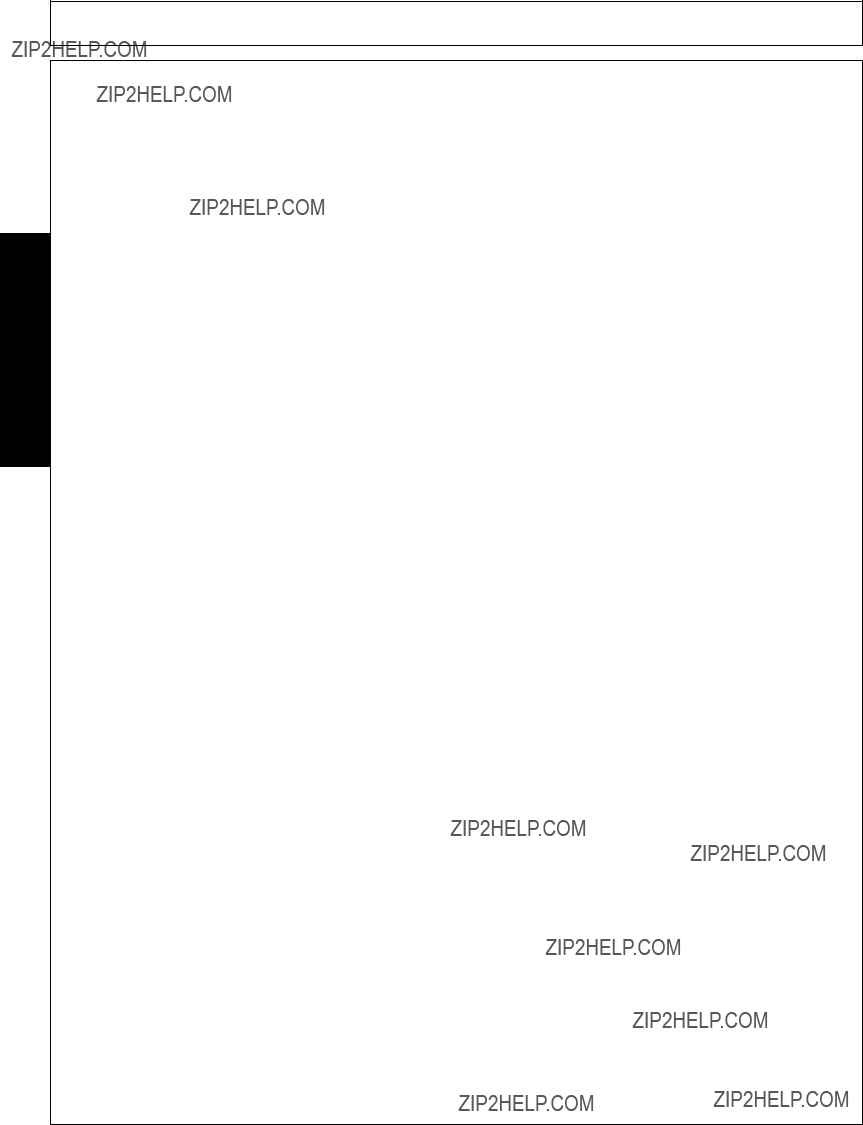
MAINTENANCE
STORAGE
Your rotary cutter represents an investment from which you should get the greatest possible benefit. Therefore, when the season is over, the cutter should be thoroughly checked and prepared for storage so that a minimum amount of work will be required to put it back into operation for the next season. The following are suggested storage procedures:
1.Thoroughly clean the cutter.
2.Lubricate the cutter as covered in Maintenance Section.
3.Tighten all bolts and pins to the recommended torque.
4.Check the cutter for worn or damaged parts. Make replacements immediately.
5.Store the cutter in a clean, dry place with the cutter housing resting on blocks.
6.Use spray touch-up enamel where necessary to prevent rust and maintain the appearance of the cutter.
PROPER TORQUE FOR FASTENERS
The chart lists the correct tightening torque for fasteners. When bolts are to be tightened or replaced, refer to this chart to determine the grade of bolts and the proper torque except when specific torque values are assigned in manual text.
RECOMMENDED TORQUE IN FOOT POUNDS UNLESS OTHERWISE STATED IN THE MANUAL*
NOTE: These values apply to fasteners as received from supplier, dry or when lubricated with normal engine oil. They do not apply if special graphited or molydisulphide greases or other extreme pressure lubricants are used. This applies to both UNF fine and UNC coarse threads.
?? 2011 Alamo Group Inc.
MAINTENANCE
MAINTENANCE
?? 2011 Alamo Group Inc.
MAINTENANCE
GEARBOX SERVICING
TOOLS NEEDED FOR DISASSEMBLY AND ASSEMBLY OF GEARBOX
MAINTENANCE
1.Slide Hammer Puller
2.Loctite #5900
3.Punch - Long Drift
4.Needle Nose Pliers
5.Screw Driver
6.Internal Snap Ring Pliers
7.Socket Wrench
8.13mm Socket
9.Ball Pin Hammer
10.Pry Bar
Be certain to clamp or securely support the gearbox and sub-assemblies to prevent injuries to hands and feet due to inadvertent dropping or falling over.
Always wear safety glasses and gloves to prevent eye and hand injury when chiseling or hammering on metal components. Hardened metal will chip unexpectedly.
An assembled gearbox is quite heavy. Use a hoist or get help to handle them safely. Lift carefully and properly using your legs to lift - not your back.
NOTICE: Refer to operator???s manual for instructions for proper re-assembly onto the mower deck. Tighten correctly.
?? 2011 Alamo Group Inc.

MAINTENANCE
PARTS INSPECTION
Inspect and clean all parts. Check bearings, shafts, gears, housing, and cover. Shafts should be inspected at seal wear areas, bearing areas, splines, and threads. Check housing for cracks and condition of threaded holes. If bearings are replaced always replace both cup and cone. Inspect gears for excessive wear on teeth, pitts, and gouges. Replace as necessary. always replace both gears for best performance. Check all seal bores for scratches or nicks which will damage seal when installed. File all damaged areas.
OUTPUT SHAFT INSTALLATION
1.Install shim kit (6) onto output shaft (20) and press bearing cone (7) under gear as far as possible.
2.Install both bearing cones (7) into housing. Insert output shaft into housing.
3.Install lower bearing cone (7) and locknut (8). tighten locknut until bearings are pre-loaded to 10 to 15 inch- pounds. Set lock portion of nut using punch. Drive or form lower portion of nut into groove in shaft. Nut must be locked or it will back off during operation. For added protection a thread locking compound may be added to nut during assembly. Mnt-R-0306
INPUT SHAFT INSTALLATION
1.Drop gear (17) into housing from top. Insert input shaft through housing and gear.
2.Place shim kit (14) and rear ball bearing onto shaft. Press bearing into housing and install retaining ring (2).
3.From opposite side of housing press bearing cone onto shaft against gear. Press bearing cup into housing. Install shim (5) and install retaining ring (2). If ring will not go into groove in housing remove shims until ring can be installed.
4.Tap on both ends of shaft to seat bearings. Grab spline end of shaft and exert a push and then pull force. If movement is observed shim (5) must be added. Repeat until no movement is observed.
5.Check gear backlash by grasping both shafts and then rotating one shaft back and forth so gear is hitting on one side and then the other. If no backlash is noted then shim (14) must be increased and shim (5) decreased by same amount. If dial indicator is available backlash can be measured by placing indicator on gear tooth through top cover opening. Backlash should be 0.015 to 0.020 inch. If excessive backlash is noted reverse procedure noted earlier. Mnt -R-0306
ASSEMBLY COMPLETION
1.Install input and output shaft seals. Use caution when installing to avoid damaging seal lip. Lubricate seal lip before installing.
2.Install rear input seal plug.
3.Set box upright and fill with proper amount of gear lube.
4.Install and seal with gasket sealer and top cover. torque bolts to proper torque. Gearbox assembly is complete.
?? 2011 Alamo Group Inc.
MAINTENANCE
BLADE SPINDLE INSTRUCTIONS
Mnt-R-0307
ASSEMBLY PROCEDURE
1.Loosen set screw (9) in adjusting nut (8).
2.Remove adjusting nut (8)
3.Support housing (6) flange and press or drive shaft assembly (7) from housing, taking care to prevent damage to the grease fitting (5) and shaft (7) threads.
4.Remove bearing cups (2) from housing.
5.Reinstall adjusting nut (8) on shaft and support shaft assembly (7) upside down against adjusting nut
6.Remove lower bearing cone (3) from shaft assembly by inserting a 3/16??? diameter drift punch through holes in seal protector (4) and driving bearing down until loose on the shaft
(7).
7.Remove adjusting nut(8) and continue driving bearing off the rest of the shaft (7).
?? 2011 Alamo Group Inc.
RHINO
LIMITED WARRANTY
1.LIMITED WARRANTIES
1.01.Rhino warrants for one year from the purchase date to the original non-commercial, governmental, or municipal purchaser (???Purchaser???) and warrants for six months to the original commercial or industrial purchaser (???Purchaser???) that the goods purchased are free from defects in material or workmanship.
1.02.Manufacturer will replace for the Purchaser any part or parts found, upon examination at one of its factories, to be defective under normal use and service due to defects in material or workmanship.
1.03.This limited warranty does not apply to any part of the goods which has been subjected to improper or abnormal use, negligence, alteration, modification, or accident, damaged due to lack of maintenance or use of wrong fuel, oil, or lubricants, or which has served its normal life. This limited warranty does not apply to any part of any internal combustion engine, or expendable items such as blades, shields, guards, or pneumatic tires except as specifically found in your Operator???s Manual.
1.04.Except as provided herein, no employee, agent, Dealer, or other person is authorized to give any warranties of any nature on behalf of Manufacturer.
2.REMEDIES AND PROCEDURES.
2.01.This limited warranty is not effective unless the Purchaser returns the Registration and Warranty Form to Manufacturer within 30 days of purchase.
2.02.Purchaser claims must be made in writing to the Authorized Dealer (???Dealer???) from whom Purchaser purchased the goods or an approved Authorized Dealer (???Dealer???) within 30 days after Purchaser learns of the facts on which the claim is based.
2.03.Purchaser is responsible for returning the goods in question to the Dealer.
2.04.If after examining the goods and/or parts in question, Manufacturer finds them to be defective under normal use and service due to defects in material or workmanship, Manufacturer will:
(a)Repair or replace the defective goods or part(s) or
(b)Reimburse Purchaser for the cost of the part(s) and reasonable labor charges (as determined by Manufacturer) if Purchaser paid for the repair and/or replacement prior to the final determination of applicability of the warranty by Manufacturer.
The choice of remedy shall belong to Manufacturer.
2.05.Purchaser is responsible for any labor charges exceeding a reasonable amount as determined by Manufacturer and for returning the goods to the Dealer, whether or not the claim is approved. Purchaser is responsible for the transportation cost for the goods or part(s) from the Dealer to the designated factory.
3.LIMITATION OF LIABILITY.
3.01.MANUFACTURER DISCLAIMS ANY EXPRESS (EXCEPT AS SET FORTH HEREIN) AND IMPLIED WARRANTIES WITH
RESPECT TO THE GOODS INCLUDING, BUT NOT LIMITED TO, MERCHANTABILITY AND FITNESS FOR A PARTICULAR
PURPOSE.
3.02.MANUFACTURER MAKES NO WARRANTY AS TO THE DESIGN, CAPABILITY, CAPACITY, OR SUITABILITY FOR USE OF
THE GOODS.
3.03.EXCEPT AS PROVIDED HEREIN, MANUFACTURER SHALL HAVE NO LIABILITY OR RESPONSIBILITY TO PURCHASER OR
ANY OTHER PERSON OR ENTITY WITH RESPECT TO ANY LIABILITY, LOSS, OR DAMAGE CAUSED OR ALLEGED TO BE
CAUSED DIRECTLY OR INDIRECTLY BY THE GOODS INCLUDING, BUT NOT LIMITED TO, ANY INDIRECT, SPECIAL,
CONSEQUENTIAL, OR INCIDENTAL DAMAGES RESULTING FROM THE USE OR OPERATION OF THE GOODS OR ANY
BREACH OF THIS WARRANTY. NOT WITHSTANDING THE ABOVE LIMITATIONS AND WARRANTIES, MANUFACTURER???S
LIABILITY HEREUNDER FOR DAMAGES INCURRED BY PURCHASER OR OTHERS SHALL NOT EXCEED THE PRICE OF
THE GOODS.
3.04.NO ACTION ARISING OUT OF ANY CLAIMED BREACH OF THIS WARRANTY OR TRANSACTIONS UNDER THIS
WARRANTY MAY BE BROUGHT MORE THAN TWO (2) YEARS AFTER THE CAUSE OF ACTION HAS OCCURRED.
4.MISCELLANEOUS.
4.01.Proper Venue for any lawsuits arising from or related to this limited warranty shall be only in Guadalupe County, Texas.
4.02.Manufacturer may waive compliance with any of the terms of this limited warranty, but no waiver of any terms shall be deemed to be a waiver of any other term.
4.03.If any provision of this limited warranty shall violate any applicable law and is held to be unenforceable, then the invalidity of such provision shall not invalidate any other provisions herein.
4.04.Applicable law may provide rights and benefits to purchaser in addition to those provided herein.
KEEP FOR YOUR RECORDS
ATTENTION: Purchaser should fill in the blanks below for his reference when buying repair parts and/or for proper machine identification when applying for warranty.
TO THE OWNER/OPERATOR/DEALER
In addition to the standard Limited Warranty shown on the facing page, Rhino also provides:
A FIVE-YEAR (60 months) LIMITED WARRANTY* on GEARBOX components provided they have been properly maintained??? and have not been subjected to abuse or mis-use except as limited below.
* WARRANTY LIMITATIONS - GEARBOX
A)Warranty is ONE-YEAR (12 MONTHS) for Seals (After one year, seals are considered to be WEARING PARTS and replacement is the users' responsibility.)
B)Users' Gearboxes may be rebuilt by Rhino or replaced by new or rebuilt Gearboxes at the option of Rhino.
??? NOTE - "properly maintained" specifically includes, but is not limited to:
A)Running Gearboxes with the proper amount of the correct lubricant.
B)Adjusting Slip Clutches correctly to provide proper protection for Driveline and Gearbox Components.
C)Properly lubricate all driveline components as specified.
D)Maintaining proper bearing preload on all gearbox shaft.
To keep your implement running efficiently and safely, read your manual thoroughly and follow these directions and the Safety Messages in this Manual. The Table of Contents clearly identifies each section where you can easily find the information you need.
The OCCUPATIONAL SAFETY AND HEALTH ACT (1928.51 Subpart C) makes these minimum safety requirements of tractor operators:
REQUIRED OF THE OWNER:
1.Provide a Roll-Over-Protective Structure that meets the requirements of this Standard; and
2.Provide Seat belts that meet the requirements of this paragraph of this Standard and SAE J4C; and
3.Ensure that each employee uses such Seat belt while the tractor is moving; and
4.Ensure that each employee tightens the Seat belt sufficiently to confine the employee to the protected area provided by the ROPS
REQUIRED OF THE OPERATOR:
1.Securely fasten seat belt if the tractor has a ROPS.
2.Where possible, avoid operating the tractor near ditches, embankments, and holes.
3.Reduce speed when turning, crossing slopes, and on rough, slick, or muddy surfaces.
4.Stay off slopes too steep for safe operation.
5.Watch where you are going - especially at row ends, on roads, and around trees.
6.Do not permit others to ride.
7.Operate the tractor smoothly - no jerky turns, starts, or stops.
8.Hitch only to the drawbar and hitch points recommended by the tractor manufacturer.
9.When the tractor is stopped, set brakes securely and use park lock, if available.
TM60/72/84/100
REAR DISCHARGE
FINISHING MOWERS


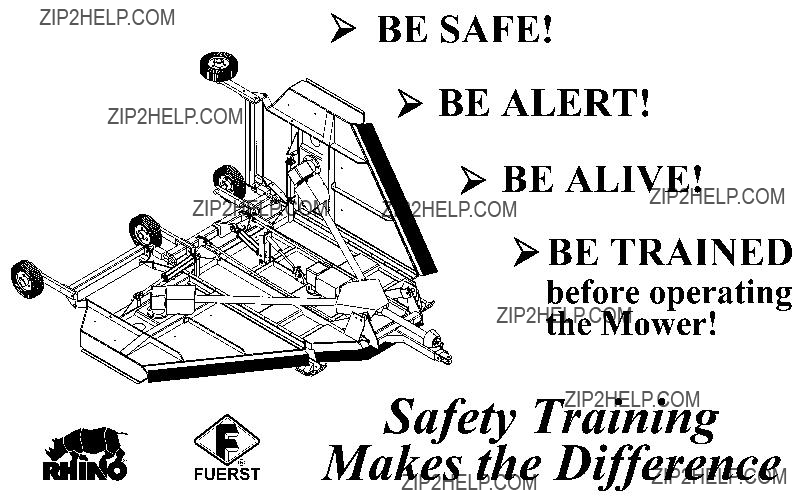












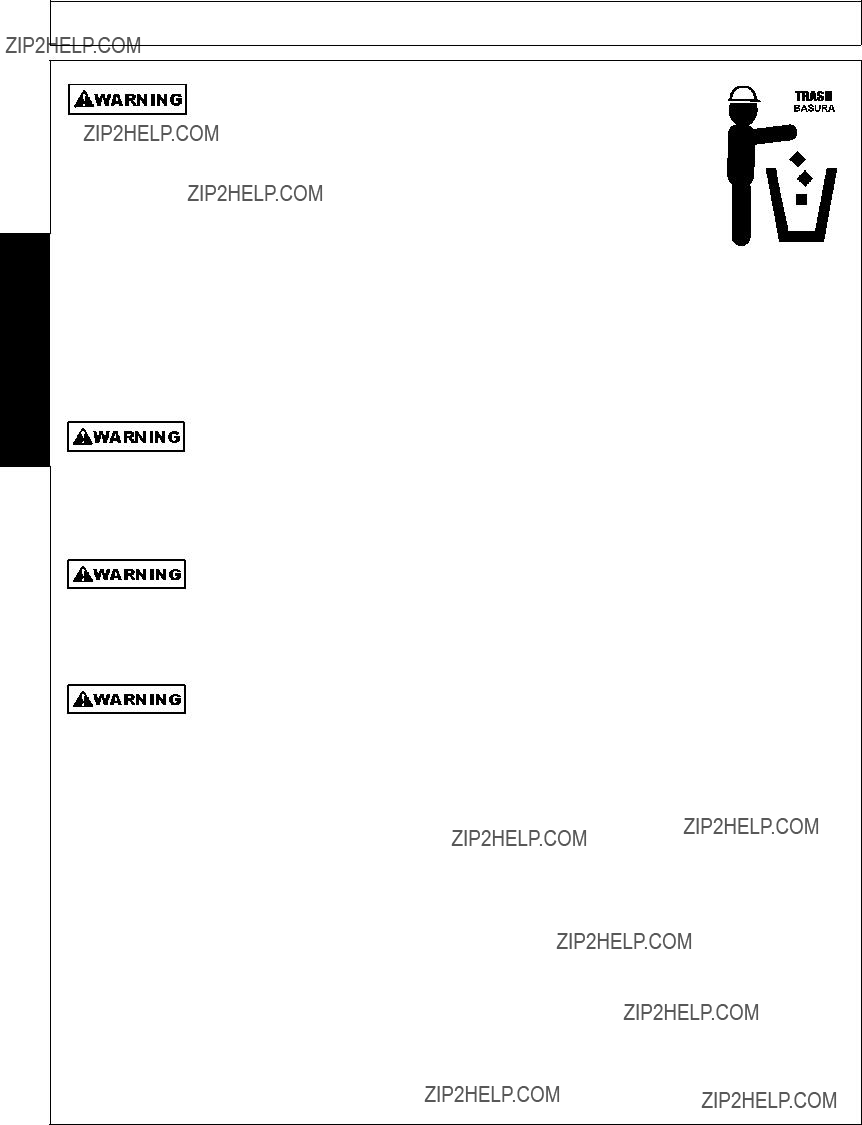





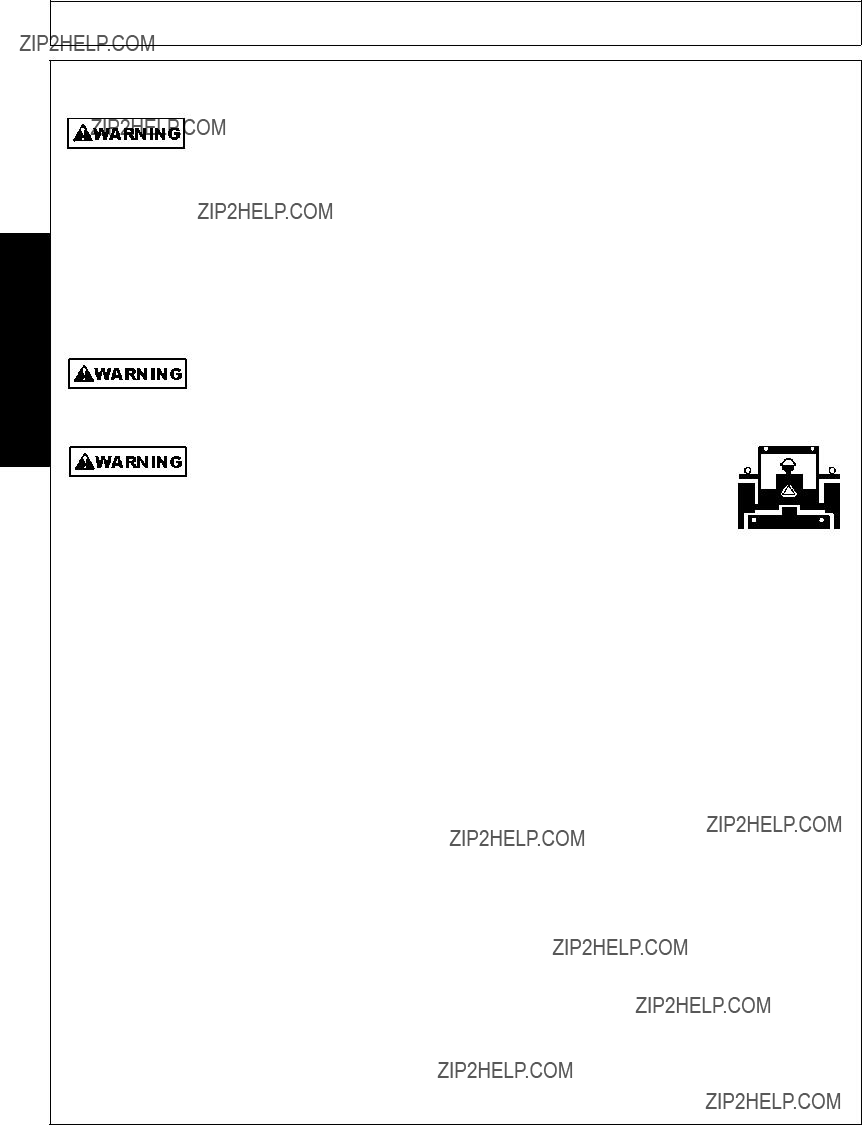









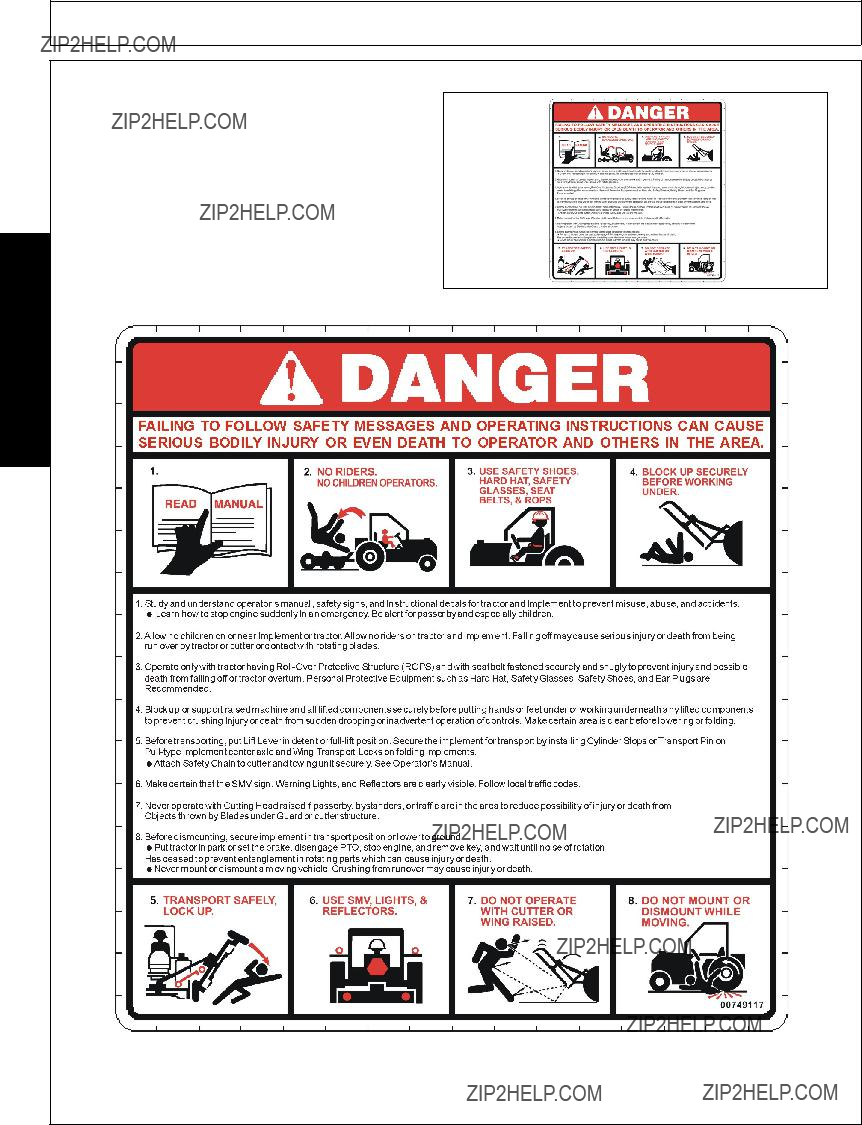



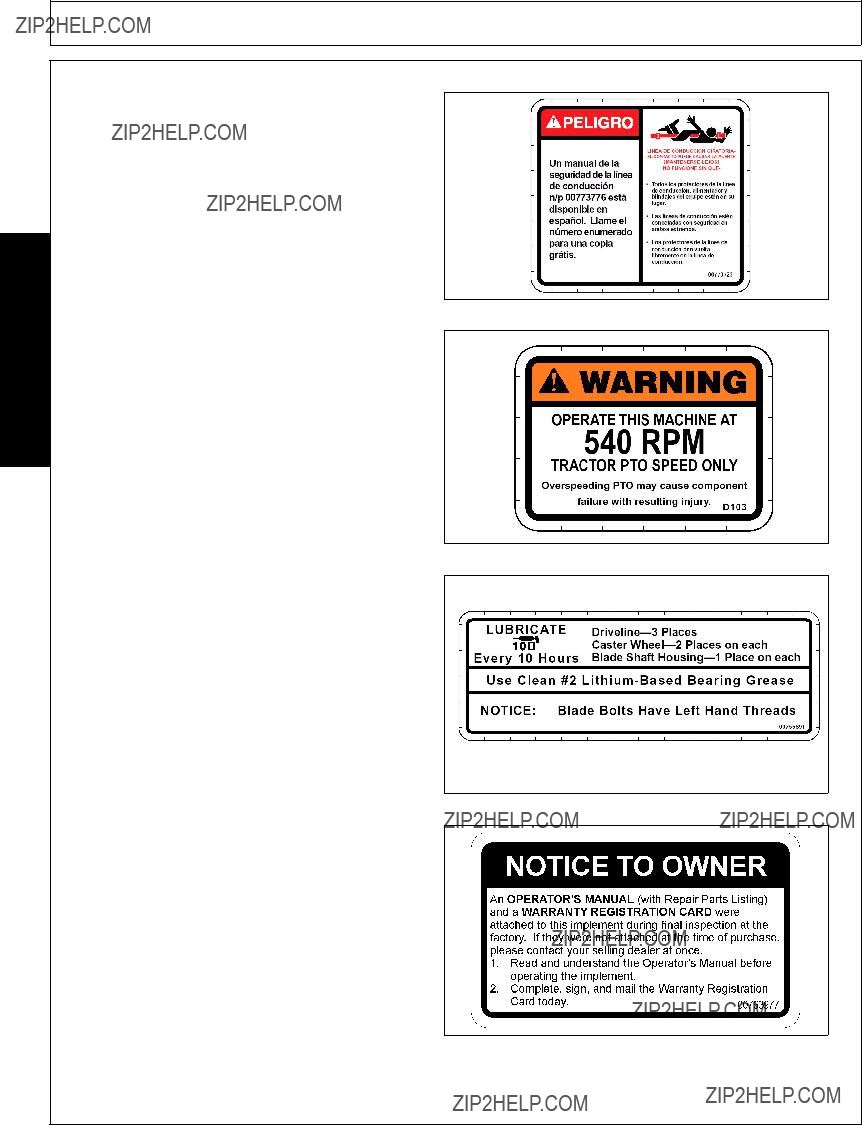
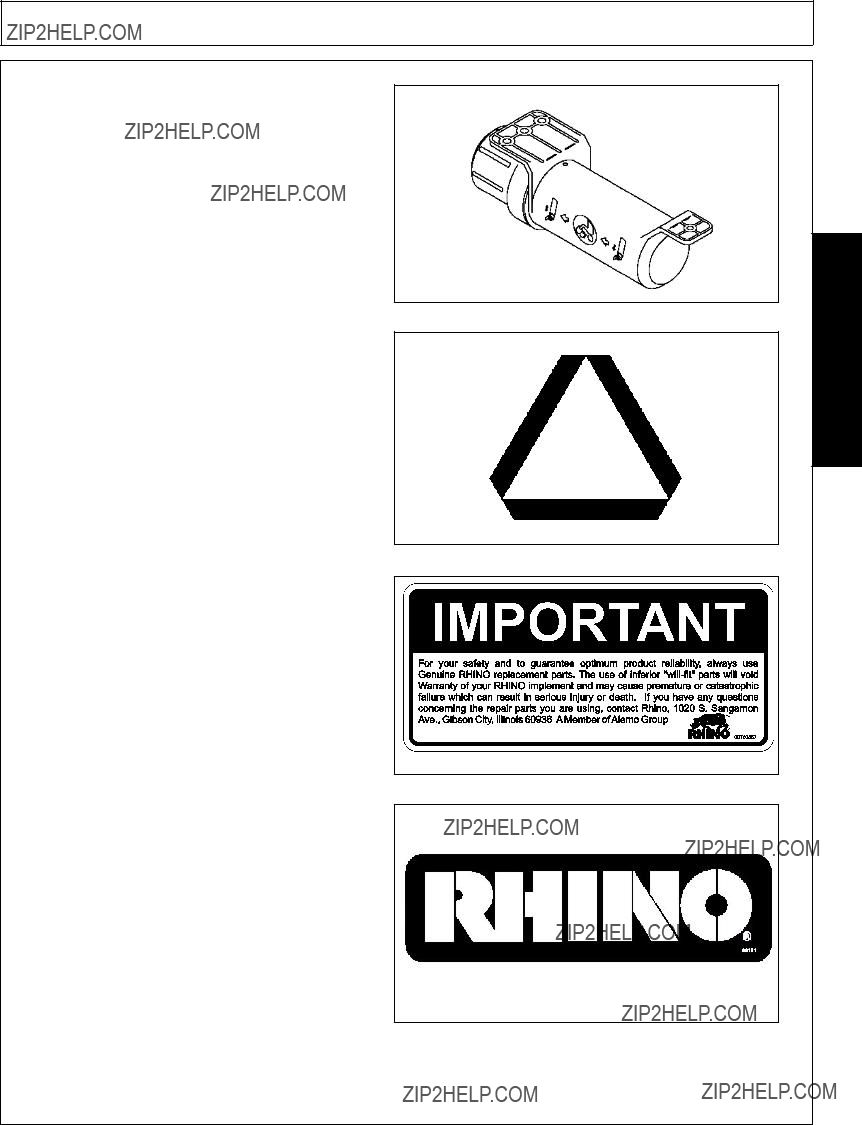






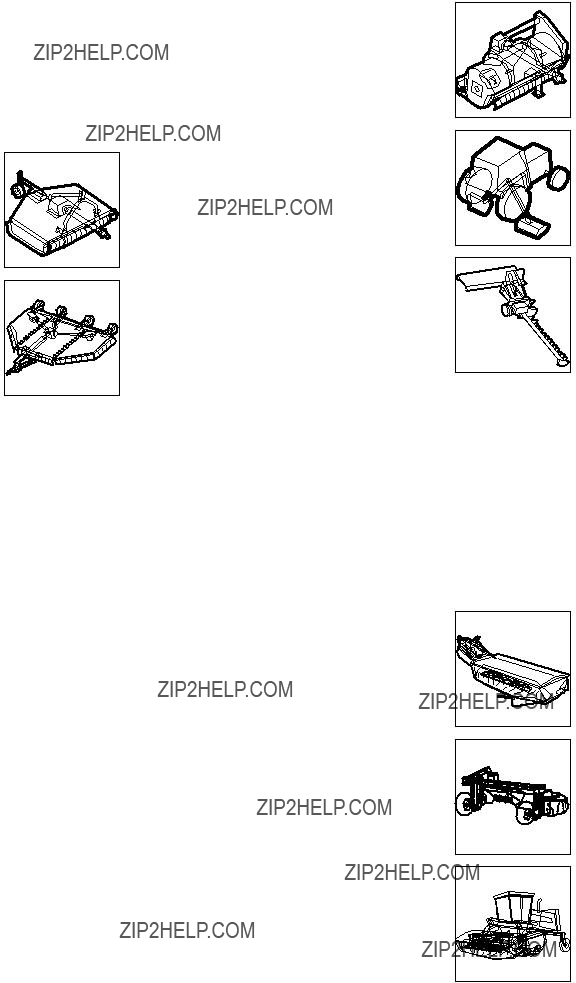




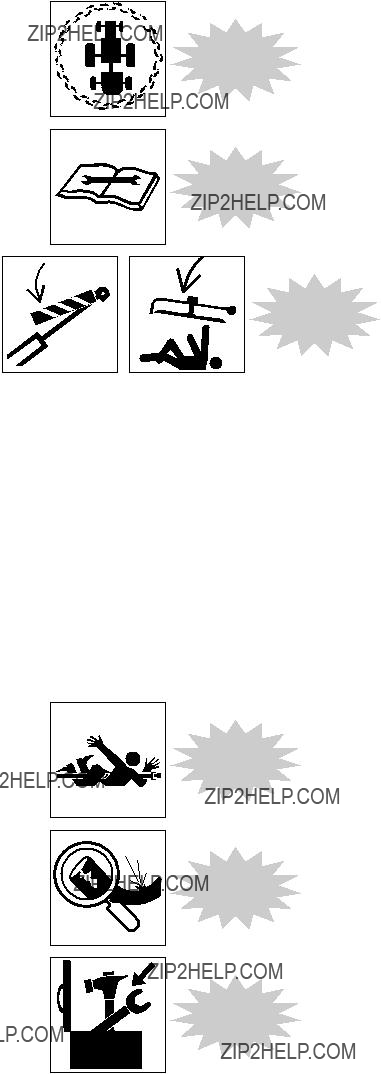
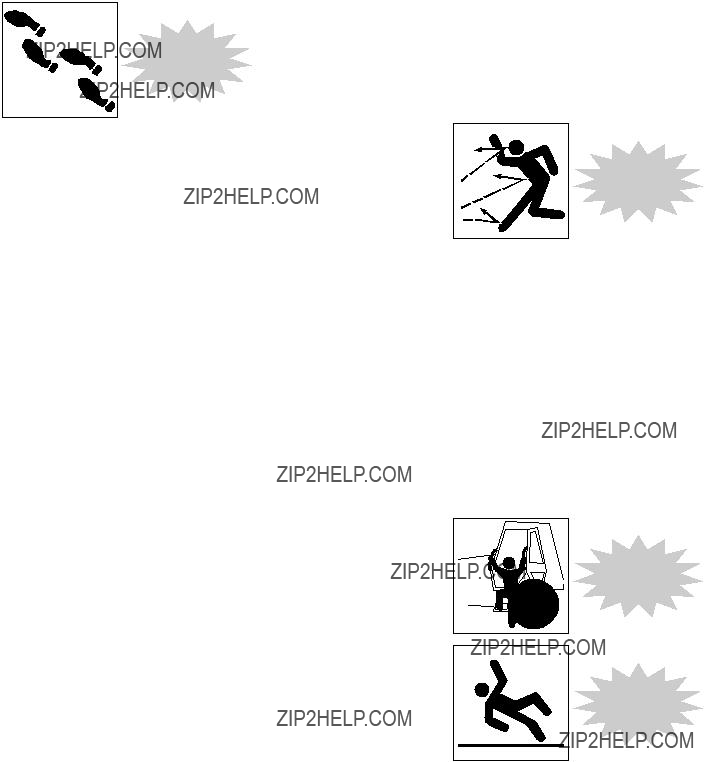

















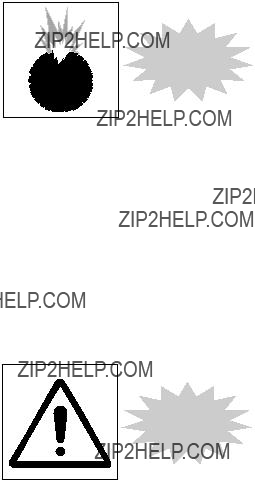





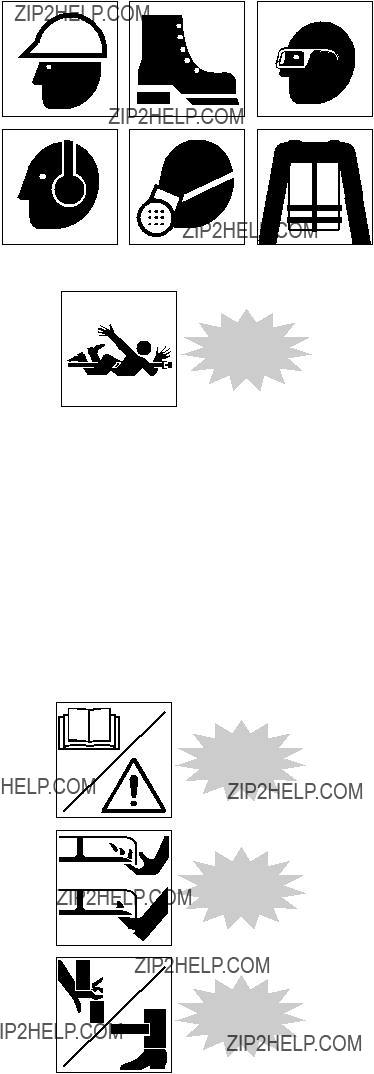
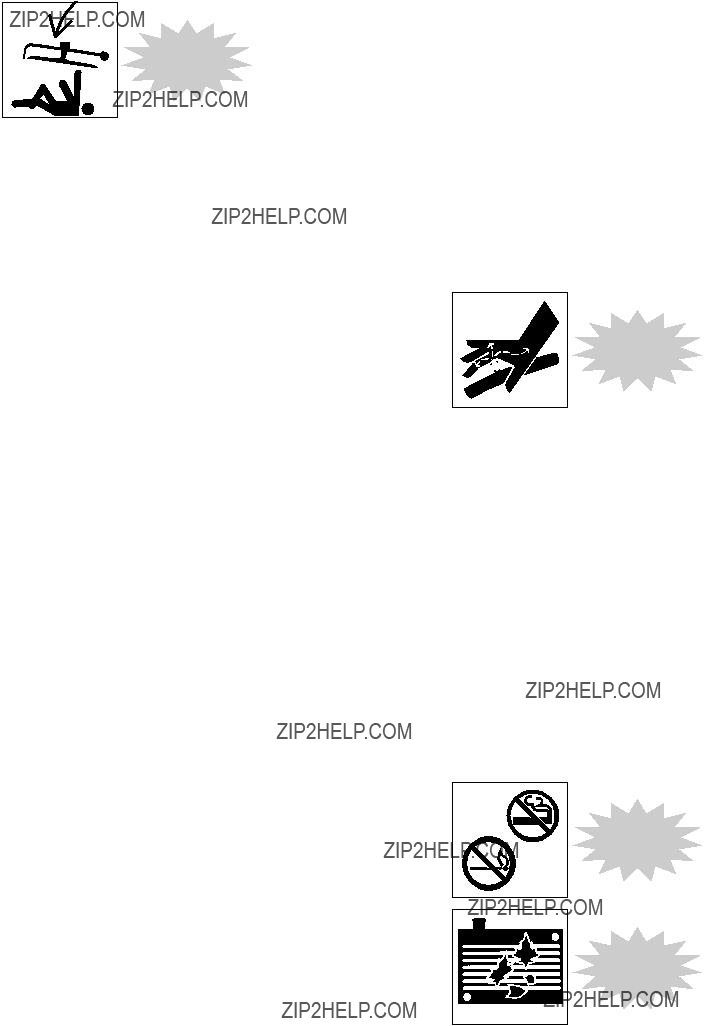
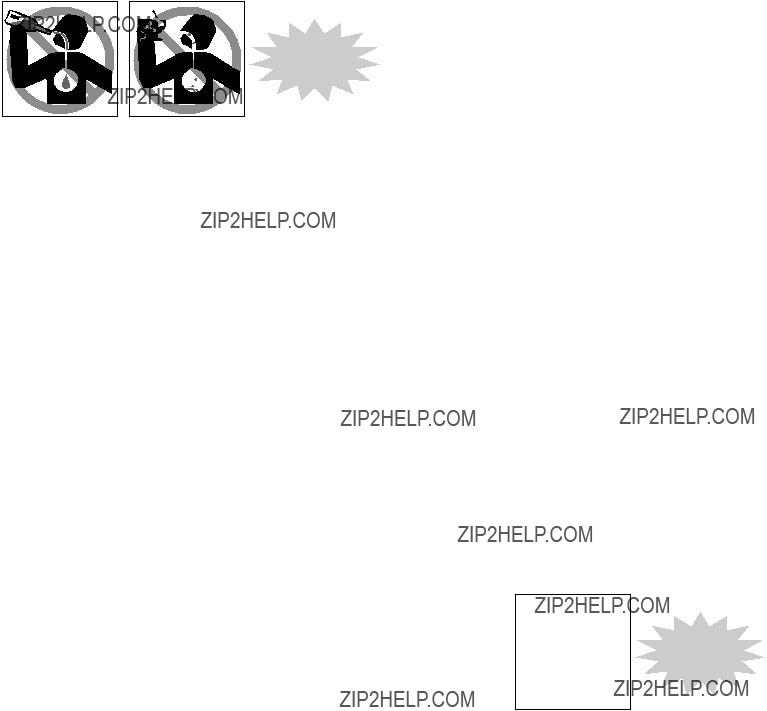





 PULG
PULG






